Fix pipeline pains. Solve GTM puzzles. And read strategic brain dump.
.jpg)
Factors.ai vs Gojiberry: Best AI GTM Tool for Scalable Revenue
If you’ve ever been in a GTM meeting where five dashboards are open, three people are talking at once, and someone says,
“Okay but… what actually moved pipeline this month?”… you already know where this is going.
Website traffic is up.
LinkedIn replies look decent.
Sales says conversations feel “warmer.”
CRM data is… let’s not talk about the CRM.
And yet, nobody can confidently answer whether any of this activity will turn into revenue, or if we’re all just professionally busy (and traumatized).
This is usually the moment teams start Googling things like “AI GTM tools”, “intent data platforms”, or “something that makes this mess make sense.”
That’s where Factors.ai and Gojiberry tend to show up in the same shortlist.
At first glance, they feel similar. Both talk about intent. Both use AI agents. Both promise to help your GTM team move faster and catch buying signals before competitors do. On paper, it looks like you’re choosing between two flavours of the same solution… except one sounds like an exotic ice-cream flavour… (I’m obviously talking about Factors.ai… what did you think?!)
Okay, let’s get back… now, once you get past the landing pages and into how these tools actually work day-to-day, the difference becomes pretty obvious.
Gojiberry is built for LinkedIn-led outbound. It monitors signals such as role changes, funding announcements, and competitor engagement, then helps sales teams jump into conversations while the lead is still scrolling.
Factors.ai looks at the chaos and says, “Cool, but buyers don’t live on one channel.” It pulls intent from your website, ads, CRM, product usage, and platforms like G2, then connects all of it into one journey… so marketing, sales, and RevOps are finally looking at the same story.
So this isn’t really a debate about which tool is ‘better.’
It’s about whether your GTM motion is:
- starting conversations fast, or
- building a system that turns signals into predictable revenue
If you’re trying to decide between Factors.ai and Gojiberry, this guide breaks down how they actually behave in the wild… what they’re great at, where they stop helping, and which kind of GTM team they’re built for. Get the full ‘scoop’ here (or a double-scoop?).
Let’s get into it.
TL;DR
- Gojiberry is ideal for LinkedIn-centric sales teams needing fast, affordable outreach automation. It’s built for startups and outbound-heavy workflows with minimal setup.
- Factors.ai delivers multi-source intent capture, full-funnel analytics, ad activation, and enterprise-ready compliance, best for scaling teams needing structure and visibility across GTM.
- Analytics is where they split: Gojiberry tracks replies and leads; Factors.ai attributes pipeline to campaigns, stages, and signals.
- Choose Gojiberry if your GTM motion lives in LinkedIn DMs.
- Choose Factors.ai if you want to operationalize a full-stack GTM engine.
Factors.ai vs Gojiberry: Functionality and Features
When evaluating GTM platforms, the first question most teams ask is: what can this tool actually do for me? On the surface, both Factors.ai and Gojiberry are intent-led tools, but their depth of functionality reveals very different approaches.
Most intent-led platforms stop at visibility. They’ll tell you who’s out there, but the heavy lifting of turning those signals into pipeline still falls on your team. The real differentiator is not just what you see, but what you can do once you’ve seen it. This is where Factors.ai and Gojiberry diverge.
Factors.ai vs Gojiberry: Functionality and Features Comparison Table
Factors.ai Functionality and Features
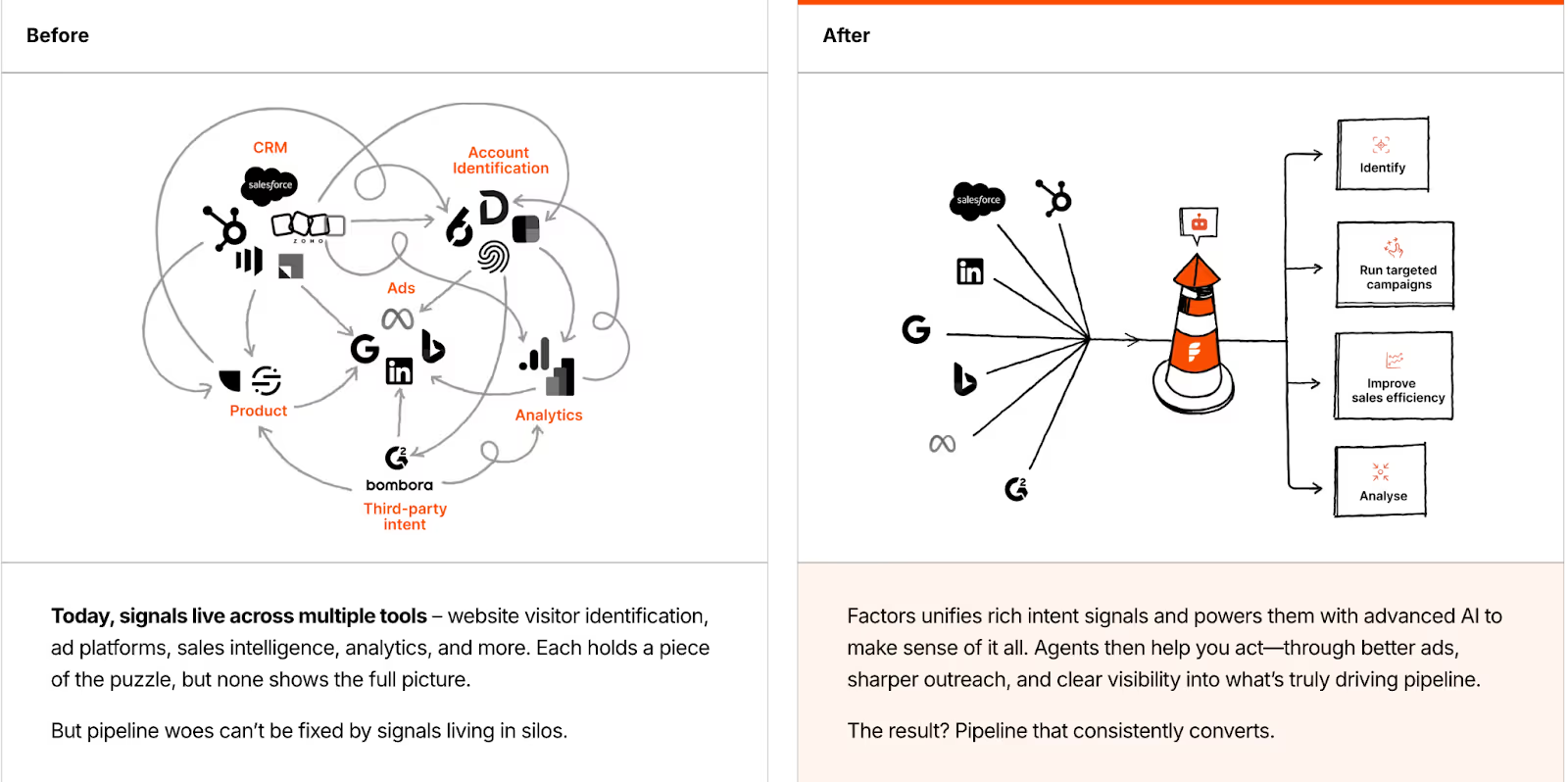
Factors.ai positions itself as more than just a signal-capturing tool, it’s an orchestration engine. Instead of feeding you raw data, it structures the entire buyer journey and enables activation at every step.
Key capabilities include:
- Multi-Source Intent Capture: Pulls data from website visits, ad clicks, CRM stages, product usage, and review platforms like G2.
- Visitor Identification: Identifies up to 75% of anonymous visitors using multi-source enrichment (Clearbit, 6sense, Demandbase, etc.).
- Customer Journey Timelines: Creates unified timelines that map every touchpoint across channels into a single, coherent story.
- AI-Powered Agents: Handle account scoring, surface buying groups, suggest next best actions, and even support multi-threaded outreach strategies.
- Ad Platform Integrations: Native sync with LinkedIn and Google Ads lets you activate intent signals in real time.
- Real-Time Alerts: Sends high-context Slack notifications for critical moments (e.g., demo revisit, pricing page view, form drop-off).
In short, Factors.ai highlights your warmest leads and guides you on the following steps to maximize their potential.
Gojiberry Functionality and Features
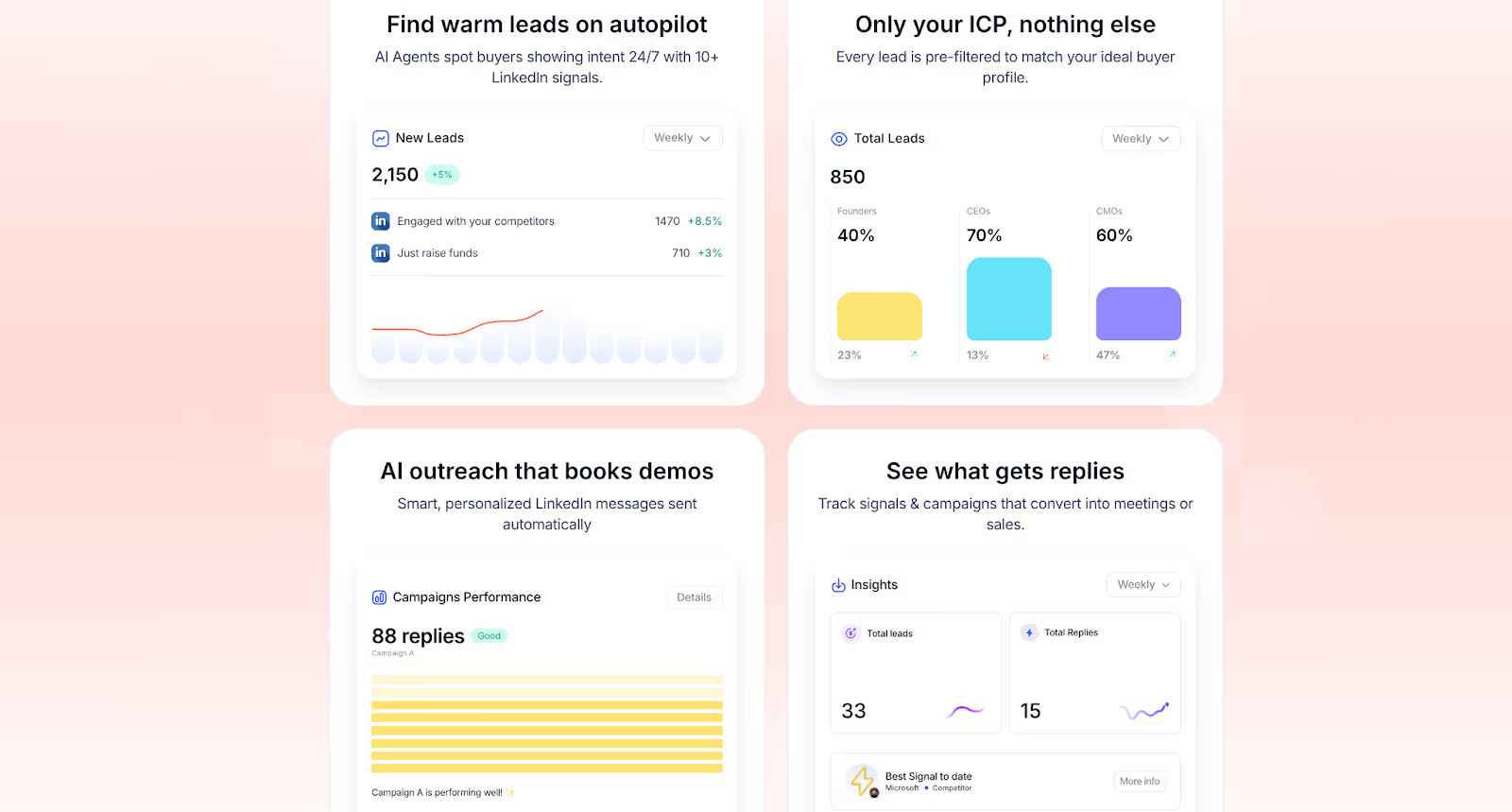
Gojiberry takes a narrower, but highly focused approach. Instead of multi-channel orchestration, it goes deep into LinkedIn as the single source of truth for GTM signals.
Key capabilities include:
- LinkedIn Signal Tracking: Monitors 10+ LinkedIn intent signals such as competitor engagement, funding rounds, new roles, and content interactions.
- Always-On AI Agents: Run 24/7 to spot new leads that match your ICP and surface them before competitors do.
- Automated Outreach: Launches personalized LinkedIn campaigns at scale, reducing manual prospecting effort.
- Performance Metrics: Provides weekly counts of new leads, reply rates, and campaign-level results.
- Integrations: Syncs with Slack for real-time notifications and connects with CRMs like HubSpot and Pipedrive.
Where Factors.ai orchestrates multiple channels, Gojiberry specializes in making LinkedIn-led outbound as efficient as possible.
Factors.ai vs Gojiberry: Verdict on Functionality and Features
Gojiberry shines when your GTM motion is LinkedIn-first and you need a fast, efficient way to identify warm prospects and automate outreach. It’s focused, lightweight, and designed for outbound-heavy teams.
Factors.ai, on the other hand, extends far beyond lead discovery. By combining multi-source intent signals, unified customer journeys, and AI-driven orchestration, it functions as a true GTM command center. Instead of just finding leads, it equips your team to nurture, activate, and convert them across the funnel.
In short:
- Gojiberry = LinkedIn discovery & outreach tool.
- Factors.ai = full-funnel GTM orchestration platform.
Factors.ai vs Gojiberry: Pricing
Pricing is often where teams start their evaluation, but it’s also where many make the mistake of comparing numbers instead of value per dollar. A lower monthly fee doesn’t necessarily translate into cost efficiency if the tool requires you to buy multiple add-ons or still leaves gaps in your GTM motion.
Both Factors.ai and Gojiberry take very different approaches to pricing, reflective of the problems they aim to solve.
Factors.ai vs Gojiberry: Pricing Comparison Table
Factors.ai Pricing
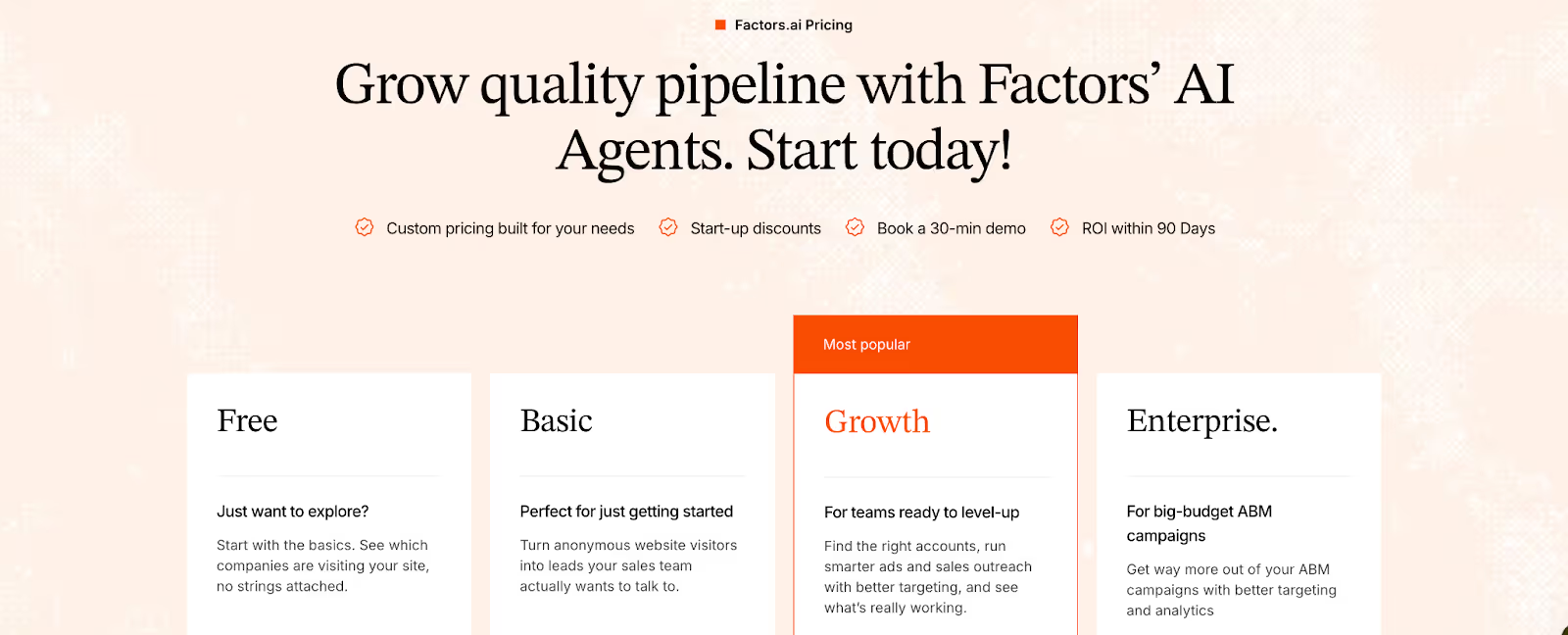
Factors.ai is not just another point tool; it is a platform, and that philosophy is reflected in its pricing.
- Factors.ai offers a free plan with limited features.
- Moving on, even the base package includes capabilities that typically require multiple point tools stitched together:
- Visitor identification with up to 75%+ accuracy using waterfall enrichment (Clearbit, 6sense, Demandbase).
- Contact enrichment via integrations (Apollo, ZoomInfo, Clay).
- CRM sync & account scoring based on ICP fit, funnel stage, and engagement intensity.
- AI agents that research accounts, surface contacts, generate outreach insights, and support multi-threading.
- Slack alerts triggered by high-intent actions.
- Native ad activation on LinkedIn and Google Ads (with audience sync and conversion feedback).
- Full-funnel analytics & attribution dashboards to tie activity to pipeline and revenue.
- Optional GTM Engineering Services
For teams with limited RevOps bandwidth, Factors offers a service layer at an additional cost. This includes:- Custom ICP modeling and playbook design.
- Set up enrichment, alerts, and ad activation workflows.
- SDR enablement: post-meeting alerts, closed-lost reactivation, and buying group mapping.
- Ongoing reviews, optimization, and documentation of the GTM motion.
Takeaway: While Factors.ai’s entry point is higher, the scope is significantly broader. Instead of buying a visitor ID tool, a LinkedIn retargeting tool, a separate attribution platform, and an enrichment service, you get it all in one system. The additional GTM Engineering Services make Factors not just a tool, but an extension of your team.
Read more about the pricing tiers.
Gojiberry Pricing

Gojiberry keeps things straightforward with a seat-based model.
- Pro Plan - $99/month per seat
Designed for startups, founders, and lean sales teams looking for predictable pipeline through LinkedIn-led outbound. It includes:- Tracking of 15+ LinkedIn intent signals (e.g., funding rounds, competitor engagement, role changes, event activity).
- Connection of one LinkedIn account.
- Running of unlimited LinkedIn campaigns.
- AI-powered outreach with basic lead scoring.
- CRM & API integrations (HubSpot, Pipedrive, etc.).
- 100 verified emails included per month.
- Elite Plan - Custom Pricing
Built for scaling teams needing more seats and deeper integrations. It includes everything in Pro, plus:- Tracking of unlimited intent signals.
- A dedicated Customer Success Manager (CSM).
- SLA guarantees for support and uptime.
- Support for +10 additional seats.
- Deeper integrations across the stack.
- Higher volumes of phone and email credits.
Takeaway: Gojiberry’s pricing is attractive to small teams looking for affordability and ease of entry. But its value is tied closely to LinkedIn-based workflows. If your GTM play relies on multi-channel activation (ads, website, CRM, product signals), you’ll need to supplement it with additional tools.
Factors.ai vd Gojiberry: Verdict on Pricing
If you’re an early-stage startup or a lean sales team, Gojiberry offers a low-cost, low-barrier entry into AI-driven LinkedIn outreach. For $99/month per seat, you can uncover warm signals and start conversations quickly.
But if you’re evaluating true cost vs. value, Factors.ai offers more ROI at scale. At $416/month, you consolidate multiple workflows, visitor ID, enrichment, ad sync, analytics, and attribution, into one platform. Plus, with GTM Engineering Services, you’re not just buying software; you’re investing in an operating system for revenue.
In short:
- Gojiberry = affordable outreach assistant.
- Factors.ai = GTM platform that scales with you.
Factors.ai vs Gojiberry: Analytics and Attribution
Seeing who’s engaging is one thing. Proving which efforts actually drive pipeline and revenue is another. This is where Factors.ai and Gojiberry diverge sharply.
Factors.ai vs Gojiberry: Analytics and Attribution Comparison Table
Factors.ai Analytics and Attribution
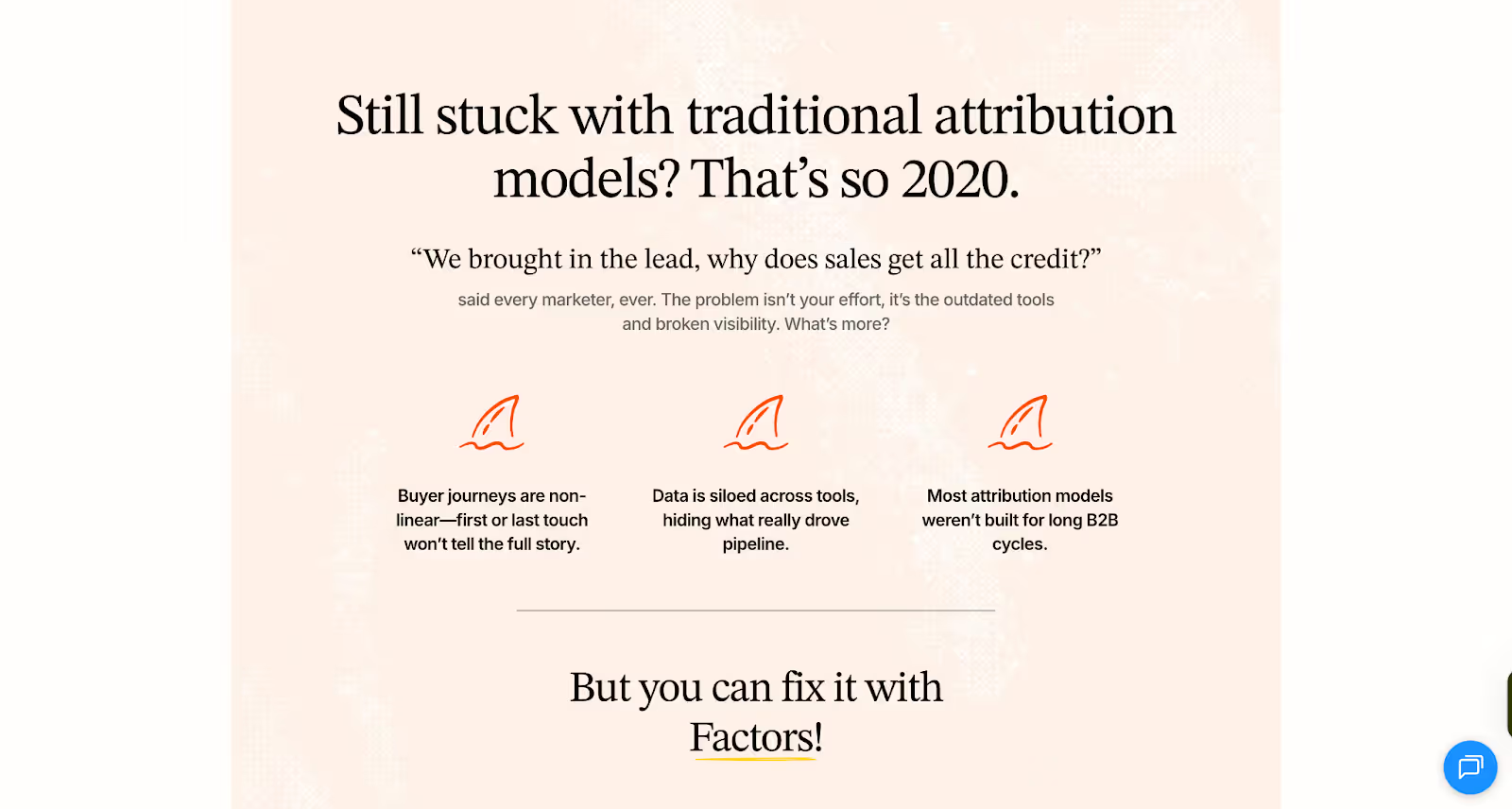
Factors.ai was built from the ground up as a full-funnel analytics and attribution platform. Instead of stopping at replies or meetings booked, it connects every touchpoint to pipeline outcomes.
Key analytics capabilities include:
- Multi-Touch Attribution
- Stitch together interactions across web, ads, product usage, CRM, and G2.
- Attribute pipeline and revenue back to specific channels and campaigns.
- Answer questions like: “Did LinkedIn or Google Ads influence this deal more?”
- Funnel Stage Analytics
- Track movement from MQL → SQL → Opportunity → Closed Won.
- Identify which campaigns or signals accelerate progression, and where drop-offs happen.
- Customer Journey Timelines
- Unified, chronological view of every action an account has taken.
- See how anonymous visits, ad clicks, demos, and nurture campaigns map into deals.
- Segmentation & Custom Dashboards
- Break down performance by geography, ICP fit, industry, product line, or segment.
- Compare campaigns across personas or buyer stages.
- Drop-Off & Bottleneck Detection
- Visualize where accounts fall out of the funnel.
- Spot “silent churn” signals like demo visits with no follow-up.
- AI-Powered Insights (coming soon)
- Ask natural language questions like: “Which campaign influenced the most revenue last quarter?” without digging through dashboards.
With Factors, analytics aren’t just about visibility, they’re about actionable GTM strategy.
Gojiberry Analytics and Attribution
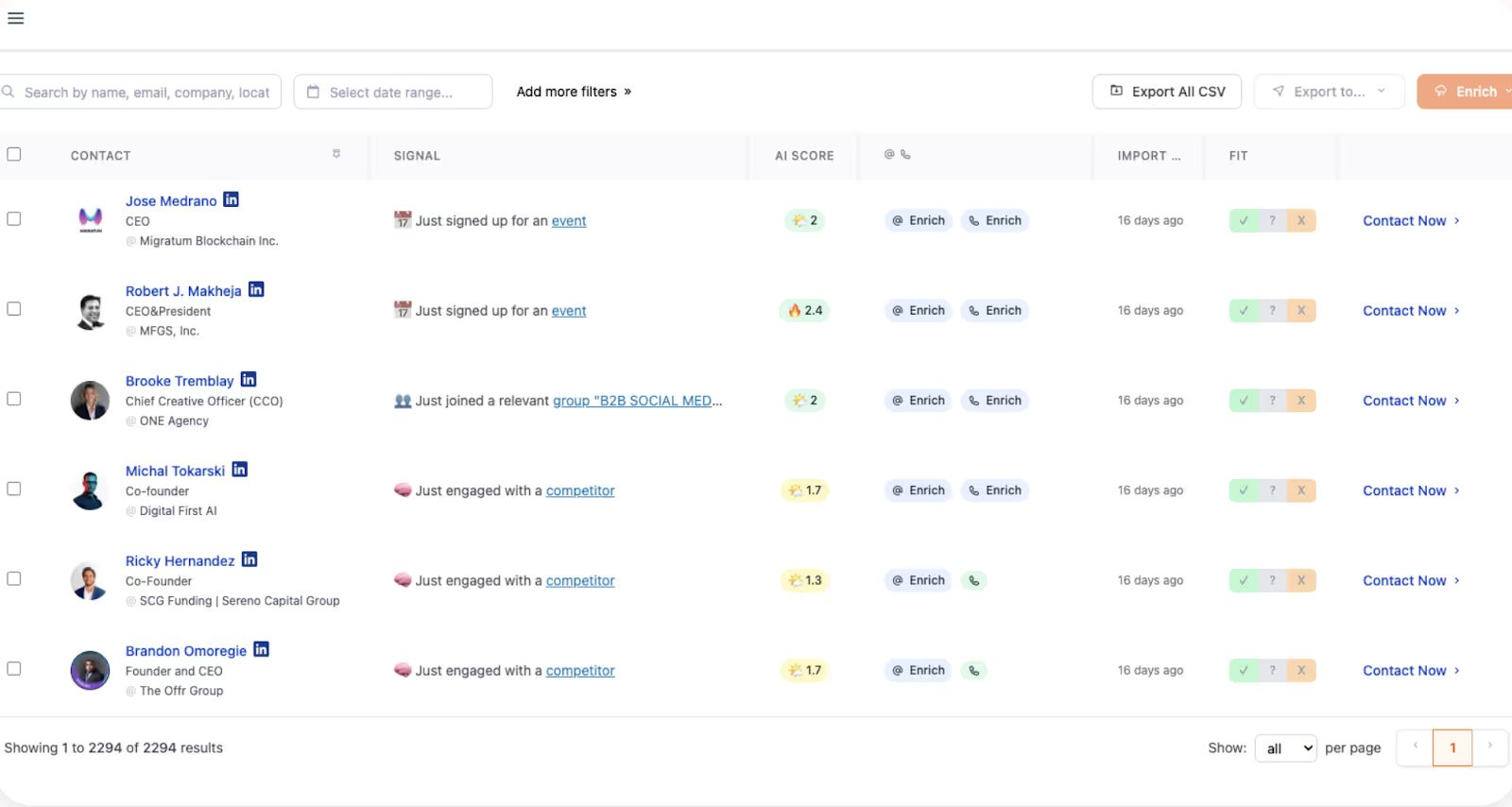
Gojiberry’s analytics stay close to its core use case: LinkedIn-led outreach. The platform is optimized to show you which signals and campaigns generated responses, and how your outreach is performing week over week.
Key analytics capabilities include:
- Campaign Performance Metrics
- Reply rates broken down by campaign (e.g., Campaign A: 18%, Campaign B: 27%).
- Weekly counts of leads generated and replies received.
- Signal-Level Insights
- See which LinkedIn triggers (competitor engagement, new funding, new roles, etc.) yielded the most conversations.
- Spot top-performing signals like “Engaged with your competitors” or “Recently raised funds.”
- Basic CRM/Slack Integration Reporting
- Track which signals or campaigns convert into meetings.
- Push lead data into CRM tools for follow-up.
- Real-Time Alerts
- Notifications in Slack when new warm leads are uncovered, with basic context about the signal.
In other words, Gojiberry tells you:
- “This signal is working.”
- “This campaign got replies.”
- “Here are the warm leads to follow up with.”
But what it doesn’t do is tie those interactions to broader GTM outcomes. You won’t see multi-touch attribution, funnel progression, or which channels (beyond LinkedIn) contribute to revenue.
Factors.ai vs Gojiberry: Verdict on Analytics & Attribution
Gojiberry does its job well: it shows you which LinkedIn signals get the most replies, which campaigns are working, and when new warm leads appear. That’s useful for small teams focused on direct outbound outreach.
But if you’re a GTM team looking to justify spend, optimize campaigns, and scale pipeline predictably, Factors.ai is in another league. It gives you the ability to prove which touchpoints created revenue, not just which messages got replies.
In short:
- Gojiberry = outreach analytics.
- Factors.ai = revenue analytics.
Factors.ai vs Gojiberry: Ad Activation and Retargeting
Intent signals are only half the battle. The real question is: how quickly and effectively can your team act on those signals? That’s where the differences between Factors.ai and Gojiberry become clearest.
Factors.ai vs Gojiberry: Ad Activation and Retargeting Comparison Table
Factors.ai Ad Activation and Retargeting
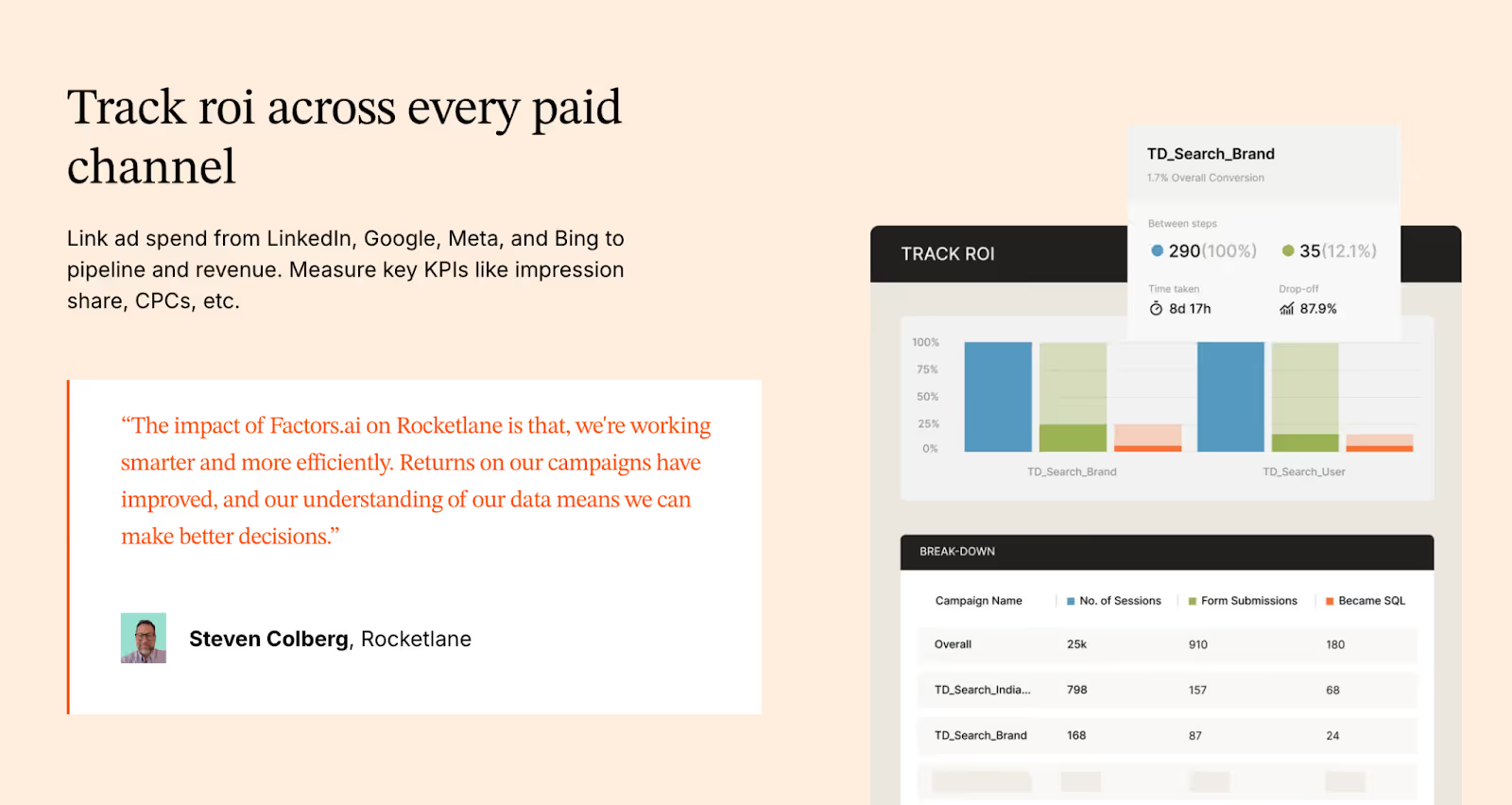
Factors.ai, on the other hand, treats ad activation as a core GTM motion. The platform is an official partner for LinkedIn and Google, which means it doesn’t just tell you who’s ready to buy, it helps you reach them instantly with the right ads.
Key ad activation capabilities include:
- Real-Time LinkedIn Audience Syncs
- Automatically build and refresh audiences based on ICP fit, funnel stage, or recent engagement.
- Keep ad campaigns aligned with buying signals, no more manual CSV uploads.
- Google Ads Integration
- Retarget accounts who’ve clicked high-value terms, visited competitor pages, or engaged with your site.
- Feed conversion data back to Google via CAPI, making every ad impression smarter.
- Conversion Feedback Loops
- If your SDRs mark a lead as high-quality, Factors sends that feedback into LinkedIn and Google Ads.
- This ensures platforms optimize toward the accounts most likely to convert.
- Impression & Budget Control
- Control ad frequency at the account level.
- Avoid overserving a handful of accounts while starving others.
- Cross-Signal Retargeting
- Retarget not just website visitors, but also accounts showing intent via G2, product usage, or CRM activity.
This creates a closed-loop system: intent signals → dynamic audiences → optimized ads → enriched pipeline.
Gojiberry Ad Activation

Gojiberry is designed around LinkedIn outreach automation, not paid media orchestration. Its activation layer is focused on:
- AI-Powered LinkedIn Messaging
- Automatically sends personalized LinkedIn messages to warm leads.
- Templates can be customized, but the workflow is largely centered around direct outreach.
- Slack Notifications
- When new warm leads are discovered, teams get real-time alerts in Slack.
- This ensures SDRs can jump into outreach quickly.
- Basic Campaign Tracking
- Performance measured in reply rates and lead responses.
What Gojiberry does not provide:
- No integration with LinkedIn Ads or Google Ads for audience targeting.
- No dynamic audience syncs.
- No ability to retarget based on multi-source signals (website visits, CRM stage, G2 engagement).
- No feedback loops from sales activity back into ad platforms.
In short, Gojiberry’s “activation” is outreach-only. It’s effective for teams running heavy outbound on LinkedIn, but it doesn’t extend into paid media channels.
Factors.ai vs Gojiberry: Onboarding and Support
A tool is only as effective as your team’s ability to use it. Onboarding and ongoing support are what determine whether software turns into real pipeline impact or just another unused subscription.
Here again, Factors.ai and Gojiberry take very different approaches.
Factors.ai vs Gojiberry: Onboarding and Support Comparison Table
Factors.ai Onboarding and Support
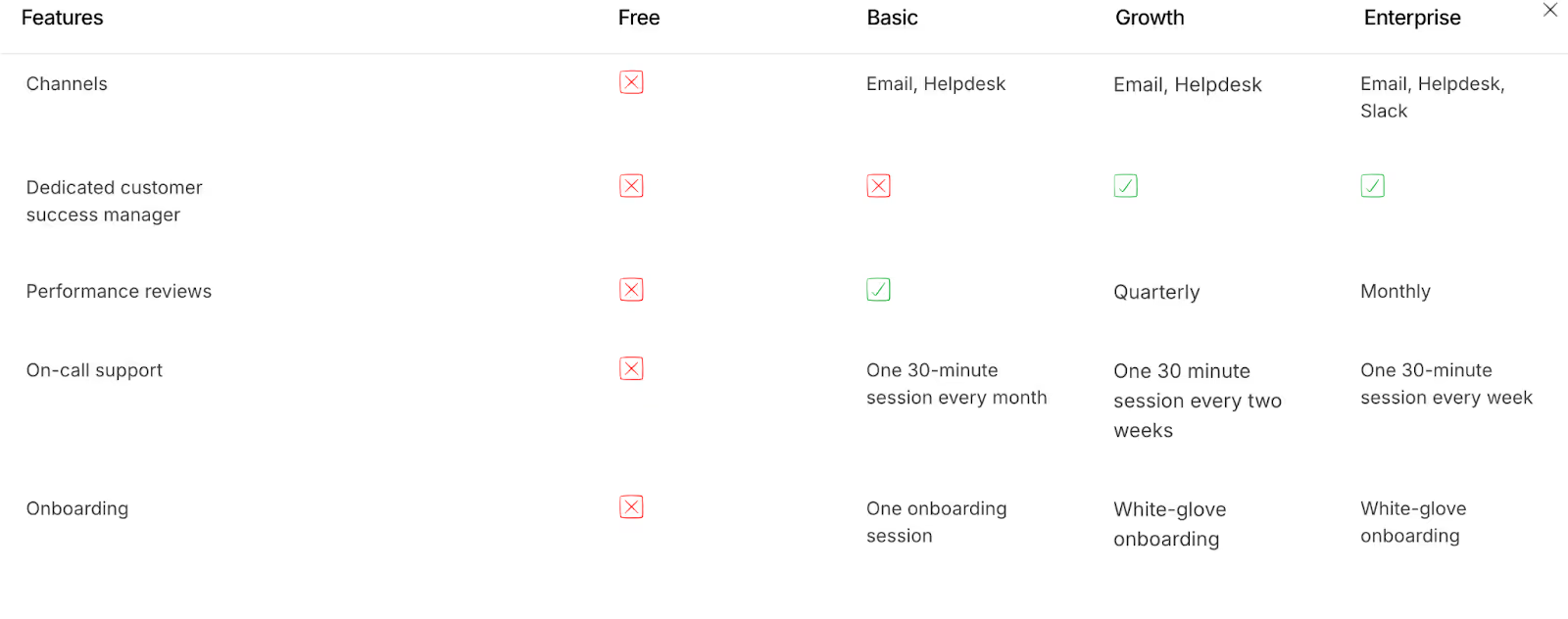
Factors.ai takes a very different approach. Instead of a plug-and-play install, the onboarding is positioned as a partnership to build your GTM motion (can vary based on plans).
Here’s what you get:
- White-Glove Onboarding
- Setup is tailored to your ICP, funnel stages, and sales/marketing workflows.
- No cookie-cutter playbooks; the onboarding aligns Factors to your GTM strategy.
- Dedicated Slack Channel
- Customers get a direct line to their CSM and solutions engineers via Slack.
- This means real-time troubleshooting and collaboration, not waiting for tickets to be resolved.
- Weekly Strategy Reviews
- Regular syncs to review adoption, optimize workflows, and align analytics with business outcomes.
- Goes beyond product training, it’s about pipeline generation strategy.
- GTM Engineering Services (Optional)
- For teams short on RevOps bandwidth, Factors offers services at $4,000 setup + $300/month.
- Includes:
- Automated enrichment flows.
- Ad audience syncs for LinkedIn & Google.
- Real-time SDR alerts (e.g., demo revisits, form drop-offs).
- Closed-lost reactivation workflows.
- Buying group mapping and multi-threading setups.
- Full documentation and handover so your internal team can eventually run independently.
The result is a support model that’s not just about getting the tool working, but about operationalizing a revenue system.
Gojiberry Onboarding and Support

Gojiberry is designed to get you up and running quickly, with minimal friction. The onboarding process is straightforward:
- Simple Account Setup
- Create an account in seconds, connect your LinkedIn profile, and start tracking signals.
- Create an account in seconds, connect your LinkedIn profile, and start tracking signals.
- Quick Activation
- Pick the intent signals you want AI agents to monitor (e.g., funding rounds, new roles, competitor engagement).
- Launch your first LinkedIn outreach campaigns almost immediately.
- Slack Alerts for Warm Leads
- Once configured, your team gets daily Slack notifications with newly discovered warm leads.
In terms of support, Gojiberry provides:
- CRM & API integrations with tools like HubSpot and Pipedrive.
- Email and support documentation for basic setup assistance.
- A dedicated Customer Success Manager (CSM) available only on the Elite plan, along with SLA guarantees for larger customers.
The trade-off? While Gojiberry is fast to set up, the support is primarily tactical. It helps you connect the tool and interpret signal reports, but doesn’t go deep into GTM workflows, sales enablement, or long-term strategy.
Factors.ai vs Gojiberry: Verdict on Onboarding and Support
If you want to start sending LinkedIn messages tomorrow, Gojiberry makes onboarding effortless. Within minutes, you can be tracking signals and automating outreach. For small teams or outbound-heavy founders, this speed is a real advantage.
But if your team needs end-to-end GTM orchestration, Factors.ai is the safer bet. Its onboarding is not just about installing software, it’s about building a sustainable motion. With Slack collaboration, weekly strategy calls, and optional GTM engineering, Factors.ai acts less like a vendor and more like an extension of your GTM team.
In short:
- Gojiberry = fast, tactical onboarding.
- Factors.ai = strategic, long-term GTM partnership.
Factors.ai vs Gojiberry: Compliance and Security
For modern B2B SaaS companies, compliance is not optional. If you’re selling into mid-market or enterprise accounts, your buyers’ procurement teams will scrutinize your data policies, certifications, and security practices before signing a deal.
This is an area where the differences between Factors.ai and Gojiberry become especially clear.
Factors.ai vs Gojiberry: Compliance and Security Comparison Table
Factors.ai Compliance and Security
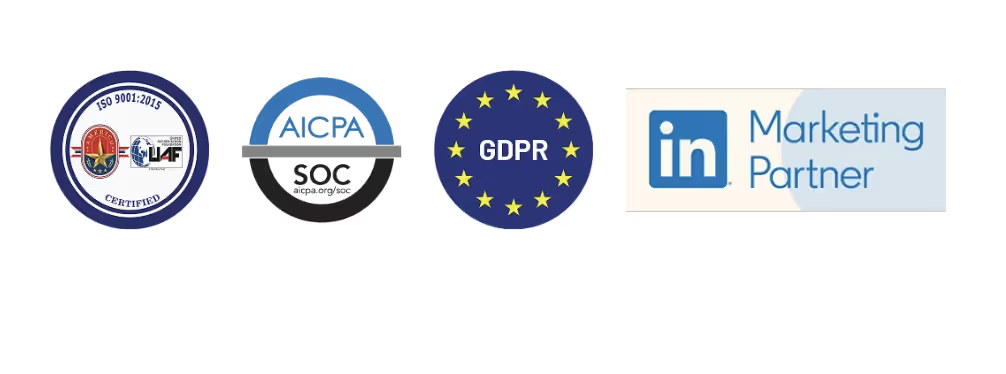
Factors.ai, by contrast, positions security as a foundational pillar of the platform. For GTM teams selling into enterprise accounts, this assurance is crucial.
Key compliance highlights:
- GDPR & CCPA Compliant
- Ensures compliance with both EU and US data privacy standards.
- Ensures compliance with both EU and US data privacy standards.
- ISO 27001 Certified
- Globally recognized standard for information security management.
- Globally recognized standard for information security management.
- SOC 2 Type II Certified
- Validates the platform’s security, availability, and confidentiality practices via third-party audit.
- Validates the platform’s security, availability, and confidentiality practices via third-party audit.
- Privacy-First Enrichment
- Uses firmographic and behavioral data without invasive user fingerprinting or non-transparent enrichment methods.
- Uses firmographic and behavioral data without invasive user fingerprinting or non-transparent enrichment methods.
- Data Processing Agreements (DPAs)
- Available for customers who require legal documentation for data handling.
This makes Factors.ai not just safe for enterprise buyers, but also procurement-ready. Security reviews that might delay smaller tools often get cleared faster when certifications like SOC 2 and ISO 27001 are already in place.
Gojiberry Compliance and Security
Gojiberry’s website highlights product capabilities, pricing, and integrations, but there’s very little publicly available information about its compliance framework or certifications. Based on what’s shared:
- GDPR and CCPA Alignment
- Gojiberry states alignment with GDPR, ensuring basic data privacy for European users.
- It also mentions compliance with the CCPA, which gives California residents rights over their personal data.
- No Published Certifications
- Gojiberry provides some visibility into data enrichment methods (public sources and third-party services) and outlines security controls (encryption, firewalls, anomaly detection).
- However, it does not disclose storage locations or list industry certifications like SOC 2 or ISO 27001.
- Data Handling Transparency
- Limited visibility into how lead data is enriched or how AI agents process intent signals.
- No publicly available DPA (Data Processing Agreement).
Implication: For smaller startups or early-stage sales teams, this may not be a deal-breaker. But for regulated industries (finance, healthcare, enterprise SaaS), the lack of certifications could raise red flags in security reviews and slow down procurement cycles.
Factors.ai vs Gojiberry: Verdict on Compliance and Security
Gojiberry covers the basics for GDPR compliance, which may be sufficient for smaller startups or founder-led teams experimenting with LinkedIn outreach. But it lacks the certifications and transparency required by enterprise buyers.
Factors.ai, on the other hand, checks every compliance box, from GDPR and CCPA to SOC 2 Type II and ISO 27001. For GTM teams targeting mid-market or enterprise customers, this level of security isn’t just a nice-to-have; it’s table stakes.
In short:
- Gojiberry = startup-friendly, minimal compliance.
- Factors.ai = enterprise-grade security, procurement-ready.
Factors.ai vs Gojiberry: When to choose what?
Both Factors.ai and Gojiberry are AI-powered GTM tools designed to make revenue teams faster, smarter, and more effective. But while they may appear to solve the same problem at a glance, the reality is that they’re optimized for very different GTM motions.
When to Choose What
When Factors.ai Makes Sense
Factors.ai is a better fit if your GTM team is:
- Multi-channel and scaling: You need intent signals from multiple sources (website, ads, CRM, product usage, G2) stitched into one view.
- Focused on revenue, not just replies: You want to connect signals and campaigns directly to pipeline and closed-won deals.
- Running paid media: With LinkedIn and Google Ads integrations, you can activate dynamic audiences in real time and optimize spend.
- Enterprise or mid-market facing: Security certifications (SOC 2, ISO 27001, GDPR, CCPA) make procurement frictionless.
- Resource-constrained on RevOps: With GTM Engineering Services, you can outsource playbook design, workflow automation, and analytics setup.
For scaling GTM teams, Factors.ai is more than just a tool. It’s a GTM operating system, one that identifies, scores, activates, and attributes accounts across the funnel.
When Gojiberry Makes Sense
Gojiberry is a great fit if your team is:
- Small and outbound-heavy: Founders, SDRs, and lean sales teams looking to maximize LinkedIn prospecting.
- Focused on LinkedIn-led workflows: If most of your GTM strategy relies on LinkedIn signals like role changes, funding announcements, and competitor engagement.
- Looking for affordability: At $99/seat/month, Gojiberry makes AI-driven warm lead discovery accessible without a heavy investment.
- Needing quick setup: You can be up and running with LinkedIn outreach campaigns within a day.
For these teams, Gojiberry is an efficient outreach assistant; it finds warm LinkedIn leads and automates messages to help book meetings faster.
In a Nutshell
If you’re an early-stage founder or SDR team whose GTM strategy is almost entirely LinkedIn-driven, Gojiberry is a cost-effective way to find warm leads and automate outreach. It’s lightweight, affordable, and gets you moving fast.
But if you’re looking to scale pipeline predictably, with multi-channel orchestration, enterprise-grade security, and full-funnel analytics, Factors.ai is the clear choice. It doesn’t just help you find leads, it helps you build a connected GTM system that turns signals into revenue.
In short:
- Gojiberry = outreach assistant.
- Factors.ai = revenue engine.
FAQs for Factors vs Gojiberry
Q. What is the main difference between Factors.ai and Gojiberry?
The biggest difference is scope. Gojiberry is built for LinkedIn-led outbound and focuses on spotting warm signals and automating outreach quickly. Factors.ai is designed as a full-funnel GTM platform that unifies intent from your website, ads, CRM, product usage, and third-party sources, then helps you activate and measure that intent across the entire revenue journey.
Q. Is Gojiberry only useful for LinkedIn outreach?
Yes, and that’s intentional. Gojiberry is optimized for LinkedIn workflows, tracking role changes, funding updates, competitor engagement, and content interactions, then turning those signals into outreach. If LinkedIn is the core of your GTM strategy, Gojiberry fits naturally. It’s not built for paid ads, website intent, or multi-channel attribution.
Q. Can Factors.ai replace multiple GTM tools?
In many cases, yes. Factors.ai combines visitor identification, enrichment, account scoring, ad audience sync, attribution, and analytics into one platform. Teams often use it instead of stitching together separate tools for intent data, retargeting, enrichment, and attribution.
Q. Which platform is better for early-stage startups?
Gojiberry is often a better fit for early-stage or founder-led teams running outbound-heavy motions. It’s affordable, quick to set up, and helps teams start conversations fast without a complex RevOps setup. Factors.ai tends to make more sense once teams start scaling and need tighter alignment across sales, marketing, and analytics.
Q. Does Factors.ai support LinkedIn and Google Ads?
Yes. Factors.ai is an official partner for both LinkedIn and Google Ads. It allows real-time audience syncs, conversion feedback loops, and retargeting based on multi-source intent signals, not just website visits.
Q. Can Gojiberry run paid ad campaigns?
No. Gojiberry focuses on outreach automation, not paid media. It does not sync audiences to LinkedIn Ads or Google Ads and does not support retargeting or ad optimization workflows.
Q. How does attribution differ between Factors.ai and Gojiberry?
Gojiberry tracks outreach performance through replies, meetings, and campaign-level engagement. Factors.ai offers full multi-touch attribution, connecting interactions across web, ads, CRM, product, and third-party platforms to pipeline and revenue.
Q. Is Factors.ai suitable for enterprise and mid-market teams?
Yes. Factors.ai is designed for teams selling into mid-market and enterprise accounts. It supports complex GTM motions, multi-channel activation, and enterprise security requirements like SOC 2 Type II and ISO 27001.
Q. What kind of onboarding can I expect with each platform?
Gojiberry offers fast, lightweight onboarding so teams can start outreach quickly. Factors.ai provides white-glove onboarding, Slack-based collaboration, weekly strategy reviews, and optional GTM engineering services to help teams operationalize their GTM motion.
Q. Do both platforms support CRM integrations?
Yes. Both integrate with CRMs like HubSpot and Pipedrive. Factors.ai offers deeper native CRM sync, account scoring, and funnel-stage analytics, while Gojiberry focuses on pushing discovered leads and outreach activity into the CRM.
Q. Which platform should I choose if my GTM strategy evolves over time?
If you expect your GTM motion to stay LinkedIn-first and outbound-heavy, Gojiberry works well. If you expect to add paid media, inbound intent, product-led signals, or need stronger attribution and analytics as you scale, Factors.ai is built to grow with that complexity.

Factors.ai vs Madison Logic: Which ABM Tool Fits Your B2B Team?
If you’ve worked in B2B marketing long enough, you’ve probably sat through that meeting.
The one where marketing says, “Traffic is up.”
Sales says, “Cool, but none of these accounts are replying.”
Someone shares a dashboard. Someone else shares another dashboard.
And by the end of it, everyone agrees to “revisit attribution next quarter.”
I’ve been in those rooms… more times than I’d like to admit.
Intent signals are everywhere today. Website visits, LinkedIn clicks, content downloads, review site activity. The problem isn’t access to data anymore. The problem is figuring out which signals actually mean something… and which ones are just noise wearing a KPI costume.
That’s exactly where platforms like Factors.ai and Madison Logic enter the conversation.
On the surface, they both promise smarter account-based marketing. Identify in-market accounts. Activate campaigns. Prove impact. Tie marketing to revenue. The usual wishlist.
But once you get past the feature lists and sales decks, you realize they’re built for very different kinds of GTM teams, with very different definitions of “what good looks like.”
In this comparison, I’m breaking down how Factors.ai and Madison Logic differ across functionality, pricing, integrations, intent intelligence, activation, analytics, and support, not in theory, but in how they actually show up inside real GTM workflows.
If you’re trying to decide which platform fits your team, your maturity, and your tolerance for duct-taped dashboards… this one’s for you.
Factors.ai vs Madison Logic: Functionality and Features
For most B2B marketers, the real difference between ABM platforms comes down to how much they can actually do: how well they connect intent, engagement, and action.
Both Factors.ai and Madison Logic help teams identify in-market accounts and engage them across channels, but the way they deliver those capabilities reflects two very different philosophies.
Let’s compare their core GTM functionalities side by side.
Factors.ai vs Madison Logic: Functionality and Features Comparison Table
Factors.ai’s Functionality and Features
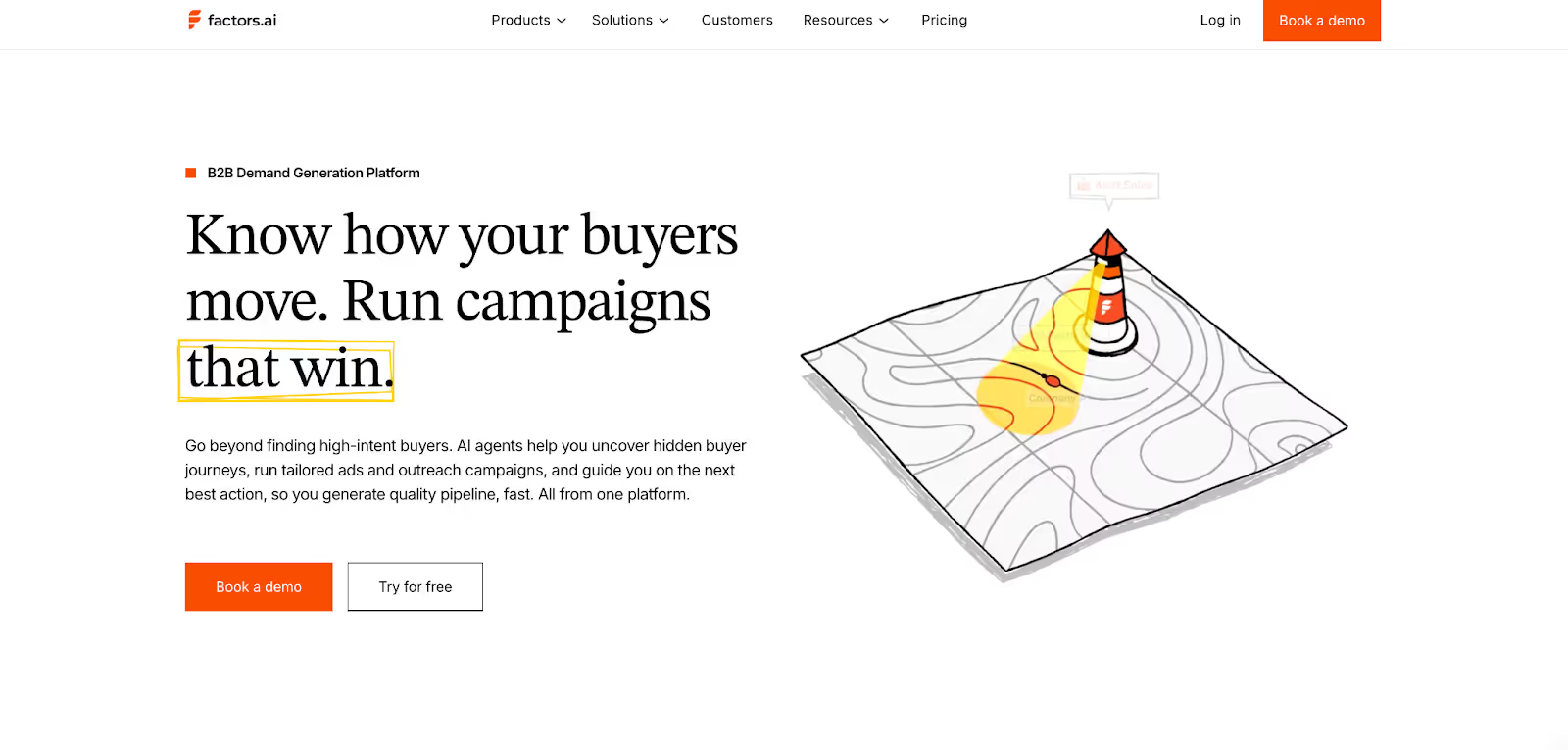
Factors.ai is designed to function as a single GTM command center.
Its strength lies in how it combines account identification, scoring, analytics, and activation under one workflow. The system captures signals across web, CRM, and product interactions, enriching them with external intent data to create a complete account story.
Key capabilities include:
- Account360 to unify engagement data across every channel.
- AI-powered scoring that identifies high-intent, sales-ready accounts.
- Dynamic ad activation via LinkedIn and Google AdPilot.
- Milestones analytics to connect top-of-funnel engagement with pipeline outcomes.
- Real-time AI alerts that prompt timely follow-ups.
For teams seeking both intelligence and activation within one ecosystem, Factors.ai offers an integrated, AI-led experience built for precision and speed.
Madison Logic’s Functionality and Features
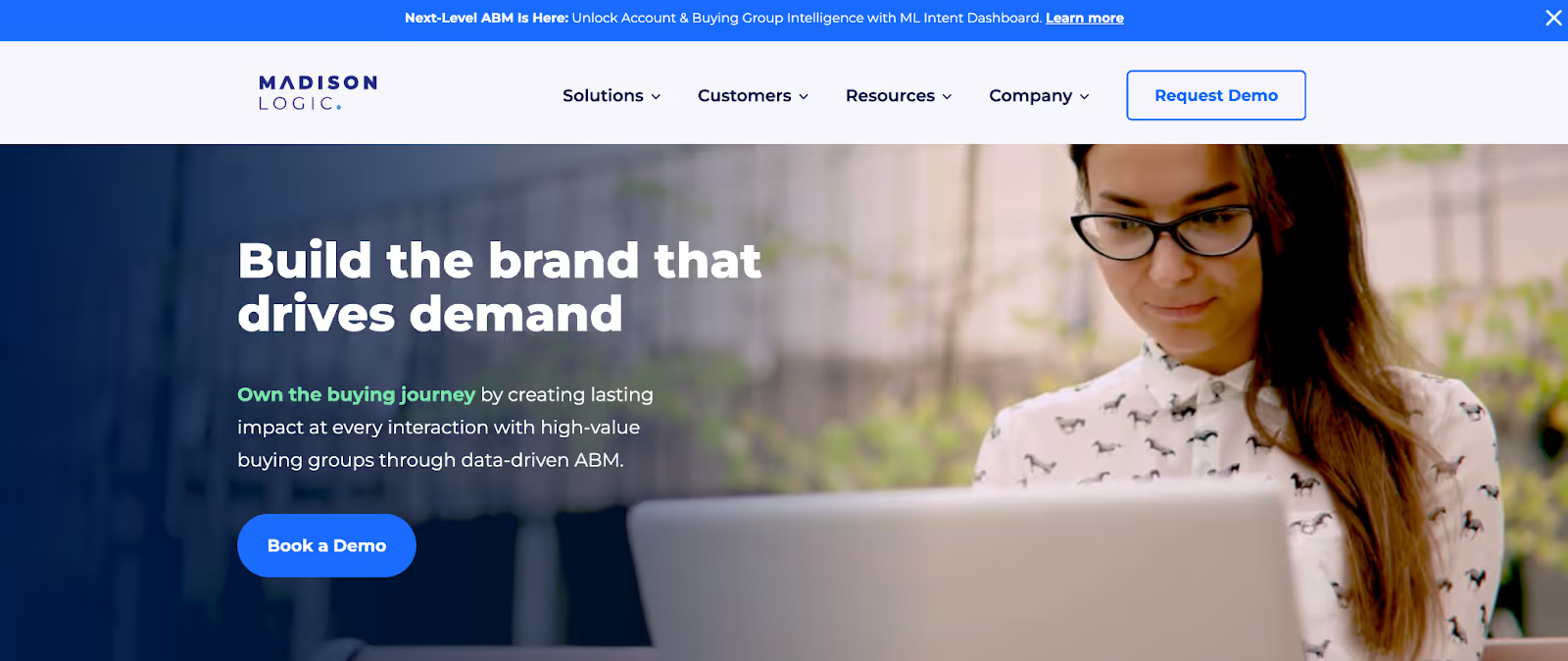
Madison Logic has a long-standing presence in the ABM market and remains best known for its multi-channel activation network. Its ML Insights system provides intent-based targeting data that feeds campaigns across display, LinkedIn, and content syndication.
Key capabilities include:
- Account identification through web analytics tied to ML Insights.
- Multi-source intent data combining historical, install, and research signals.
- Cross-channel activation for display, LinkedIn, and other digital touchpoints.
- Pipeline visibility via ML Measurement for engagement and influence tracking.
Madison Logic’s strength lies in its broad ad reach and established ABM ecosystem, though it focuses more on activation scale than on deep analytics or automation.
Factors.ai vs Madison Logic: Verdict on Functionality and Features
Both platforms deliver strong account-based marketing capabilities, but their focus differs.
Factors.ai emphasizes intelligence, automation, and connected data. It gives GTM teams an integrated platform where AI-driven insights lead directly to measurable actions across LinkedIn, Google, and CRM.
Madison Logic focuses on reach and activation, providing a strong multi-channel foundation for teams running large-scale ABM campaigns. It’s effective for advertising breadth but less advanced in automation and journey analytics.
In short:
Factors.ai = Unified GTM intelligence and automation for modern B2B teams.
Madison Logic = Established ABM activation network for large-scale campaign reach.
Factors.ai vs Madison Logic: Pricing
Pricing often reflects more than just numbers and shows how a platform scales with your team.
Factors.ai and Madison Logic take two very different paths here.
While one builds transparency and flexibility into its plans, the other tailors its pricing entirely around enterprise campaigns.
Factors.ai vs Madison Logic: Pricing Comparison Table
Factors.ai Pricing
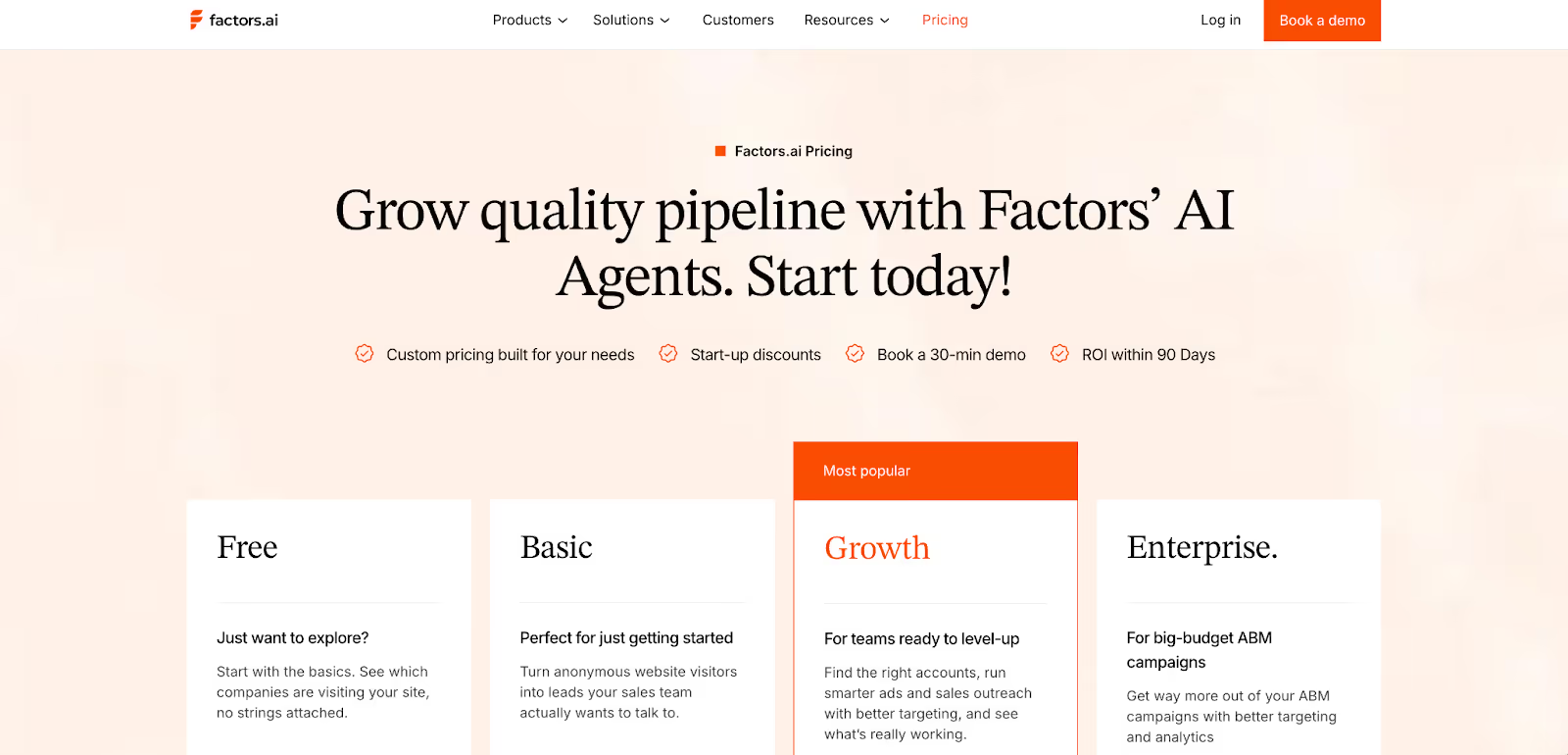
Factors.ai follows a structured, usage-based model designed to grow with your GTM maturity.
Its tiered pricing makes it easy for teams to start small, explore key capabilities, and then expand into deeper analytics and automation without migrating platforms.
Here’s a closer look at each tier:
- Free Plan:
Identify up to 200 companies per month, with 3 seats. Includes company tracking, customer journey timelines, and starter dashboards. Integrates with Slack, and basic website tracking. - Basic Plan:
Identifies 3,000 companies per month with up to 5 seats. Adds LinkedIn intent signals, advanced GTM dashboards, GTM workflows, and helpdesk support. Integrates with major ad and CRM platforms like Google Ads, LinkedIn, Facebook, Bing, HubSpot, and Salesforce. - Growth Plan (Most Popular):
Identifies 8,000 companies per month with up to 10 seats. Adds ABM analytics, LinkedIn attribution, account scoring, G2 intent signals, workflow automation, and a dedicated CSM. Integrates with full HubSpot and Salesforce access, Marketo, G2, and Drift. - Enterprise Plan:
Unlimited company identification with up to 25 seats. Adds predictive account scoring, 50 segments, Milestones analytics, Google and LinkedIn AdPilot, white-glove onboarding, and 300 custom reports. Integrations expand to Segment, Rudderstack, and other custom systems.
This tiered framework gives Factors.ai the advantage of clarity and control, teams always know what they’re paying for and can easily align pricing with their growth stage.
Madison Logic Pricing
Madison Logic takes a custom pricing approach tailored for enterprise ABM execution.
Instead of tiered plans, pricing is determined through sales engagement based on factors like campaign size, ad channels, target regions, and audience volume.
Typical pricing characteristics include:
- No public plans or free trial options.
- Spend-based billing tied to ad campaigns or media budgets.
- Custom quotes that include activation, content syndication, and measurement as bundled services.
- Enterprise focus which is designed for companies running global, full-funnel ABM programs across display, LinkedIn, and content networks.
This structure gives Madison Logic’s enterprise clients flexibility to build large, managed campaigns but limits accessibility for smaller or self-serve teams.
Factors.ai vs Madison Logic: Verdict on Pricing
Both platforms approach pricing with different philosophies aligned to their core audiences.
Factors.ai provides clear, structured tiers for companies that want to scale predictably. Its transparent inclusions and usage-based model make it practical for growing GTM teams that value visibility and control.
Madison Logic positions itself as a service-driven enterprise solution. Its pricing flexibility suits large-scale, high-budget ABM initiatives, but the lack of transparency makes early comparison challenging for mid-market teams.
In short:
Factors.ai = Transparent, tiered pricing that scales with your growth.
Madison Logic = Custom, enterprise pricing built around managed ABM campaigns.
Before you pick a plan, this ABM platform pricing guide helps compare tiered vs enterprise pricing models.
Factors.ai vs Madison Logic: CRM and Data Integrations
How well a GTM platform connects with the rest of your marketing and sales stack defines its real value.
Both Factors.ai and Madison Logic integrate with popular CRMs and MAPs, but the depth of those integrations, and what you can actually do with the synced data, varies significantly.
Factors.ai CRM and Data Integration Comparison Table
Factors.ai’s CRM and Data Integration
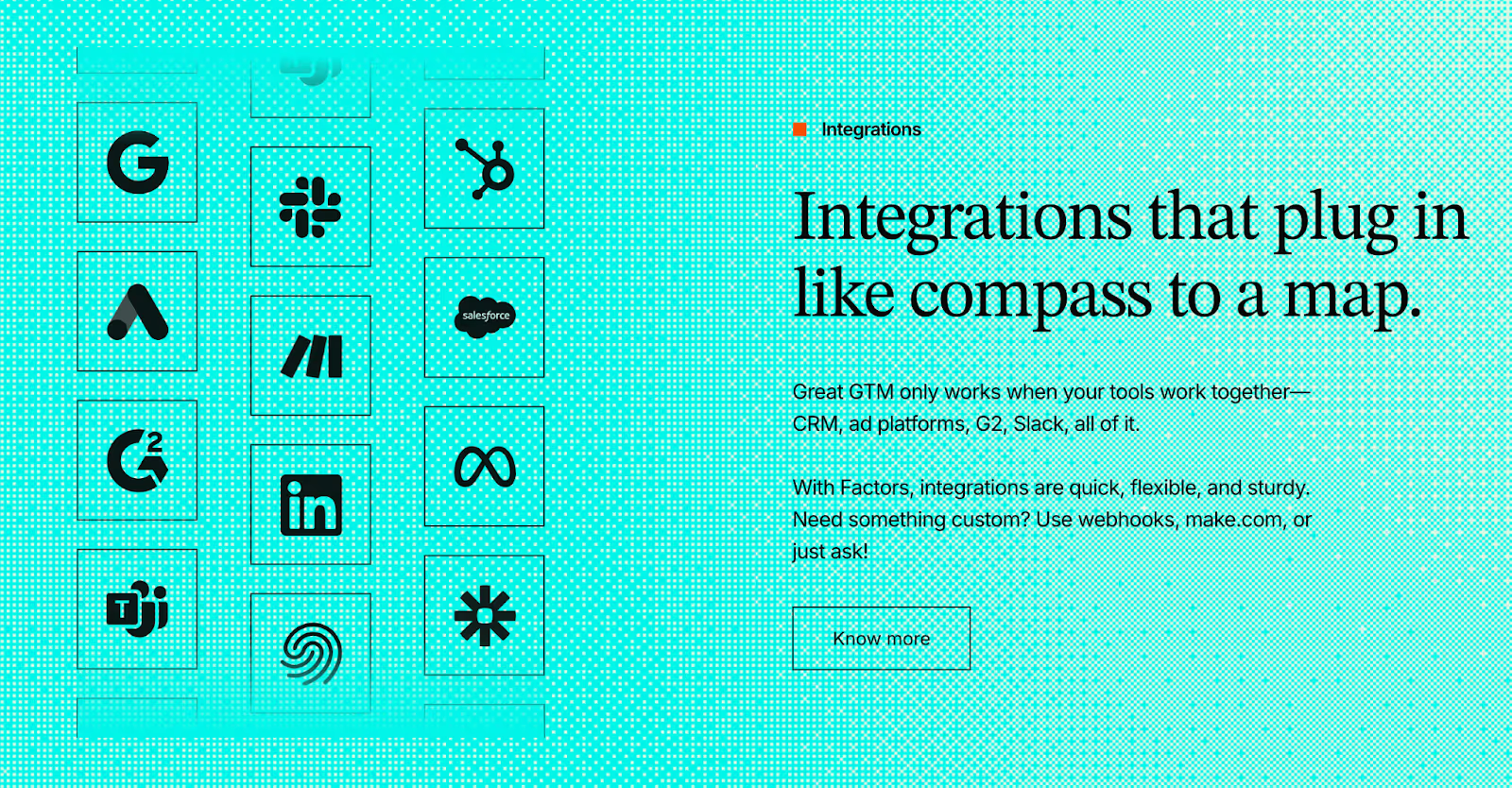
Factors.ai was built to unify the GTM stack, not just connect to it.
Its integrations go beyond basic data sync and enable automation, analytics, and cross-platform orchestration.
With real-time bi-directional syncing, all signals from ads, CRM, and web are aligned into a single view through Account360 and Milestones analytics.
Key integration highlights:
- Deep CRM sync: Full integration with HubSpot, Salesforce, and Marketo for both account and deal-level data.
- Cross-channel connectivity: Ad platforms (LinkedIn, Google, Facebook, Bing) and analytics tools (Search Console, G2, Drift).
- MAP/CDP compatibility: Segment and Rudderstack integrations for data enrichment and custom workflows.
- Real-time sync: Two-way updates between marketing, sales, and analytics pipelines.
- Automation-ready architecture: Enables AI Agents to act on CRM changes instantly, from triggering alerts to updating campaigns.
This ecosystem helps GTM teams keep all data, signals, and workflows connected, ensuring marketing and sales always operate on the same insights.
Madison Logic’s CRM and Data Integration

Madison Logic integrates effectively with enterprise-level systems but focuses mainly on campaign alignment and measurement.
Its integrations are designed to connect CRM and marketing data to support its multi-channel activation model rather than unified analytics.
Notable integration traits:
- CRM compatibility: Works with Salesforce, HubSpot, and Marketo to bring in audience and campaign data.
- MAP/Ad alignment: Integrates with platforms like Adobe Experience Cloud and Convertr for activating content syndication and display campaigns.
- Targeting focus: Pulls company data to power ABM lists and custom audiences across display and LinkedIn Ads.
- One-way sync: Data generally moves from CRM or MAP into activation tools for targeting, with limited feedback loops back into the CRM.
While the integrations serve campaign execution well, they lack the analytical and automation depth that GTM teams increasingly expect from unified platforms.
Factors,ai vs Madison Logic: Verdict on CRM and Data Integrations
Both tools integrate with key CRM and marketing platforms, but they serve different operational purposes.
Factors.ai acts as a central data hub, merging inputs from CRM, ads, and analytics to fuel intelligence and automation. Its two-way sync allows teams to use data for both activation and measurement, reducing silos across GTM functions.
Madison Logic connects with similar systems but uses the data primarily for ad targeting and campaign execution, not for dynamic analytics or automation.
In short:
Factors.ai = Deep, bi-directional integrations designed for unified GTM intelligence.
Madison Logic = Practical CRM connectivity built for ABM campaign execution.
Factors.ai vs Madison Logic: Intent Data and Account Intelligence
Intent data is the foundation of any modern GTM strategy.
It helps teams understand which accounts are in-market, what they’re researching, and when they’re most likely to convert.
Both Factors.ai and Madison Logic use intent signals to drive engagement, but the way they collect, analyze, and act on this data differs in depth and flexibility.
Factors.ai vs Madison Logic: Intent Data and Account Intelligence Comparison Table
Factors.ai’s Intent Data and Account Intelligence
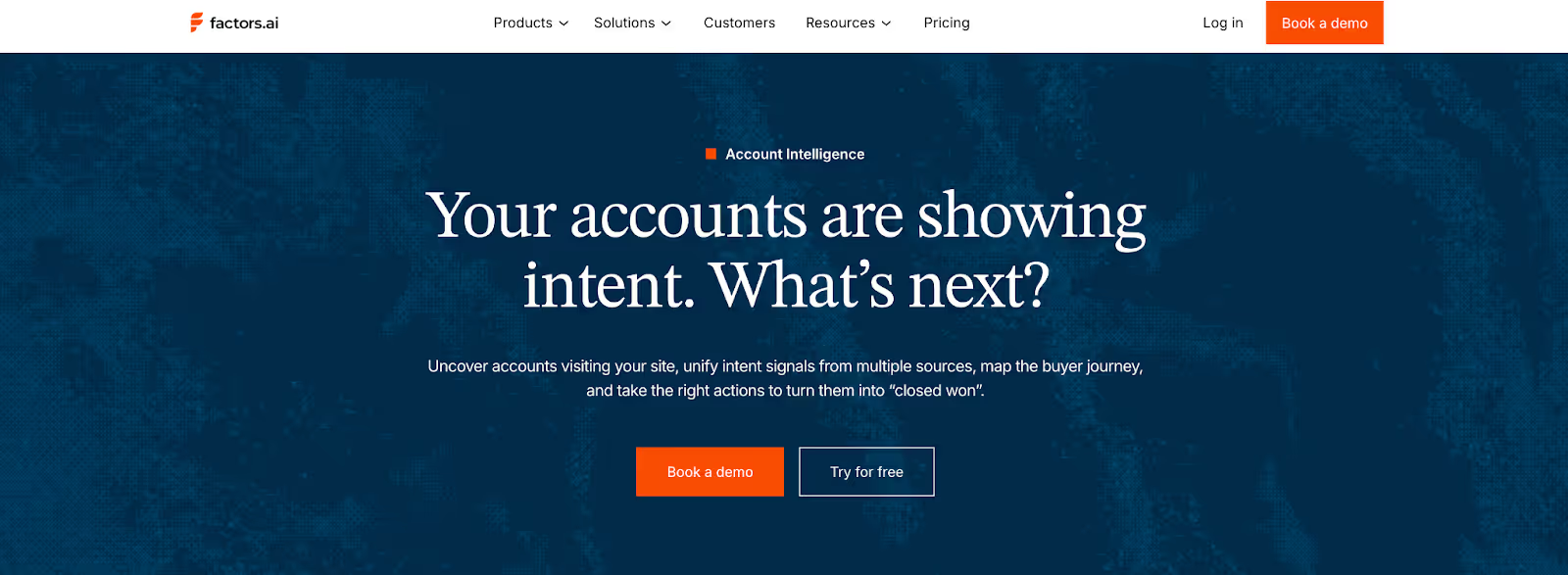
Factors.ai approaches intent data as a connected ecosystem rather than a data feed.
It blends behavioral, engagement, and firmographic signals from across the funnel, then enriches them with external data sources for higher accuracy and actionability.
Key strengths in intent intelligence include:
- Multi-source intent capture: Pulls from website, CRM, ads, and review platforms like G2.
- AI scoring: AI Agents continuously assess signal strength and account readiness.
- Buying group identification: Maps multiple stakeholders interacting from the same company.
- Real-time automation: Triggers alerts, audience updates, or SDR notifications instantly when intent crosses a defined threshold.
- Milestones integration: Links intent to funnel movement, showing which actions advance deals.
This gives GTM teams not just visibility into who’s active, but also insight into how close they are to conversion.
Madison Logic’s Intent Data and Account Intelligence
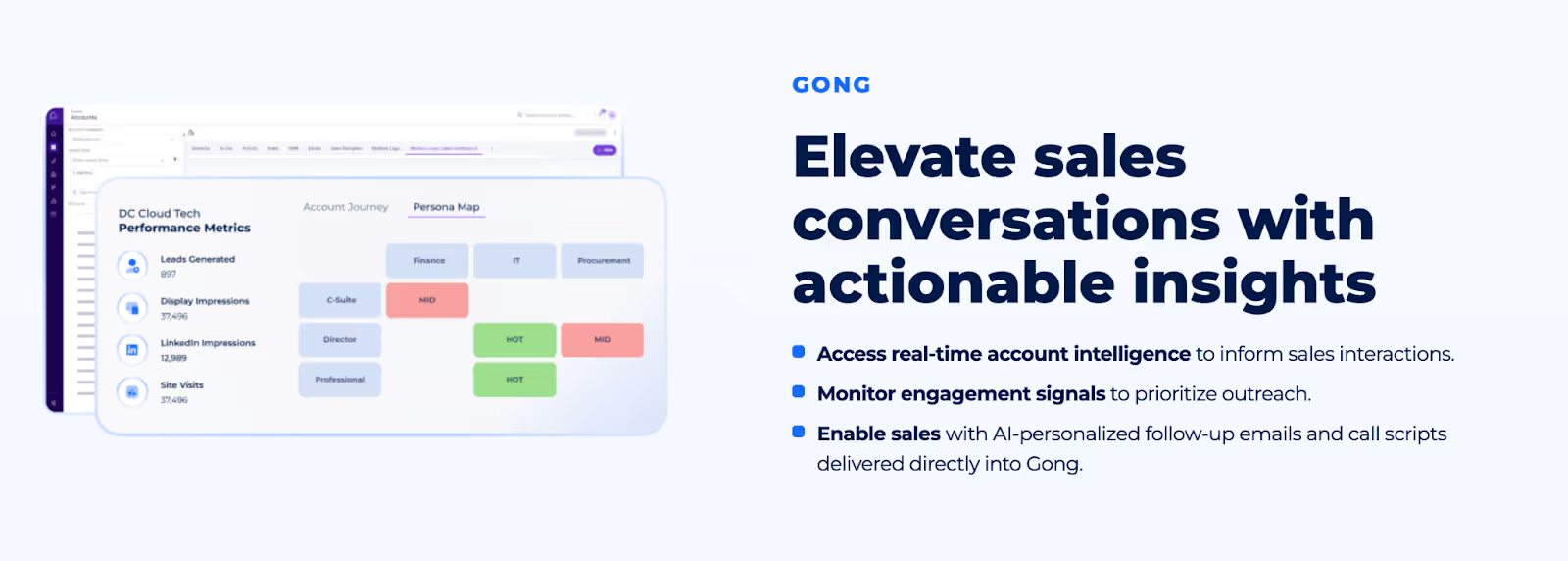
Madison Logic centers its intent capabilities around ML Insights, a proprietary dataset designed to identify in-market accounts and guide ABM targeting.
It combines three data sources including historical performance, install base, and B2B research activity, to determine which accounts are showing relevant buying signals.
Notable features include:
- Historical engagement analysis to find repeat or lookalike accounts.
- Intent-based prioritization for display, LinkedIn, and content syndication campaigns.
- Integration with CRM data for refining audience segments and optimizing campaign targeting.
- ML Measurement for correlating intent data with pipeline influence and deal velocity.
While ML Insights offers broad coverage across industries, it focuses more on reach and campaign readiness than on depth of behavioral intelligence.
Factors.ai vs Madison Logic: Verdict on Intent Data & Account Intelligence
Both platforms give GTM teams the ability to act on buying intent, but they differ in how actionable and dynamic that intelligence is.
Factors.ai provides real-time, AI-driven intent intelligence, combining first-party data with external signals like G2, mapping buying groups, and connecting everything back to pipeline analytics. It turns signals into immediate next steps through alerts and automations.
Madison Logic focuses on aggregated market intent through ML Insights, which works well for large-scale campaigns but offers limited visibility into individual account journeys or multi-contact engagement patterns.
In short:
Factors.ai = Real-time, multi-source intent intelligence designed for activation and analytics.
Madison Logic = Aggregated market intent data optimized for ABM targeting.
If intent is the core of this comparison, you’ll love our post on Buyer Intent for ABM as it shows how to turn signals into sales-ready actions.
Factors.ai vs Madison Logic: Ad Activation and Orchestration
Even the best intent data means little if it doesn’t translate into effective activation.
That’s why the ability to sync audiences, launch contextual ads, and orchestrate campaigns across multiple platforms has become a defining feature of modern GTM stacks.
Both Factors.ai and Madison Logic offer ad activation features, but their depth, automation, and cross-platform coordination vary sharply.
Factors.ai vs Madison Logic: Ad Activation and Orchestration Comparison Table
Factors.ai Ad Activation and Orchestration
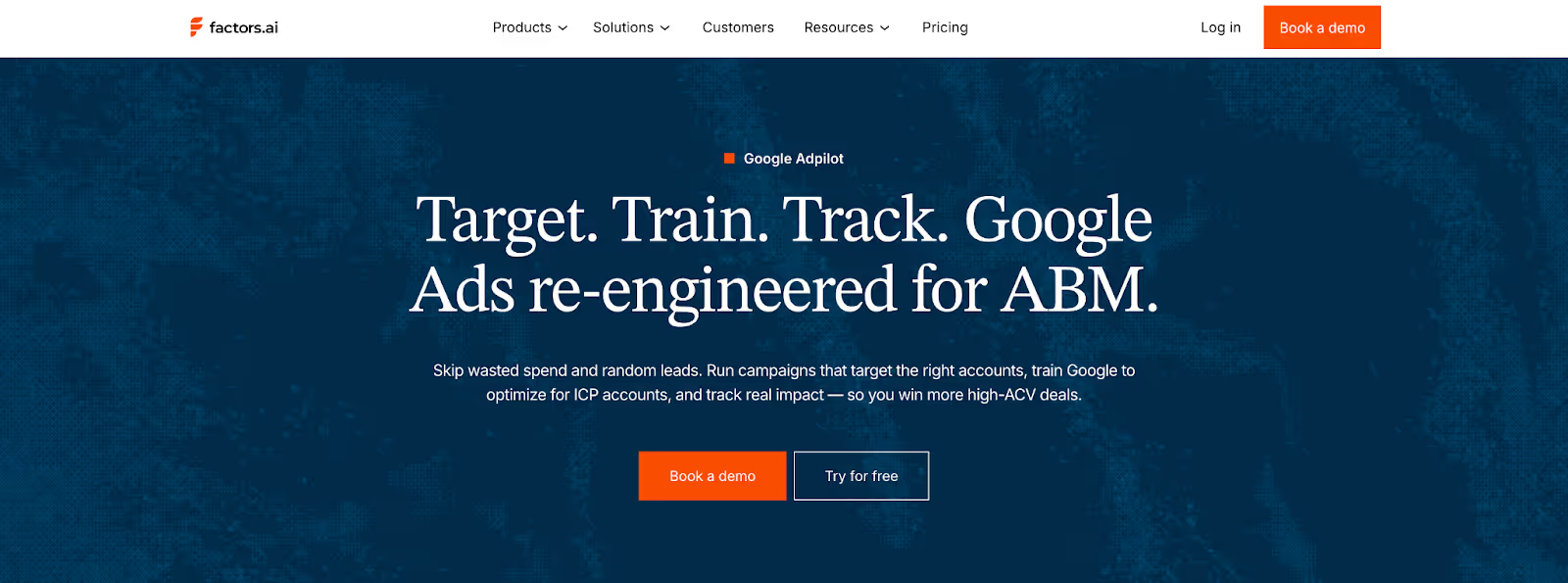
Factors.ai brings intelligence to ad orchestration through its integrated AdPilot suite, built specifically for performance-driven B2B campaigns.
Rather than simply syncing audiences, it uses intent signals and funnel movement to dynamically adjust ad delivery, ensuring that every impression counts.
Core activation strengths include:
- LinkedIn AdPilot: Automatically refreshes audiences using real-time intent data. Ensures only high-intent accounts see active campaigns.
- Google AdPilot: Sends conversion signals through Google CAPI, optimizing bids for ICP-fit accounts and suppressing irrelevant clicks.
- Buyer-stage campaigns: Tailors ad creatives and delivery based on funnel stages across awareness, consideration, or decision.
- Cross-platform orchestration: Triggers ad, CRM, and Slack actions from the same AI workflows, creating a continuous GTM loop.
- Impression pacing control: Prevents ad fatigue by distributing impressions evenly across targeted accounts.
The result is a smarter, leaner ad strategy and reduces waste and converts intent into measurable pipeline growth.
Madison Logic’s Ad Activation and Orchestration
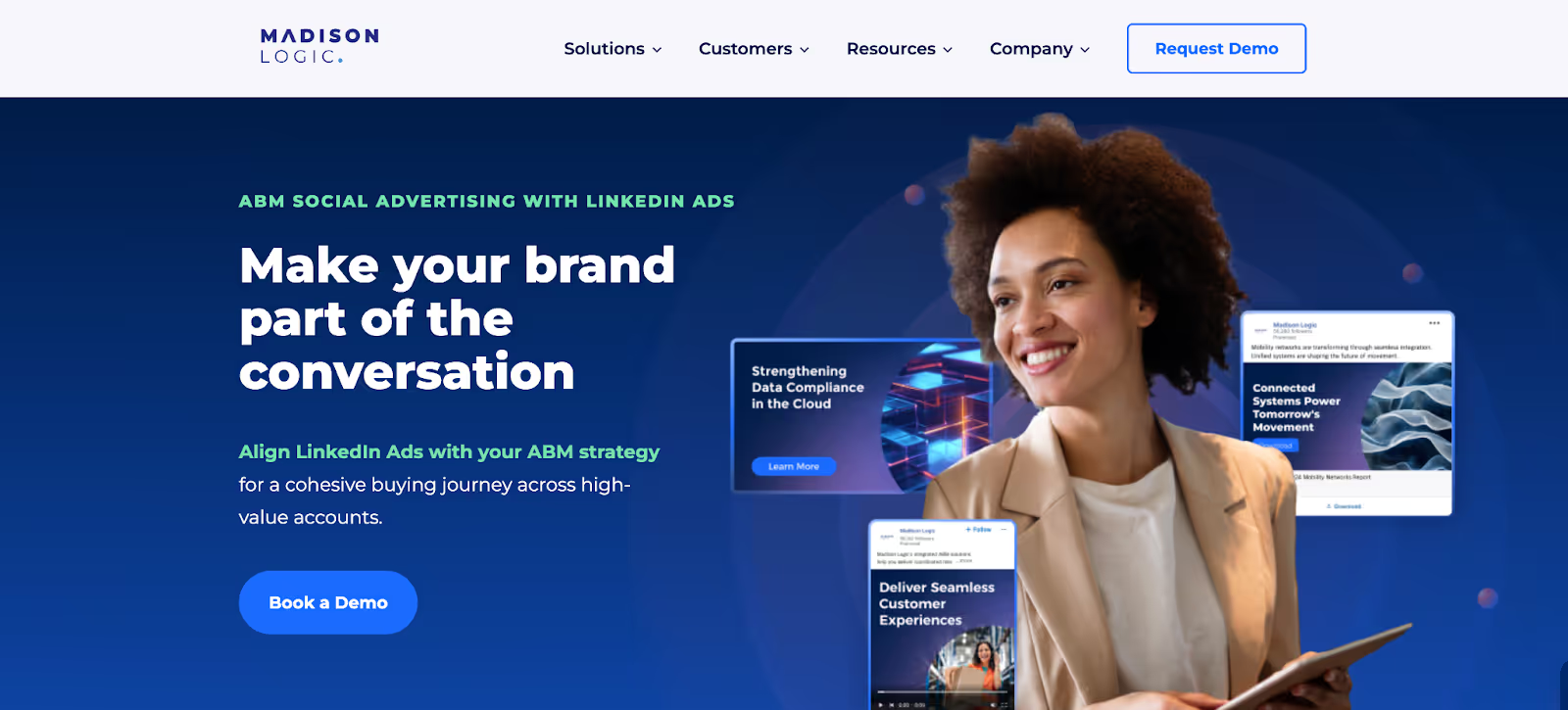
Madison Logic is widely recognized for its multi-channel activation network, covering display, LinkedIn, CTV, audio, and content syndication.
Its platform allows B2B marketers to deliver targeted campaigns at scale, especially for enterprise audiences.
Key ad activation capabilities include:
- Native LinkedIn integration for audience-based ABM campaigns.
- Display and content syndication channels for broader reach and retargeting.
- Campaign-level targeting powered by ML Insights intent data.
- Cross-channel measurement through ML Measurement for engagement and ROI tracking.
- Manual orchestration: Campaign updates and targeting refinements are primarily handled via platform setup rather than automation.
Madison Logic’s model works well for large marketing teams running broad ABM programs, though its orchestration layer remains less dynamic compared to AI-driven systems like Factors.ai.
Factors.ai vs Madison Logic: Verdict on Ad Activation and Orchestration
Both platforms excel in different aspects of ad activation, but their approaches reflect two distinct mindsets.
Factors.ai focuses on precision and automation, activating ads only when intent is high, refreshing audiences in real time, and linking campaign performance directly to revenue. Its AdPilot suite brings measurable efficiency to both LinkedIn and Google Ads.
Madison Logic shines in reach and diversity, offering multi-channel exposure across display, CTV, and content networks. However, its orchestration remains manual, and campaign optimization depends more on scale than on signal-based automation.
In short:
Factors.ai = Dynamic, AI-led ad activation with real-time optimization.
Madison Logic = Multi-channel ABM execution built for enterprise reach.
Running LinkedIn campaigns? Here’s a hands-on guide to LinkedIn ads strategy for B2B SaaS which is great for deciding whether native activation (Madison Logic) or AdPilot-style syncs fit you.
Factors.ai vs Madison Logic: Analytics, Measurement and Reporting
For B2B marketers, understanding what actually drives pipeline is just as important as generating it.
That’s where analytics and reporting make the difference between guessing and scaling.
Both Factors.ai and Madison Logic provide performance insights, but their approaches: one unified and intelligent, the other campaign-focused which reflects the broader philosophy of each platform.
Factors.ai vs Madison Logic: Analytics, Measurement and Reporting Comparison Table
Factors.ai’s Analytics, Measurement and Reporting
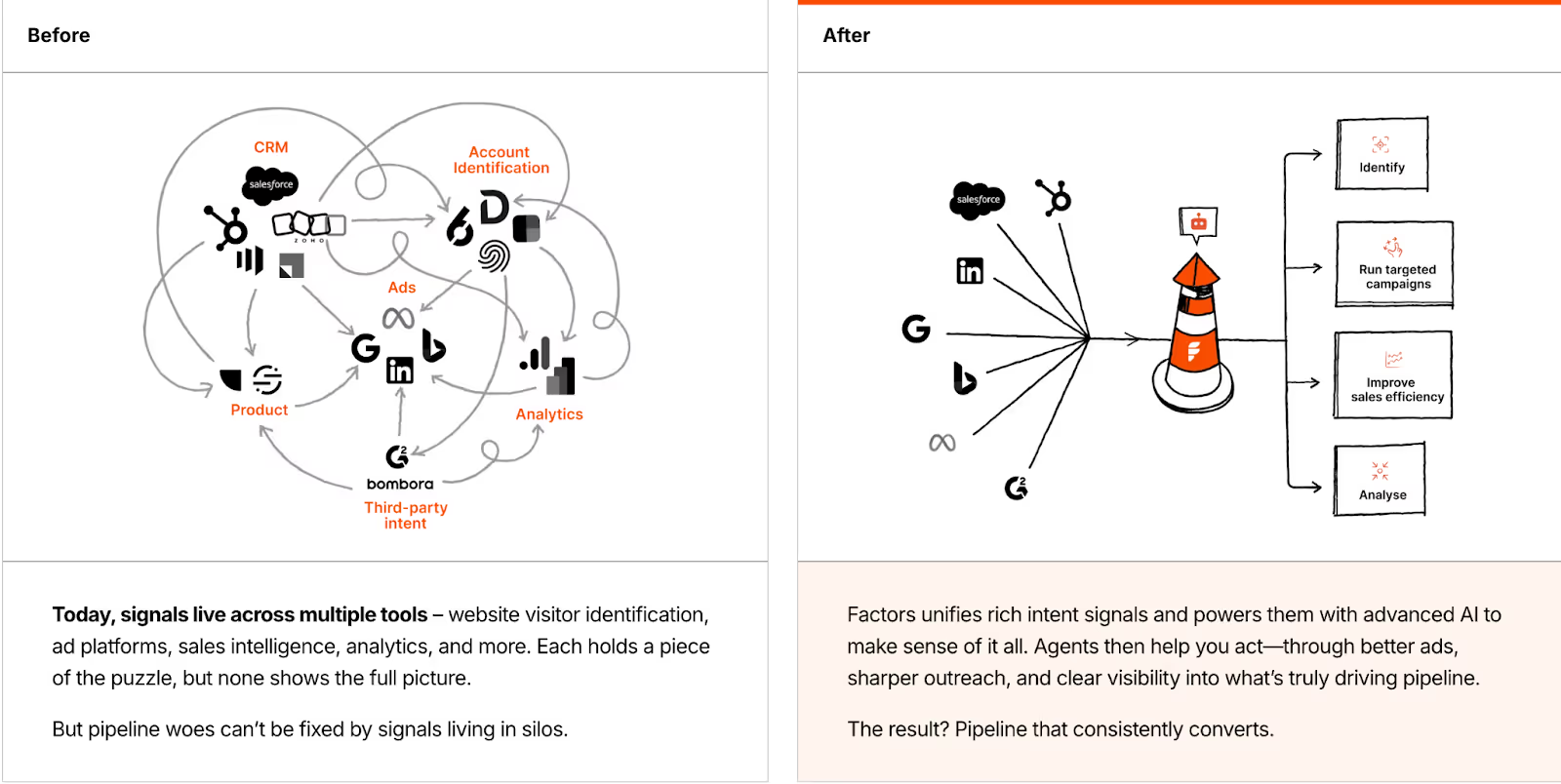
Factors.ai approaches analytics as the core of GTM intelligence, connecting every marketing and sales signal into a single measurement framework.
Its analytics layer isn’t just about visualizing metrics; it’s designed to explain why deals move, where engagement happens, and how campaigns influence revenue.
Key strengths in analytics and measurement:
- Milestones analytics: Tracks how accounts move through different funnel stages and attributes every touchpoint that contributed to progress.
- Multi-touch attribution: Measures ROI across campaigns, ads, and CRM activities to identify high-performing channels.
- Custom dashboards: Offers up to 300 customizable reports, segmented by account type, intent level, or sales stage.
- Account360 visibility: Combines CRM, ad, and web data to show the full customer journey, from first touch to closed deal.
- Revenue linkage: Connects marketing actions directly to pipeline outcomes for clear, defensible ROI.
With Factors.ai, teams move from reporting on activities to proving outcomes, shifting analytics from “what happened” to “what worked.”
Madison Logic’s Analytics, Measurement and Reporting
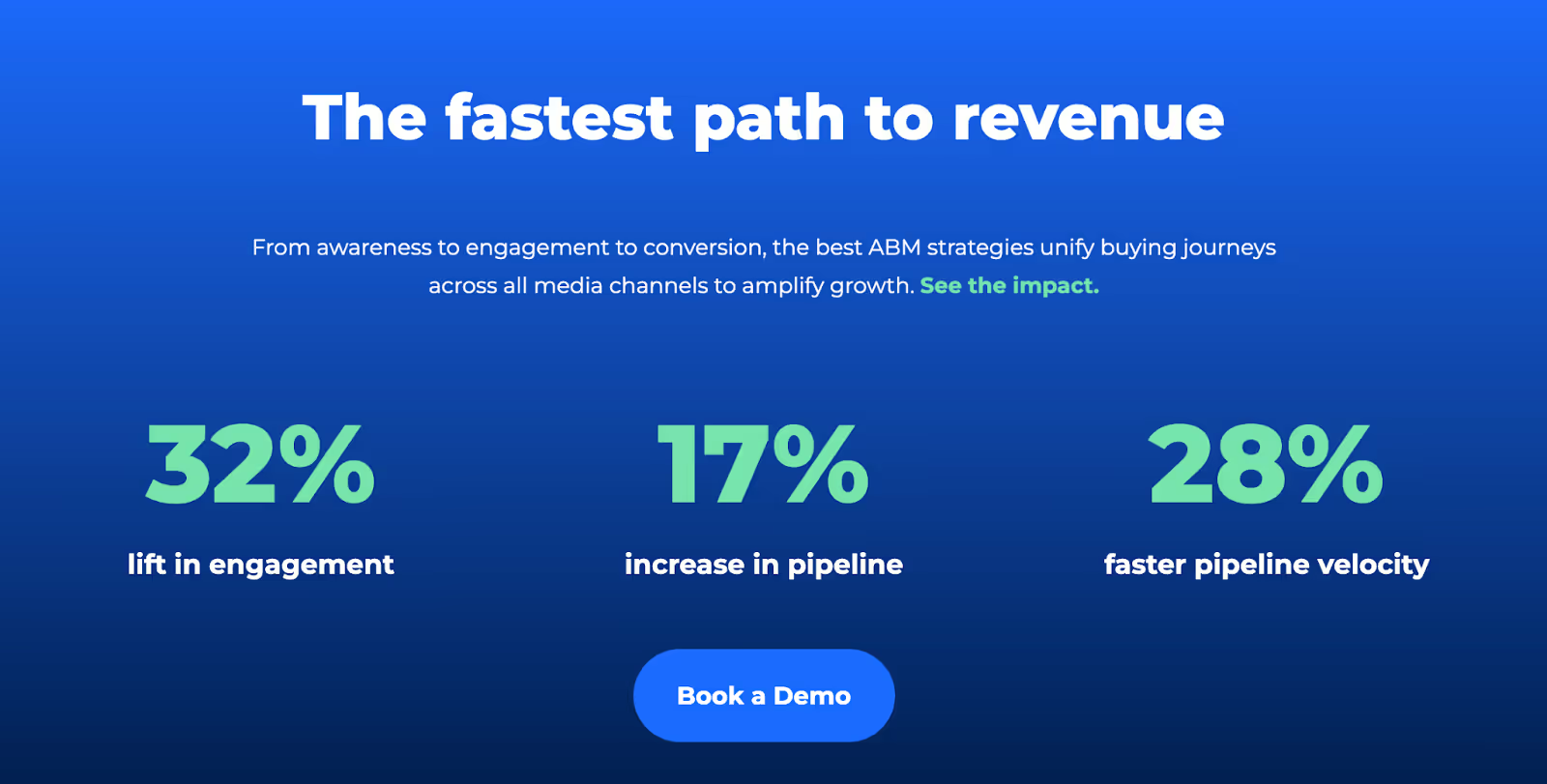
Madison Logic focuses its measurement framework on campaign performance and pipeline influence through its ML Measurement product.
It’s designed for marketers running large, multi-channel ABM campaigns who need visibility into reach, engagement, and deal velocity.
Key analytics capabilities include:
- Campaign performance reporting across display, LinkedIn, and content syndication channels.
- Pipeline influence analysis, showing which campaigns contributed to deal acceleration.
- Engagement scoring for tracking content consumption and ad interaction.
- ROI snapshots comparing media spend to influenced revenue.
- Standard dashboards for evaluating reach, click-throughs, and conversion impact.
While these insights help enterprises gauge overall ABM success, Madison Logic’s analytics lean toward post-campaign summaries rather than real-time performance optimization.
Factors.ai vs Madison Logic: Verdict on Analytics, Measurement, and Reporting
Both platforms aim to quantify marketing impact, but at different levels of sophistication.
Factors.ai delivers a complete measurement ecosystem, connecting every campaign, ad, and CRM touchpoint into one analytical view. Its multi-touch attribution, Milestones framework, and custom reporting make it ideal for teams focused on pipeline accuracy and continuous optimization.
Madison Logic provides solid campaign-level visibility, particularly valuable for enterprise marketers tracking cross-channel engagement and media performance. However, its insights remain top-level which is better for measuring impact than diagnosing it.
In short:
Factors.ai = Full-funnel analytics that link engagement directly to revenue.
Madison Logic = Campaign-level measurement suited for large-scale ABM visibility.
Factors.ai vs Madison Logic: Support, Onboarding and Ease of Setup
A powerful platform is only as good as its implementation.
For marketing and sales teams, smooth onboarding and responsive support determine how fast they can go from setup to measurable results.
Both Factors.ai and Madison Logic support enterprise customers, but their post-sale experiences differ in accessibility, personalization, and speed.
Factors.ai vs Madison Logic: Support, Onboarding and Ease of Setup Comparison Table
Factors.ai’s Approach Support, Onboarding and Ease of Setup
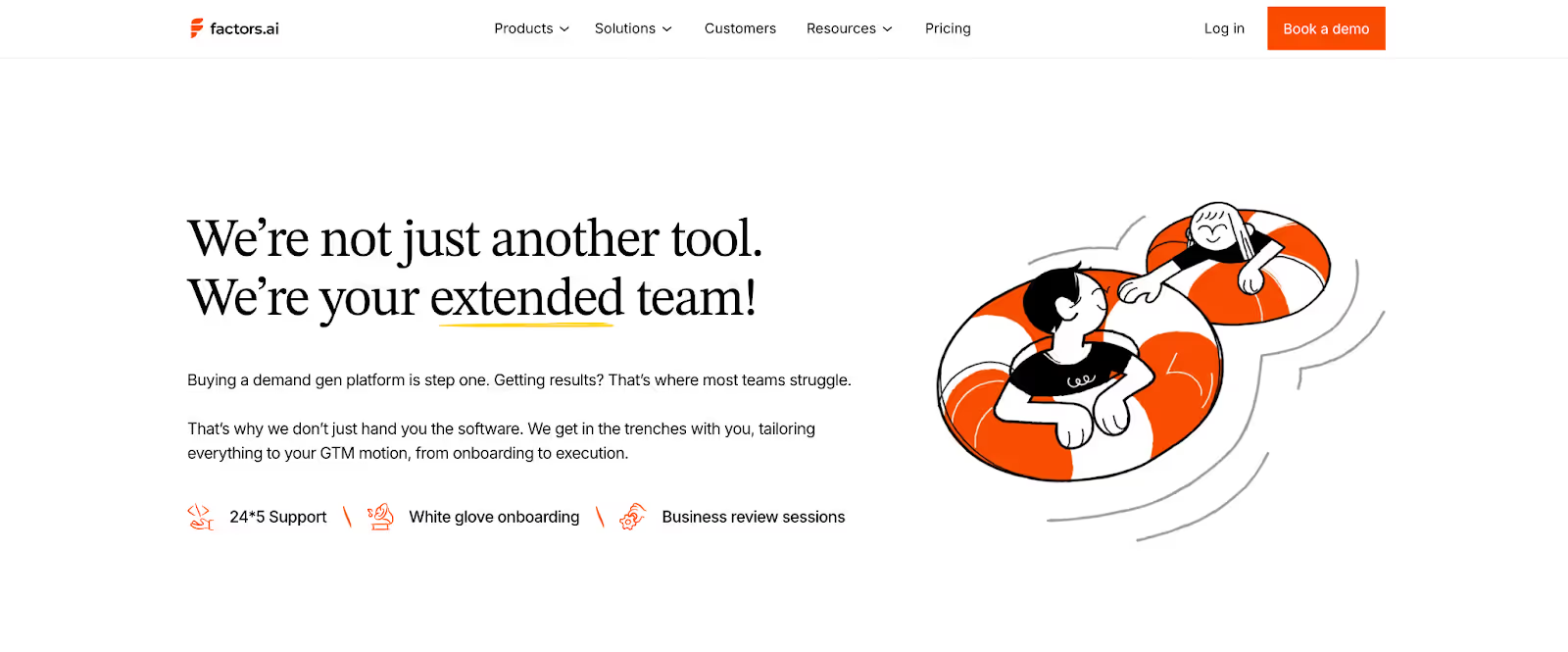
Factors.ai prioritizes accessibility and hand-holding from the very start.
Its onboarding experience is built for speed and confidence, ensuring that teams can see data flowing within days of setup.
Key highlights:
- White-glove onboarding: Dedicated specialists assist with platform setup, integrations, and initial configuration.
- Dedicated CSM: Every account, especially at Growth and Enterprise tiers, gets a customer success manager who ensures goals are met and progress tracked.
- Support channels: Live Slack communication, helpdesk, and email support ensure real-time responses.
- Weekly GTM syncs: Teams receive ongoing performance reviews and recommendations to improve campaign strategy.
- Ease of setup: Most integrations (HubSpot, Salesforce, Google Ads, LinkedIn) are plug-and-play, requiring minimal technical input.
This hands-on approach means even non-technical GTM teams can go live quickly and receive continuous optimization guidance, not just troubleshooting.
Madison Logic’s Support, Onboarding and Ease of Setup
Madison Logic provides onboarding that’s tailored for large enterprise ABM programs.
Its process involves working directly with campaign managers and strategists to configure targeting, creative, and measurement, making it suitable for organizations with defined internal marketing operations.
Notable support characteristics:
- Managed onboarding: The Madison Logic team typically handles campaign setup and alignment rather than a self-service model.
- Enterprise support model: Assistance is often routed through account managers and ticket-based systems.
- Setup complexity: Because campaigns are customized for scale, implementation may take longer and require alignment with multiple departments.
- Performance reviews: Enterprise clients receive periodic reports, but ongoing strategic feedback isn’t always continuous.
While the experience is professional and enterprise-grade, it caters to structured marketing departments with dedicated staff which is less suited for agile teams needing faster self-service setups.
Factors.ai vs Madison Logic: Verdict on Support, Onboarding and Ease of Setup
Both platforms deliver credible enterprise support, but their approaches cater to different customer needs.
Factors.ai provides fast, collaborative onboarding that helps teams start quickly and stay aligned through ongoing reviews. Its human-led yet agile support experience suits both scaling startups and large GTM teams.
Madison Logic, by contrast, offers a traditional enterprise support model focused on managed campaign delivery. It’s reliable for big organizations but less flexible for smaller teams that prefer direct, self-driven access.
In short:
Factors.ai = Fast, guided onboarding and responsive, hands-on support.
Madison Logic = Structured, enterprise-managed onboarding suited for large ABM teams.
Factors.ai vs Madison Logic: Security and Compliance
When handling sensitive customer and campaign data, security is a foundation of trust.
Both Factors.ai and Madison Logic take compliance seriously, offering enterprise-grade safeguards, but their depth and transparency differ in a few important ways.
Factors.ai vs Madison Logic: Security and Compliance Comparison Table
Factors.ai’s Security and Compliance
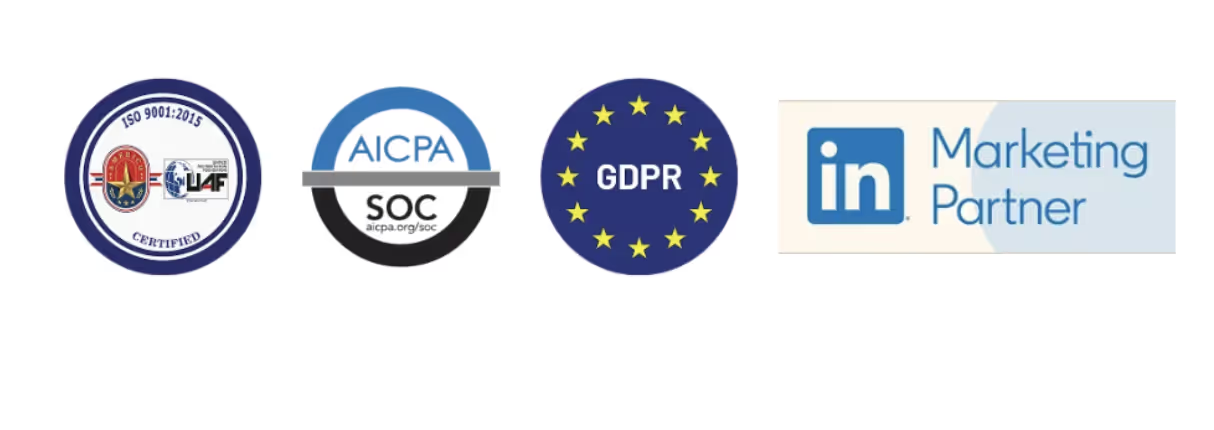
Factors.ai treats data security as an integral part of its infrastructure.
Hosted on Google Cloud Platform (GCP), it inherits GCP’s SOC-certified environment while adding multiple internal security layers to ensure customer data stays private, encrypted, and auditable.
Key security practices include:
- Data encryption: All customer data is encrypted both in transit (TLS, SHA-2) and at rest (AES-256).
- Access controls: Role-based permissions, multi-factor authentication, and IP-based access restrictions.
- Organizational security: Every employee signs confidentiality agreements and undergoes ongoing security training.
- Incident management: A clear policy led by a Data Protection Officer (DPO), with immediate reporting and recovery protocols.
- Backup and disaster recovery: Frequent snapshots stored in multiple geographic locations within the US.
- International data protection: Adheres to EU SCCs with technical and organizational safeguards for cross-border data transfers.
The platform’s transparency is another strength: its public Security Policy outlines all compliance practices and certifications, giving customers full visibility into how their data is protected.
Madison Logic’s Security and Compliance

Madison Logic maintains a strong compliance posture, with certifications and privacy adherence built around enterprise advertising standards.
The company is SOC 2 Type II, GDPR, CCPA, and CASL compliant, ensuring that personal and campaign data meets international privacy expectations.
Security framework highlights:
- Data center compliance: Operates on enterprise-grade hosting with SOC and ISO certifications.
- Privacy coverage: Fully aligned with GDPR and CCPA regulations for data processing and opt-out handling.
- Ad data protection: Uses secure protocols to protect audience and campaign data shared across display and LinkedIn networks.
- Access controls: Standard authentication and limited user permissions to safeguard platform use.
- Data processing agreements: Available to customers upon request, detailing data handling and storage practices.
While Madison Logic provides the expected security for an enterprise ABM platform, it offers fewer publicly available details about technical controls or encryption methods compared to Factors.ai’s transparent documentation.
Factors.ai vs Madison Logic: Verdict on Security and Compliance
Both platforms comply with leading global standards, but their approaches to transparency and depth differ.
Factors.ai stands out with its publicly documented, multi-layered security framework, SOC and ISO certifications, and clear data protection processes. Its encryption, backup, and compliance structure make it ideal for teams with strict data governance requirements.
Madison Logic offers robust enterprise compliance, ensuring legal and privacy adherence across campaigns, but keeps its internal processes largely behind closed documentation. It’s reliable for large-scale marketing operations but less open in its technical transparency.
In short:
Factors.ai = Transparent, multi-layered security framework with public compliance visibility.
Madison Logic = Enterprise-grade compliance with limited public technical disclosure.
If privacy and compliance are priorities, this article explores website visitor identification privacy and how to remain compliant while doing ABM.
Factors.ai vs Madison Logic: Overall Verdict and Recommendation
Both Factors.ai and Madison Logic empower B2B marketers to reach and engage their target accounts, but their strengths lie in very different areas.
Where Madison Logic emphasizes large-scale, managed ABM campaigns across multiple ad channels, Factors.ai focuses on intelligent, connected GTM execution, turning every insight into measurable action.
Factors.ai vs Madison Logic: Quick Comparison Recap
- Choose Factors.ai if you want a unified GTM platform that connects intent, analytics, and activation which is perfect for teams that value agility, automation, and transparency.
- Choose Madison Logic if you prioritize ABM reach, managed execution, and multi-channel advertising at enterprise scale.
In the end, Madison Logic helps you reach your market,
but Factors.ai helps you understand it and convert it.
If this comparison helped, you may also like these related deep dives:
- Factors vs ZoomInfo - compare account intelligence approaches.
- Factors vs Dreamdata - deeper look at analytics + attribution differences.
FAQs for Factors.ai vs Madison Logic
Q. What is the main difference between Factors.ai and Madison Logic?
The biggest difference comes down to how intelligence turns into action.
Factors.ai focuses on real-time intent intelligence, automation, and full-funnel analytics that directly trigger ads, alerts, and workflows.
Madison Logic, on the other hand, is built around large-scale ABM activation, helping enterprises reach target accounts across multiple paid channels with managed execution.
Q. Which platform is better for intent-based B2B marketing?
If you want real-time, first-party-led intent data that updates as accounts move through your funnel, Factors.ai is the stronger fit.
If your priority is aggregated market intent to power broad ABM campaigns across display and content networks, Madison Logic is better aligned to that use case.
Q. Does Factors.ai support both LinkedIn Ads and Google Ads?
Yes. Factors.ai supports both LinkedIn and Google Ads through its AdPilot suite.
Audiences sync dynamically based on intent and funnel stage, and Google conversion signals are sent via CAPI to improve bid optimization and reduce wasted spend.
Madison Logic primarily supports LinkedIn Ads along with display, CTV, and content syndication channels, but does not offer Google Ads activation.
Q. Can Madison Logic replace a GTM analytics or attribution tool?
Not entirely. Madison Logic provides campaign-level measurement and pipeline influence tracking, which works well for reporting on ABM performance at scale.
However, it does not offer deep multi-touch attribution, journey timelines, or CRM-linked funnel analytics the way Factors.ai does.
Q. Which platform is better for small or mid-sized B2B teams?
Factors.ai is generally better suited for startups and mid-market teams because of:
- Transparent, tiered pricing
- A free plan to get started
- Faster onboarding and self-serve workflows
Madison Logic is more appropriate for large enterprise teams with established ABM budgets and managed campaign requirements.
Q. Does Factors.ai integrate deeply with CRM systems?
Yes. Factors.ai offers bi-directional integrations with HubSpot, Salesforce, and Marketo.
This means CRM updates, deal stages, and account activity flow both ways, enabling real-time scoring, alerts, and analytics.
Madison Logic integrates with similar CRMs, but data typically flows one way to support campaign targeting rather than closed-loop GTM analytics.
Q. How does each platform handle buying groups and multiple stakeholders?
Factors.ai actively identifies buying groups by mapping multiple contacts engaging from the same account and tracking their shared journey.
Madison Logic focuses more on account-level intent and targeting, with less visibility into individual stakeholders or buying group dynamics.
Q. Is Factors.ai suitable for enterprise teams?
Yes. Factors.ai offers an Enterprise plan with:
- Unlimited account identification
- Predictive scoring
- Advanced Milestones analytics
- White-glove onboarding
- Custom reporting at scale
It’s especially useful for enterprise teams that want automation, attribution clarity, and tighter sales-marketing alignment, not just media execution.
Q. Which platform is easier to implement and go live with?
Factors.ai typically goes live within days, thanks to plug-and-play integrations and guided onboarding.
Madison Logic’s setup timeline varies depending on campaign scope and often involves longer coordination cycles across teams and regions.
Q. Does either platform offer a free trial or free plan?
Factors.ai offers a free plan, allowing teams to track companies, view journeys, and integrate Slack before upgrading.
Madison Logic does not offer a free plan or public trial.
Q. How do Factors.ai and Madison Logic compare on data security and compliance?
Both platforms are enterprise-grade and compliant with major regulations like GDPR and CCPA.
Factors.ai stands out for its publicly documented security practices, ISO 27001 and SOC 2 Type II certifications, and detailed encryption policies.
Madison Logic is SOC 2 Type II compliant but provides fewer publicly available technical details.
Q. Which platform should I choose for my GTM strategy?
Choose Factors.ai if you want:
- Real-time intent intelligence
- Automation across ads, CRM, and workflows
- Clear attribution from engagement to revenue
Choose Madison Logic if you want:
- Broad ABM reach across multiple paid channels
- Managed enterprise campaign execution
- A strong activation network at scale
Both are solid platforms, the right choice depends on whether you value precision and insight or reach and scale.
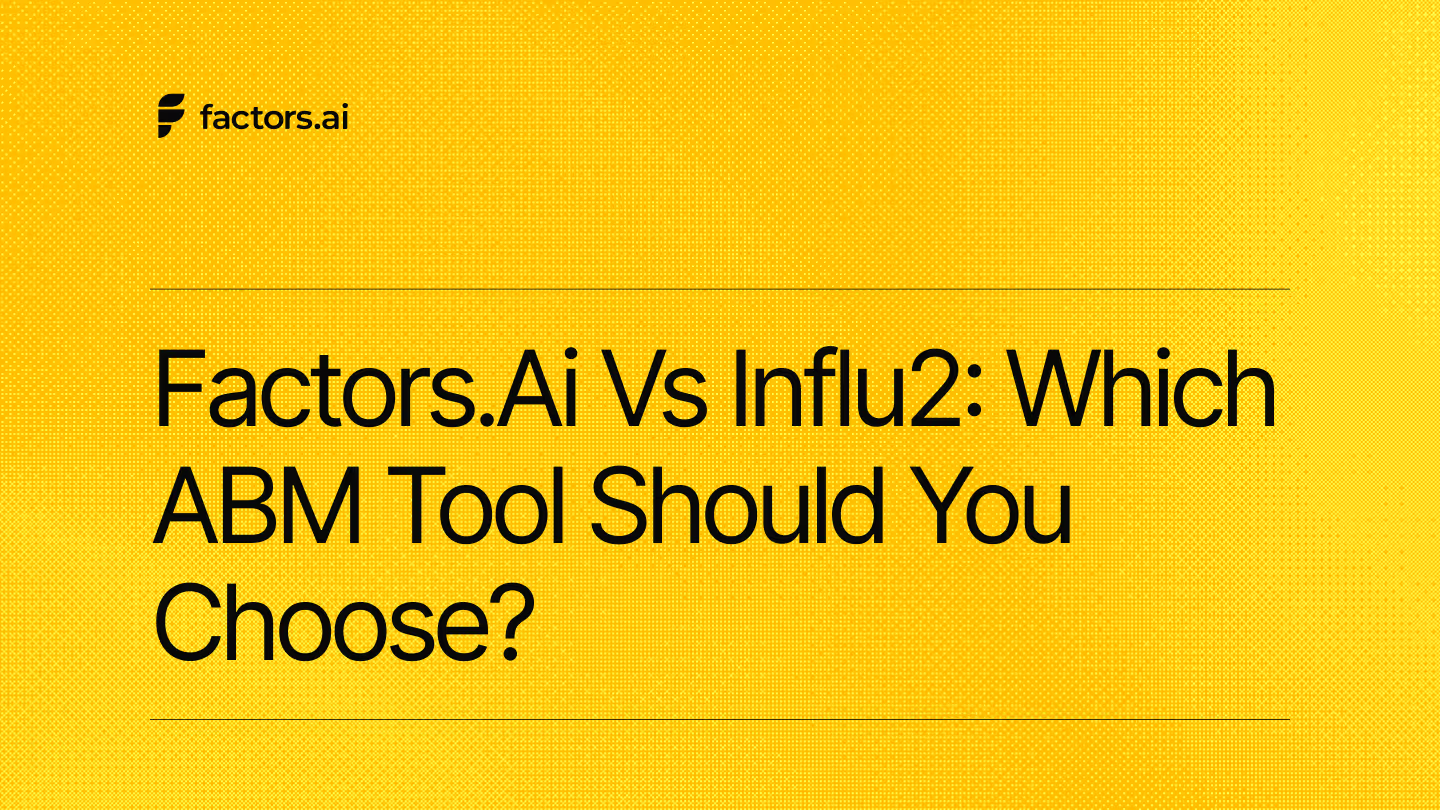
Factors.ai vs Influ2: Which ABM Tool Should You Choose?
Finding the ‘right’ demand generation platform usually starts with a demo and ends with a headache.
I’ve seen this play out way too often. Someone on the team says, “We need better intent data.” Another person says, “We just need cleaner attribution.” A third says, “Sales wants visibility into who’s actually engaging.” And suddenly you’re evaluating tools that sound similar on paper but solve very different problems in reality.
That’s exactly where the comparison between Factors.ai and Influ2 sits.
Both platforms help GTM teams move closer to revenue. Both talk about intent, pipeline, and alignment. But they come from fundamentally different starting points. One is built around understanding accounts and orchestrating the entire GTM motion. The other is built around reaching specific people and proving ad influence with precision.
If you’re running modern B2B demand gen, especially across ads, CRM, sales workflows, and revenue reporting, this distinction matters more than most teams realize.
In this guide, I break down how Factors.ai and Influ2 actually work across functionality, pricing, identification, intent, ad activation, analytics, support, and security. The goal is simple. Help you figure out which platform fits how your GTM engine really runs, not how it looks in a slide deck.
Factors vs Influ2: Functionality and Core Capabilities
One question I always ask when evaluating GTM tools is simple: how many tabs do I still need open after I log in?
Some platforms solve one very specific problem extremely well. Others try to act as the connective tissue across marketing, sales, and revenue. Neither approach is wrong. But confusing one for the other is where teams get stuck.
In an ecosystem like the one we’re in today… filled with ad-tech and GTM platforms, the real difference lies in how much of the demand-generation process a tool can handle end-to-end.
Both Factors.ai and Influ2 aim to help marketing and sales teams drive more revenue from intent data and targeted outreach, but the way they approach that goal is very different.
Factors.ai works as a complete GTM orchestration system that connects analytics, automation, and activation.
Influ2, in contrast, focuses on precision advertising at the contact level, showing the right message to the right person across multiple channels.
This section is all about scope. Are you looking for a system that helps you execute a specific motion with precision, or a platform that helps you see, measure, and run your entire GTM strategy in one place?
Functionality and Core Capabilities Comparison
Factors.ai’s Functionality and Core Capabilities

Factors.ai goes beyond traditional analytics by giving GTM teams an integrated workspace where every part of the demand-generation process connects.
What stands out here is that this setup mirrors how real GTM teams work. Signals do not live in isolation. Website visits, ad clicks, CRM updates, and product usage all influence how accounts move forward. Having these stitched together in one timeline saves hours of manual interpretation and removes a lot of guesswork between marketing and sales.
With platforms like Factors.ai by their side… teams go from reactive follow-ups to proactive outreach simply because everyone is finally looking at the same account story.
Key capabilities:
- Account 360: a unified timeline that brings together website activity, ad engagement, CRM data, and product usage in one view.
- Milestones: funnel analytics that show how accounts move from awareness to revenue.
- AI Agents: tools that analyze data, surface buying signals, and alert sales when an account is ready for outreach.
- Dynamic Ad Activation: automated campaign updates through Google CAPI and LinkedIn AdPilot, ensuring ads reach only active, in-market accounts.
- GTM Engineering Services: optional add-on support that helps teams automate workflows and integrate tools efficiently.
The result is a system that doesn’t just report performance but actively shapes it to help teams identify, engage, and convert high-intent accounts within one connected environment.
Influ2’s Functionality and Core Capabilities
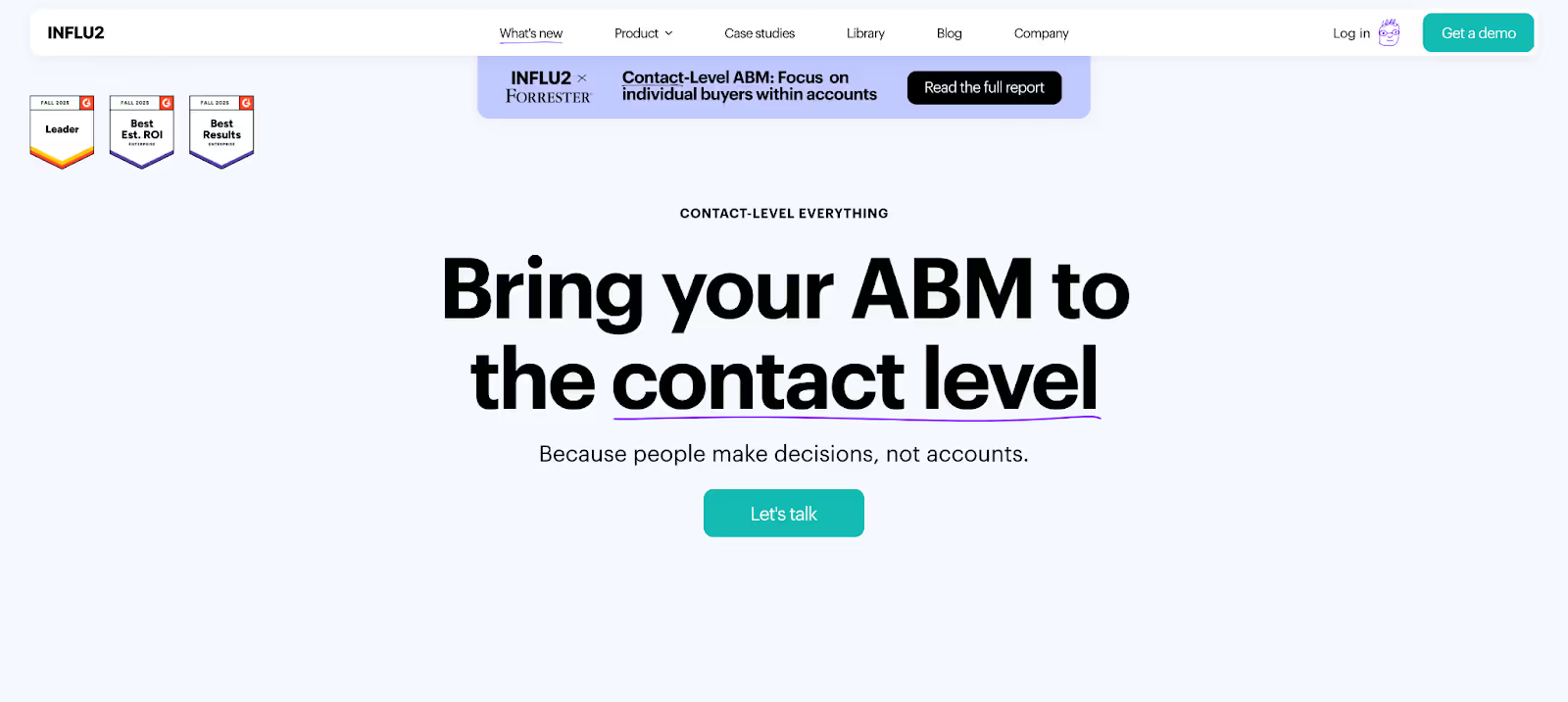
Influ2 takes a more focused route by centering everything around people. Its strength lies in showing ads to named contacts already in your CRM and then tracking their exact interactions with each campaign.
Now, this model works best when your target universe is already defined. You know who the buyers are, you trust your CRM data, and your priority is making sure specific people see specific messages at the right time.
For teams running tight ABM or sales-assisted advertising, this kind of clarity can be useful. Sales conversations also become easier when reps can see exactly which ads a prospect engaged with before a call.
Key capabilities:
- Contact-Level Targeting: sync CRM contacts directly and serve ads only to those specific individuals.
- Ad Engagement Tracking: see who viewed or clicked an ad and how often.
- Journey Mapping for Ads: align ad messaging to buyer stages and personalize creatives accordingly.
- Sales Notifications: alert sales reps when targeted contacts engage with an ad.
- Revenue Attribution: connect ad exposure data with pipeline and closed-won deals to prove ROI.
It’s a precise system that works best when you already know your audience and want to reach them consistently across digital channels.
Factors vs Influ2: Verdict on Functionality and Core Capabilities
Both platforms deliver results but cater to different needs.
Influ2 is a sharp, contact-level tool that gives you visibility into who engaged with your ads and how they moved through the funnel.
Factors.ai is built for teams that need more than visibility and brings together data, automation, and execution to manage the entire GTM process in one place.
In short:
Factors.ai = Full-funnel orchestration for scalable revenue growth.
Influ2 = Targeted advertising for known contacts and ABM programs.
Factors vs Influ2: Pricing and Plans
Some platforms optimize for flexibility and self-serve growth. Others optimize for enterprise deals and bespoke contracts. Neither is inherently better, but it does affect how quickly teams can get started and how confidently they can plan ahead.
While both Factors.ai and Influ2 focus on measurable marketing outcomes, their pricing models work very differently.
Factors.ai follows a clear usage-based structure with multiple tiers designed for growth.
Influ2, on the other hand, doesn’t publish its pricing, requiring a sales call for every quote.
Pricing and Plans Comparison
Factors.ai Pricing and Plans

Factors.ai is built to be flexible and upfront.
Its pricing scales based on usage and team size, allowing companies to start small and expand as their GTM activities grow.
What I like about this structure is that teams can actually grow into the platform. You can start with identification and journeys, then layer on scoring, ABM analytics, and ad activation as your GTM motion matures. The optional GTM engineering support also removes a common bottleneck I see, where great tools fail simply because no one has the time to wire everything correctly.
Here’s how it breaks down:
- Free Plan: For small teams exploring account identification and journey tracking.
- Basic Plan: Adds LinkedIn intent signals, GTM workflows, and CRM integrations.
- Growth Plan: Includes ABM analytics, account scoring, and G2 intent signals with a dedicated CSM.
- Enterprise Plan: Offers unlimited company tracking, predictive scoring, and premium integrations like Google and LinkedIn AdPilot.
For teams that want hands-on technical help, GTM Engineering Services can be added at an additional cost.
This gives teams direct engineering support for workflow automation, advanced integrations, and data management which is something most software tools charge separately through agencies or consultants.
Influ2 Pricing and Plans
Influ2 takes a traditional enterprise pricing route.
Its pricing isn’t listed publicly, and quotes are provided only after understanding the client’s campaign goals, ad budget, and audience size.
This approach makes sense for organizations already committed to large ad budgets and defined ABM programs. The trade-off is predictability. Without public pricing, it’s harder for teams to benchmark or plan experiments without going through a full sales cycle.
Factors vs Influ2: Verdict on Pricing and Plans
Factors.ai offers clarity and flexibility which is the kind of pricing structure that allows teams to grow at their own pace.
Its optional GTM Engineering Services add value for companies that need both software and setup guidance without hiring external partners.
Influ2 focuses on custom enterprise contracts tailored to ad spend and CRM scope.
That’s ideal for teams with established budgets but less suited for those wanting straightforward, self-serve onboarding.
In short:
Factors.ai = Transparent, scalable, and supported by optional GTM setup services.
Influ2 = Custom enterprise pricing designed for established ABM programs.
Factors vs Influ2: Account and Contact Identification
You probably already know this but… the strength of any GTM or advertising platform starts with how accurately it can identify who’s engaging with your brand.
For B2B teams, that accuracy can mean the difference between wasted ad spend and real pipeline growth.
Factors.ai and Influ2 both excel in identification, but they approach it from different angles.
Factors.ai focuses on recognizing accounts and mapping every signal tied to them, while Influ2 focuses on contacts, showing ads directly to known individuals synced from your CRM.
Account and Contact Identification Comparison
Factors.ai Account and Contact Identification
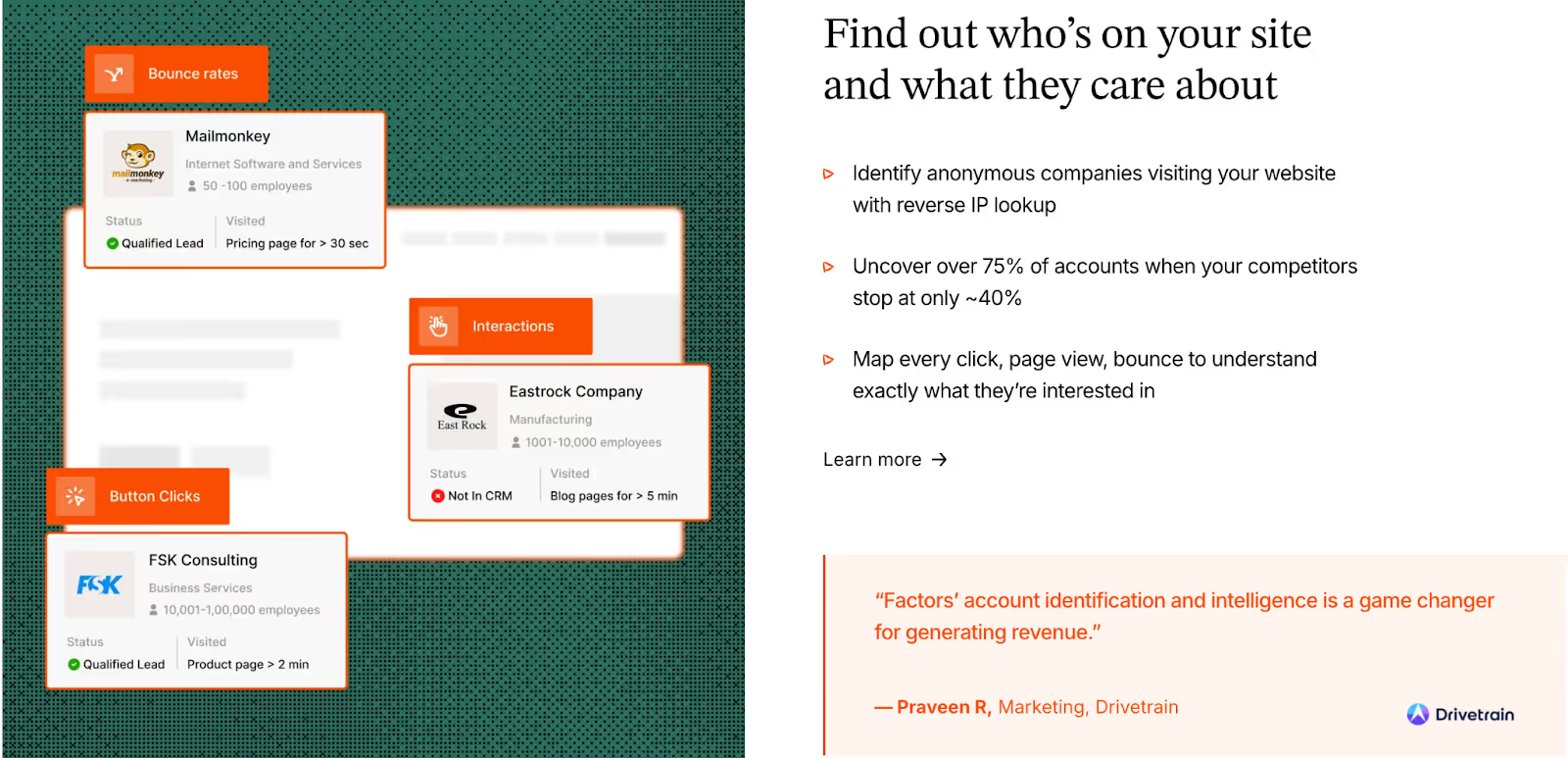
Factors.ai builds identification around the concept of the account journey. Instead of relying on single-source data, it enriches signals across multiple layers like web, CRM, product, and ad performance to build a detailed picture of buying intent.
The strength here is coverage and context. Identification is not treated as a one-time event but as an evolving account journey. Signals accumulate over time, across channels, and across people within the same organization. That’s what allows teams to move beyond “someone from this company visited” to “this account is actively evaluating.”
Key capabilities:
- Sequential Enrichment: uses multiple signals to match anonymous traffic with company data.
- Account 360: creates a unified profile for each account, combining all interactions across touchpoints.
- Multi-Signal Intent Mapping: pulls in first-party (site), second-party (ads, G2), and third-party (uploads) data.
- Contact Insights via AI Agents: surfaces decision-makers, recent actions, and context for outreach.
- Funnel Positioning: helps teams see where each account stands in the buying process.
This approach gives GTM teams visibility into both who is showing intent and how far they’ve moved toward conversion.
Influ2 Account and Contact Identification
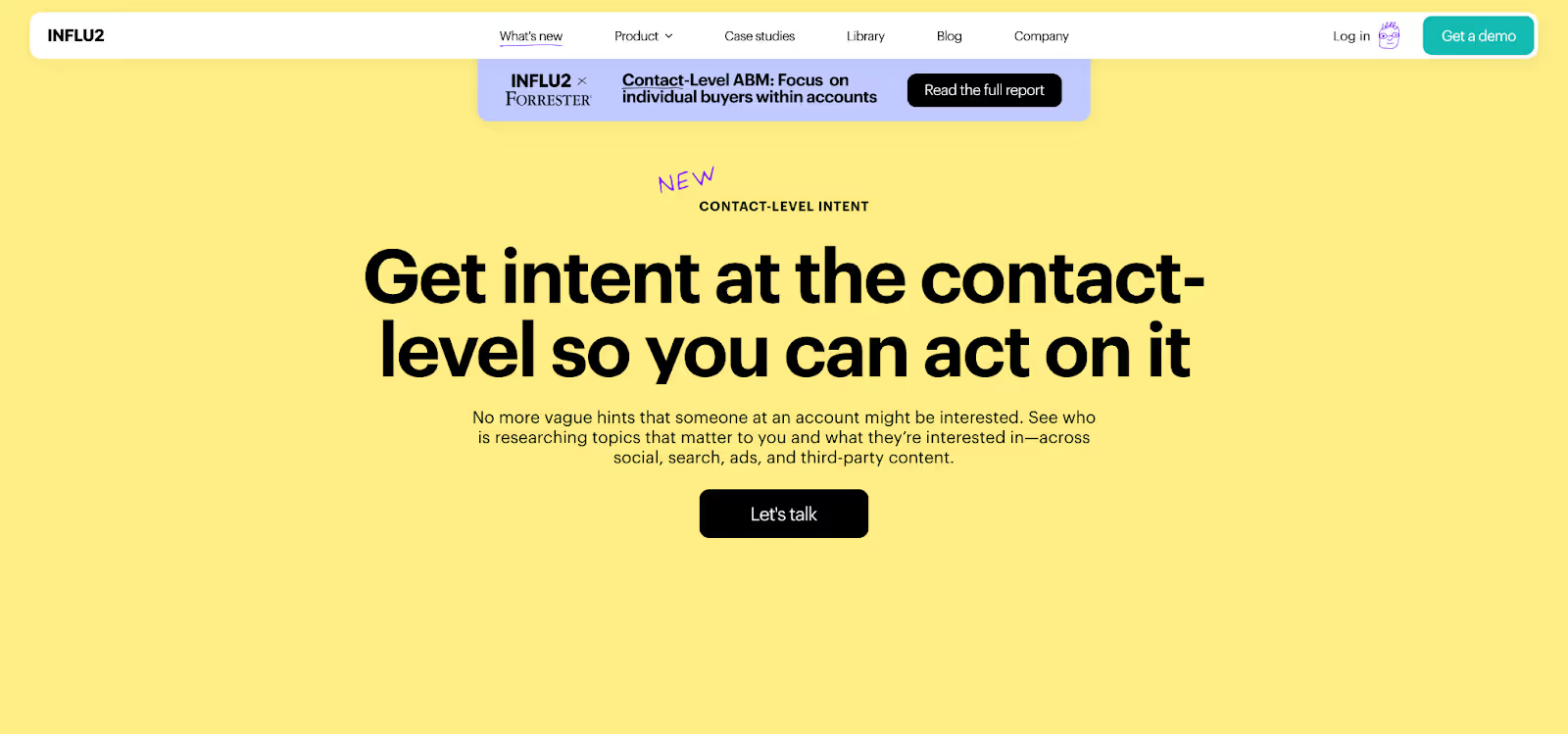
Influ2 works from the opposite direction, starting with named contacts already known to your team. Its strength lies in precision targeting rather than broad discovery.
What I’m saying is… Influ2 does not try to discover new accounts. It assumes discovery has already happened. Its value comes from making sure known contacts are consistently reached and their engagement is fully visible. For focused ABM motions, that clarity can be a huge win.
Key capabilities:
- CRM Sync: imports contacts directly from Salesforce, HubSpot, or other CRMs.
- Person-Level Targeting: delivers ads specifically to those individuals, not just companies or roles.
- Contact-Level Identification: maps ad engagement (views, clicks) to each contact’s profile.
- Sales Notifications: alerts reps when targeted contacts interact with ads.
- Audience Refresh: keeps lists up to date as contacts are added or removed from campaigns.
This makes Influ2 especially effective for ABM programs focused on known accounts and warm prospects. It doesn’t uncover new leads but ensures your message reaches the right people consistently.
Factors vs Influ2: Verdict on Account and Contact Identification
Influ2 delivers precision through contact-level targeting, making it ideal for teams running focused ABM or sales-assisted campaigns.
It gives visibility into who exactly engaged with your ads and when.
Factors.ai, meanwhile, offers a broader view, identifying not only the accounts visiting your site but also mapping all interactions leading to intent.
It connects individual behaviors back to the larger buying group, giving teams both discovery and context.
In short:
Factors.ai = Account-level visibility that connects every signal across the funnel.
Influ2 = Contact-level precision built for targeted advertising programs.
Factors vs Influ2: Intent Signals and Buyer Insights
Intent is one of the most overused words in GTM. Everyone claims to have it. Very few platforms explain what they actually do with it.
What matters here is how signals are interpreted and whether they help teams act earlier and with more confidence.
For GTM teams, it’s not enough to know who visited a page as they need to know why, when, and how close that visitor is to taking action.
Both Factors.ai and Influ2 focus on intent, but they do it differently.
Factors.ai gathers intent from multiple layers like website behavior, CRM activity, ads, and product engagement to show the full account picture.
Influ2, on the other hand, tracks intent at the individual level, measuring who among your known contacts is responding to ads and how that maps to revenue.
Intent Signals and Buyer Insights Comparison
Factors.ai Intent Signals and Buyer Insights
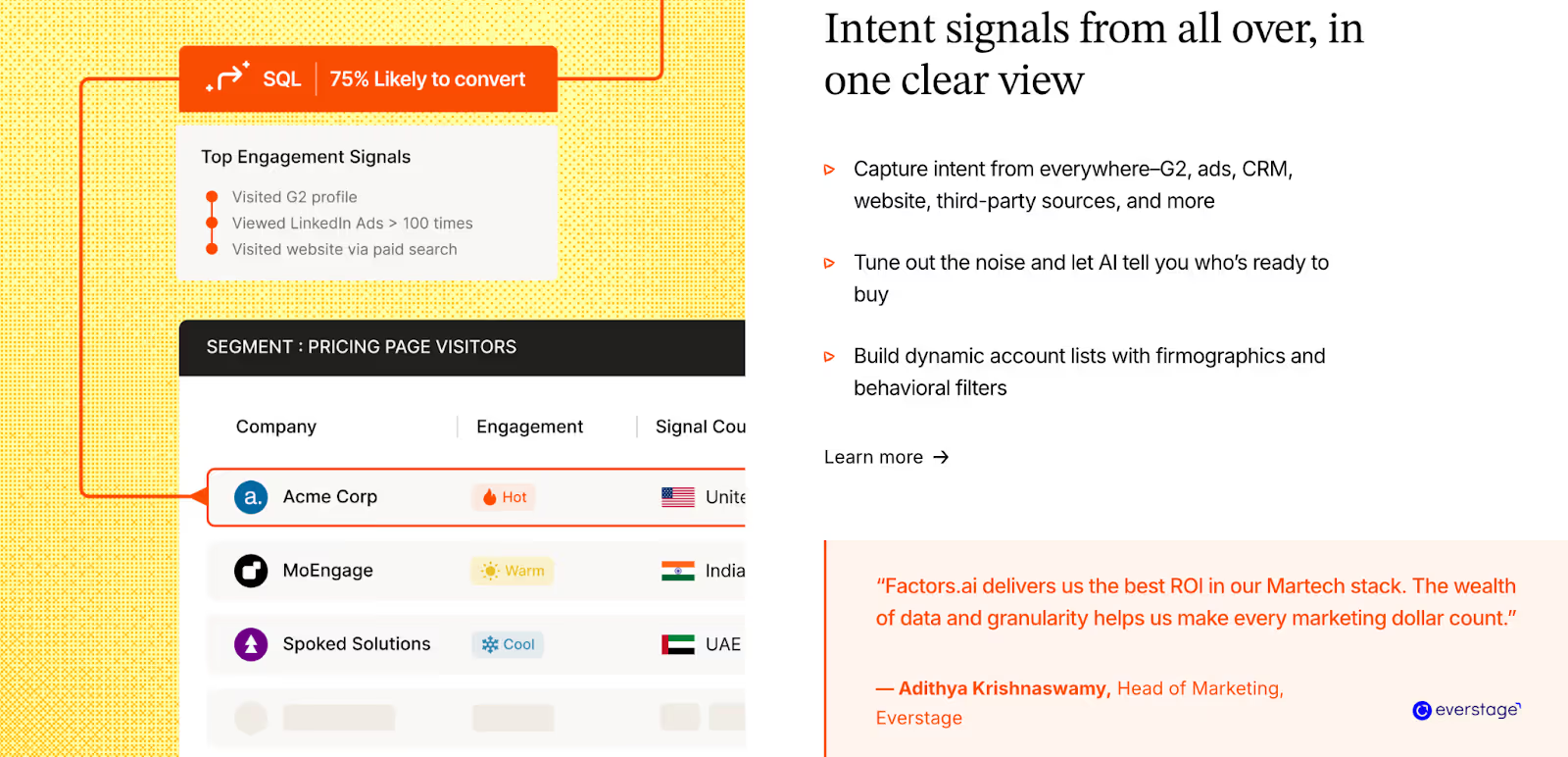
Factors.ai looks at intent as a connected system rather than a single activity. It combines signals from across your tech stack to give both marketing and sales a shared understanding of where each account stands.
AND because intent is pulled from multiple systems, it reflects real buying behavior rather than isolated actions. This helps teams prioritize accounts before they raise their hand, which is often where the biggest revenue opportunities sit.
Key capabilities:
- Multi-Layered Intent Tracking: combines web visits, CRM updates, ad engagement, and product usage.
- Buying-Group Detection: identifies multiple stakeholders interacting with your brand from the same company.
- Intent Scoring: ranks accounts by fit, funnel position, and level of activity.
- Milestones: shows when an account crosses key engagement thresholds, like demo requests or product revisits.
- AI-Powered Insights: surfaces patterns automatically, helping teams prioritize the next best action.
This approach gives GTM teams the clarity to act on intent early, not just react after conversion.
Influ2 Intent Signals and Buyer Insights
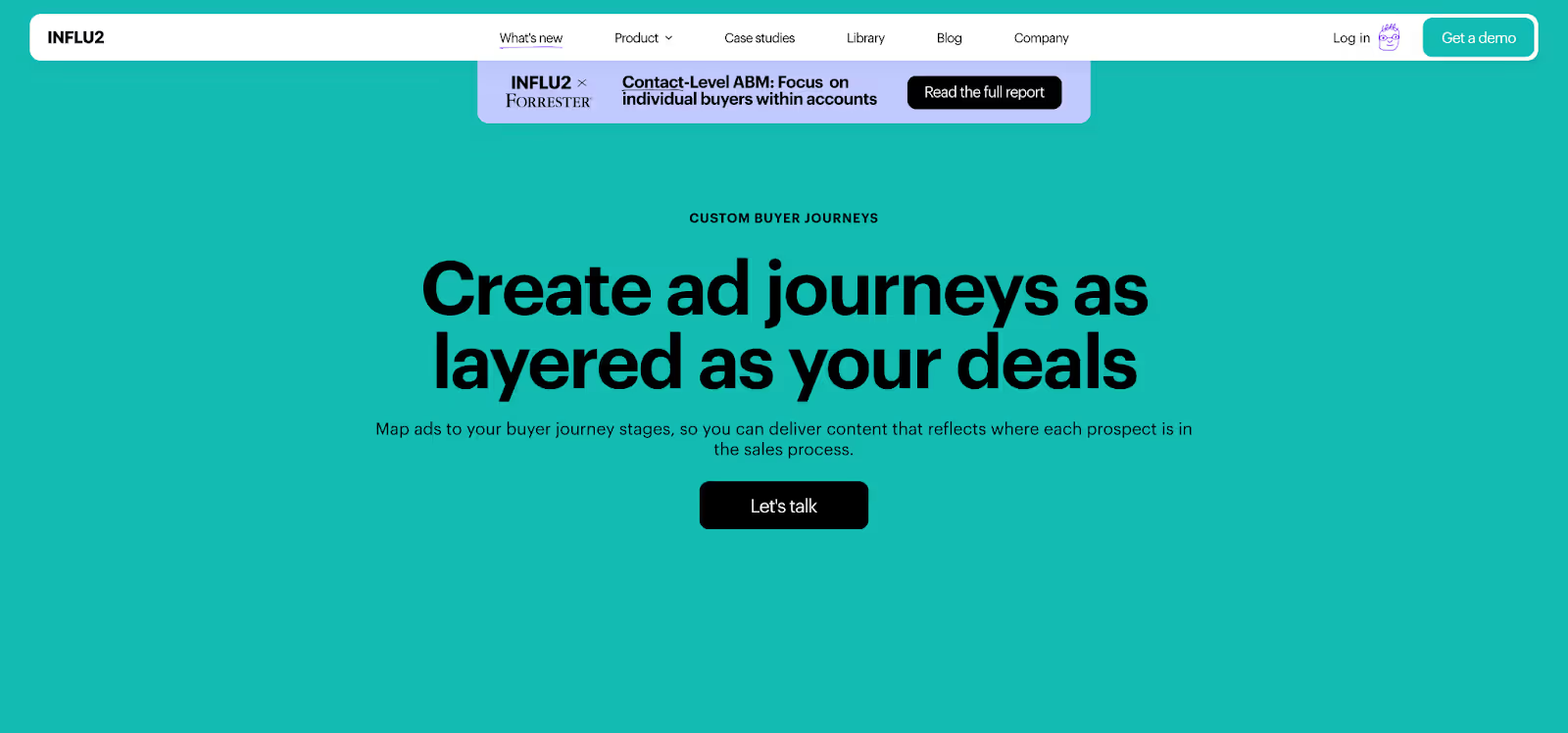
Influ2 focuses on intent that comes directly from advertising engagement. It measures who saw your ads, how often they interacted, and whether that engagement led to any downstream activity.
This model gives clean, defensible signals tied directly to advertising engagement. When your goal is proving ad influence and supporting sales conversations, that level of precision is extremely useful.
Key capabilities:
- Contact-Level Intent Tracking: tracks ad views, clicks, and post-ad engagement for specific individuals.
- Engagement Scoring: highlights contacts most responsive to your campaigns.
- Journey Mapping for Ads: aligns ad messaging with buyer stages to personalize outreach.
- Sales Notifications: alerts sales reps when a contact shows repeated engagement or conversion activity.
- Attribution Visibility: connects ad interactions to CRM data to show impact on pipeline or closed deals.
It gives marketing and sales a strong signal of personal interest which is a useful tool when targeting decision-makers already on your radar.
Factors vs Influ2: Verdict on Intent Signals and Buyer Insights
Influ2 delivers highly specific intent tied to individuals, making it ideal for account-based programs where contact lists are well-defined.
It tells you exactly who engaged with which campaign.
Factors.ai expands the scope to show not just who engaged, but what that engagement means at the account level.
By connecting multiple data sources and mapping collective buying behavior, it gives teams a clearer, actionable view of the full funnel.
In short:
Factors.ai = Multi-signal intent visibility across accounts and buying groups.
Influ2 = Contact-level intent focused on ad engagement accuracy.
Want a playbook? Read how to turn intent into demos in our intent-to-insight guide.
Factors vs Influ2: Ad Activation and Campaign Management
Ad activation is where strategy meets execution like this… 🤝.
(This is also where many teams lose efficiency due to manual audience updates and outdated targeting.)
Automation versus control is the CORE tension here.
The right tool helps you adapt, ensuring ads reach the right audience at the right time with minimal manual effort.
Both Factors.ai and Influ2 are strong in this space, but their focus differs.
Factors.ai drives campaign activation using AI, funnel data, and audience automation, while Influ2 emphasizes direct, contact-level ad delivery for precision targeting.
Ad Activation and Campaign Management Comparison
Factors.ai Ad Activation and Campaign Management
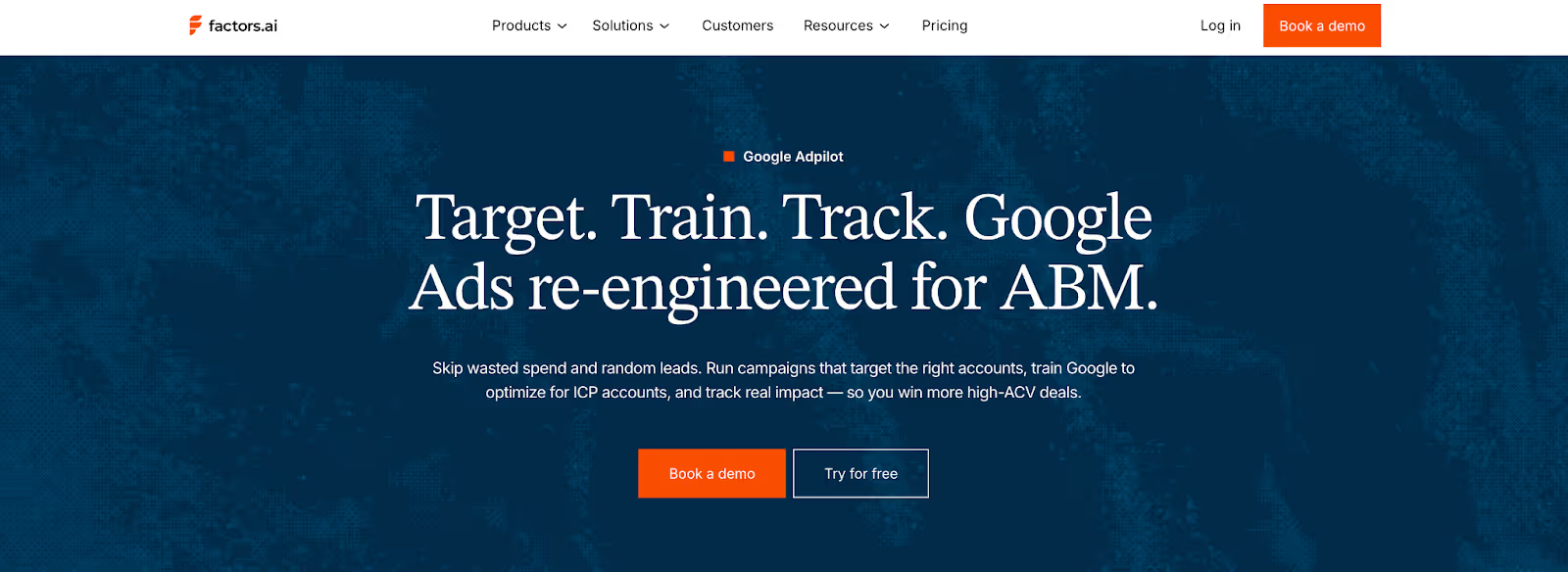
Factors.ai automates activation through intent-driven logic that syncs directly with your ad platforms.
Instead of broad targeting, it creates audiences dynamically based on who’s showing buying intent and where they are in the funnel.
Here, the biggest benefit I’ve seen is reduced waste. When audiences refresh automatically based on real intent and funnel movement, ads stay relevant without daily babysitting.
Key capabilities:
- LinkedIn AdPilot: activates and refreshes LinkedIn campaigns automatically based on account signals.
- Google AdPilot: pushes enhanced conversion signals using Google CAPI to optimize for pipeline-ready accounts.
- Buyer-Stage Campaigns: adapts ad creative and targeting as accounts move through awareness, consideration, and decision stage.
- Audience Suppression: removes inactive or irrelevant accounts to save ad spend.
- Real-Time Data Sync: updates audiences daily to ensure accuracy and freshness.
This setup means your ad campaigns stay relevant without needing constant manual updates.
It’s especially useful for teams running multi-stage GTM campaigns who want to align paid media with real-time intent.
Influ2 Ad Activation and Campaign Management
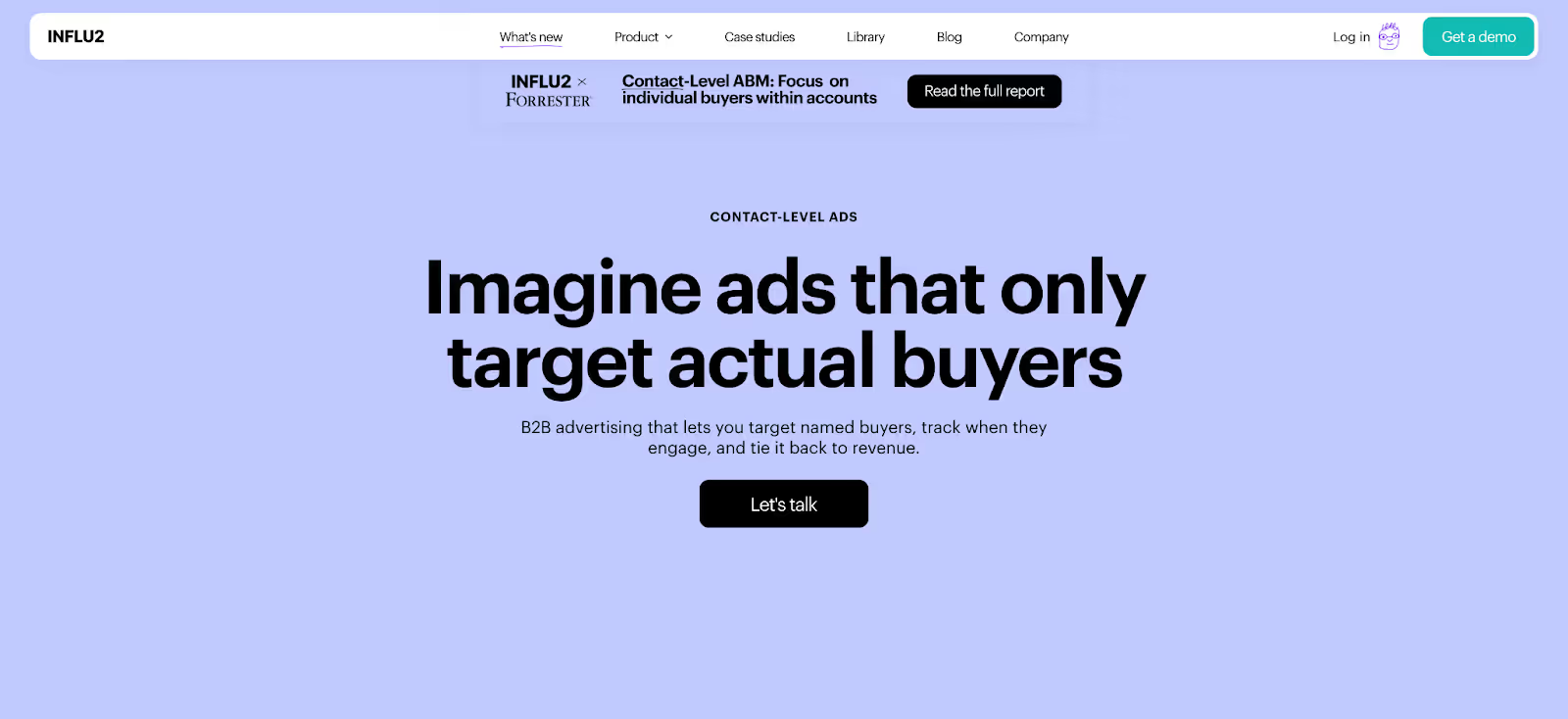
Influ2 treats ad activation at the person level.
It connects directly to your CRM, takes the list of named contacts, and serves ads only to those specific individuals across major ad networks.
This approach offers more direct control and broader channel reach. It works best when teams are comfortable managing defined contact lists and want visibility into every impression served.
Key capabilities:
- CRM-Based Targeting: syncs contacts from Salesforce, HubSpot, or Marketo to build precise audience lists.
- Cross-Channel Reach: runs campaigns across LinkedIn, Google, Meta, Bing, and Amazon.
- Personalized Ads: allows creative variations tailored to roles or funnel stages.
- Engagement Reporting: tracks which contacts viewed or clicked an ad, giving clear attribution.
- Sales Notifications: alerts reps when key contacts interact with campaigns.
This method ensures your ads only reach the people who matter most, helping reduce wasted impressions and improving sales alignment.
However, it requires pre-defined contact lists and doesn’t automate ad refreshes based on live intent signals like Factors.ai does.
Factors vs Influ2: Verdict on Ad Activation & Campaign Management
Influ2 delivers outstanding precision at the individual level, ideal for targeted ABM efforts where your contact list is clearly defined.
It shines in reach and control, especially across multiple ad networks.
Factors.ai, however, takes activation a step further.
By automating campaigns around real-time intent and funnel stages, it helps teams continuously optimize ad spend while keeping audiences current.
In short:
Factors.ai = Intent-based, automated ad orchestration that scales with your GTM funnel.
Influ2 = Contact-level targeting for high-precision, cross-channel advertising.
Factors vs Influ2: Analytics, Reporting and Revenue Attribution
Analytics should answer one question clearly: what actually moved revenue forward?
Clicks and impressions are easy to count. Understanding influence across a long B2B buying cycle is not. And for GTM and marketing teams… collecting data is never the end goal, interpreting it is.
The real impact of analytics comes from how clearly a platform connects engagement, conversion, and revenue.
Both Factors.ai and Influ2 offer strong visibility into performance, but their analytics depth and focus differ.
Factors.ai gives a holistic, full-funnel view linking every touchpoint to revenue, while Influ2 focuses more on tracking how ads influence known contacts and opportunities.
Analytics, Reporting and Revenue Attribution Comparison
Factors.ai Analytics, Reporting and Revenue Attribution
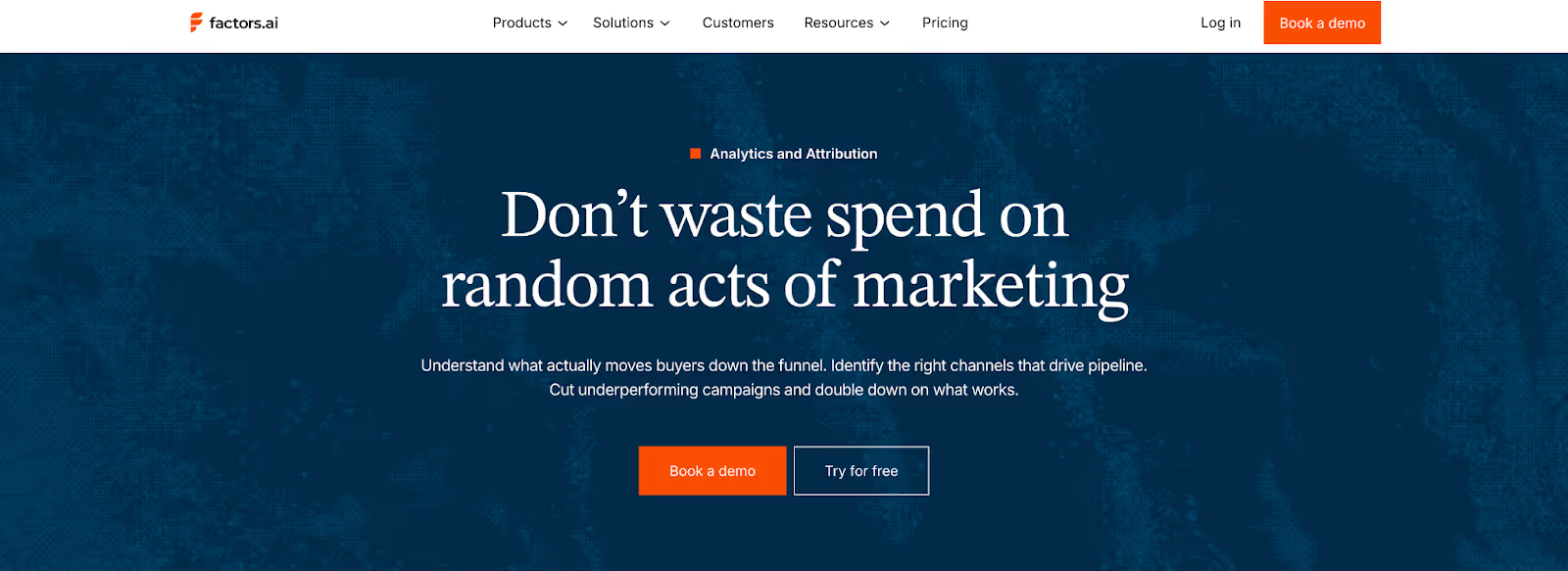
Factors.ai brings structure and visibility to GTM performance by tracking every touchpoint across the customer journey. Having marketing and sales look at the same revenue story changes conversations (and builds friendships that seemed impossible #IYKYK). Attribution stops being defensive and starts becoming strategic.
Factors.ai’s analytics map behavior from first visit to deal closure.
Key capabilities:
- Milestones: tracks key funnel movements such as demo requests, proposal sent, or deal won.
- Attribution Models: identifies which campaigns or channels contributed most to pipeline creation.
- Account 360: consolidates engagement data into a single view that connects marketing and sales outcomes.
- Custom Reporting: allows users to build dashboards that reflect revenue contribution by channel, region, or campaign type.
- Cross-Channel View: integrates website analytics, CRM data, and ad performance to offer a unified perspective.
Together, these features help teams see what’s driving pipeline growth and not just where clicks are coming from.
Influ2 Analytics, Reporting and Revenue Attribution
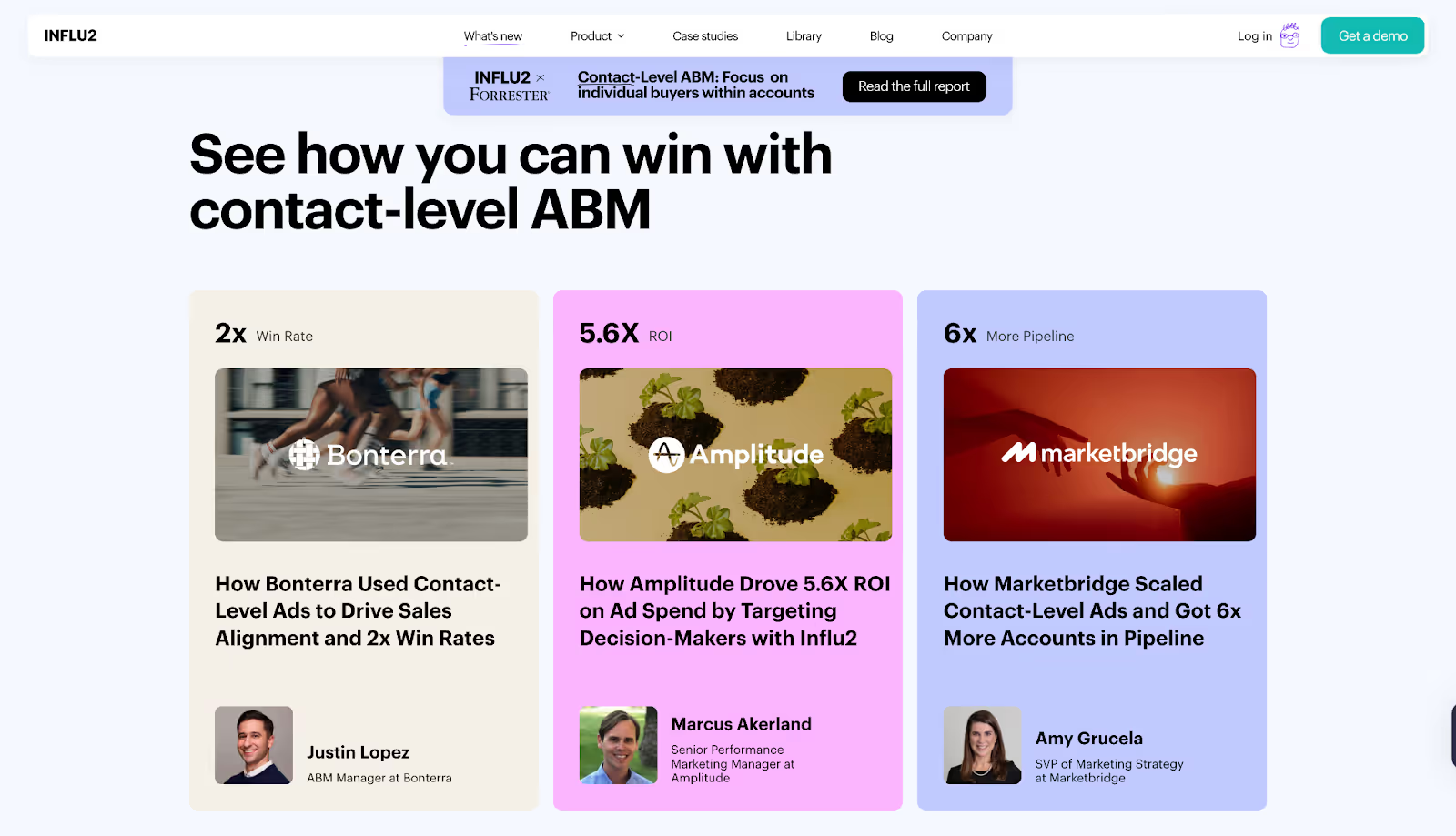
Influ2 delivers analytics designed to prove the influence of advertising on sales outcomes.
It connects ad impressions and clicks with named contacts in the CRM, helping teams validate whether campaigns actually drive engagement and revenue.
This is useful for validating ad spend in ABM programs. Sales teams appreciate seeing tangible proof of engagement before outreach.
Key capabilities:
- Contact-Level Attribution: measures which ads specific contacts viewed or engaged with.
- Campaign Impact Reporting: shows how ad exposure influenced opportunity creation or pipeline velocity.
- Engagement Frequency Tracking: monitors how often contacts interacted with your ads and what stage they were in when they did.
- ROI Metrics: highlights which ad campaigns influenced closed-won deals.
- Sales Insights: provides data sales teams can use for more relevant outreach.
This type of reporting helps prove the real-world value of targeted advertising, especially in ABM setups where direct attribution matters most.
Factors vs Influ2: Verdict on Analytics, Reporting & Revenue Attribution
Influ2 gives clarity at the contact level.
It’s well-suited for organizations that want to measure exactly how advertising engagement influences pipeline and closed-won deals.
Factors.ai takes a broader approach, connecting all signals including web, ads, CRM, and product, into one cohesive revenue picture.
It helps marketing and sales teams understand which channels drive actual business outcomes, not just engagement.
In short:
Factors.ai = Complete, full-funnel analytics linking engagement to revenue.
Influ2 = Contact-level visibility focused on ad influence and ROI validation.
For attribution detail, our types of attribution models guide explains when to use each model.
Factors vs Influ2: Support, Onboarding and Services
Ever seen a building without pillars? Ummm… exactly. The right platform is only as effective as the support behind it (AKA pillars).
Smooth onboarding and reliable assistance can turn complex setups into steady operations.
Both Factors.ai and Influ2 provide customer support, but Factors.ai takes it further by offering hands-on GTM engineering services which is something that most platforms leave entirely to the customer.
Support, Onboarding and Services Comparison
Factors.ai Support, Onboarding and Services

Factors.ai focuses on long-term partnership rather than simple onboarding. Every plan includes structured setup support, but the experience becomes more personalized as you move up tiers.
The engineering support here closes a reeeeaaaal gap. Many teams don’t want another agency. They want the platform itself to help them operationalize GTM ideas quickly.
Key highlights:
- White-Glove Onboarding: guided setup for integrations, dashboards, and ad automation.
- Dedicated CSM: available for ongoing check-ins, optimization, and progress tracking.
- Slack Channel Access: ensures fast communication and real-time feedback.
- Weekly GTM Reviews: collaborative sessions to align campaign insights and next steps.
- GTM Engineering Services: available as an add-on for deeper operational support, includes workflow automation, data synchronization, and reporting assistance.
For companies that want both software and execution help under one roof, this model provides exceptional value.
Influ2 Support, Onboarding and Services
Influ2 offers a straightforward customer success experience that centers around campaign performance and ad optimization. Most support activities happen through its CSM team, which guides users during setup and continues providing help as campaigns evolve.
This model works well for teams with internal resources or agency partners who already handle execution.
Key highlights:
- CSM-Led Onboarding: includes training, campaign setup guidance, and best practices.
- Strategic Check-Ins: periodic reviews to discuss performance metrics.
- Email & Ticket Support: available for troubleshooting and platform queries.
- Educational Resources: includes case studies, product blogs, and a help center.
The process is reliable and personal, but it lacks the deeper operational support that Factors.ai provides through its engineering services.
Verdict on Support, Onboarding and Services
Influ2 offers dependable customer success support with guidance that keeps campaigns on track.
It’s built for teams that already have internal technical resources or agency partners.
Factors.ai adds more depth to the experience.
With structured onboarding, proactive communication, and optional GTM engineering services, it ensures that every team (technical or not) can get the most from the platform.
In short:
Factors.ai = Strategic onboarding with hands-on GTM and engineering support.
Influ2 = Reliable customer success model focused on campaign guidance.
Factors vs Influ2: Security and Compliance
Security conversations usually surface late in the buying process, but they often decide the final outcome (and that kinda sucks). Especially for enterprise GTM teams handling CRM and ad data.
In B2B software (and in life), trust depends on how safely a platform handles customer data.
Security and compliance defines whether a product can support large-scale, data-driven operations with confidence.
Both Factors.ai and Influ2 maintain strong protection standards, though Factors.ai strengthens its position with wider certifications and enterprise-focused controls.
Security and Compliance Comparison
Factors.ai Security and Compliance

Factors.ai treats data protection as a fundamental part of its platform architecture.
Its operations follow strict compliance standards designed to meet enterprise security needs.
Key measures include:
- ISO 27001 and SOC II Type 2 certification: ensures data confidentiality, integrity, and operational control.
- Secure Infrastructure: hosted on Google Cloud’s SOC-certified environment with restricted physical and digital access.
- Data Encryption: AES-256 for data at rest and TLS-secured transmission with SHA-2 compliant cipher suites.
- Access Control: limited to authorized personnel through role-based access and 2FA.
- Disaster Recovery: multiple backups stored across locations to ensure business continuity.
For teams handling sensitive CRM and marketing data, these layers provide enterprise-grade reliability and peace of mind.
Influ2’s Security and Compliance

Influ2 maintains strong security standards aligned with modern SaaS best practices.
It focuses on safeguarding user data through encryption, limited access, and compliance with major privacy regulations.
Key measures include:
- SOC 2 Type II Certification: validates internal controls and data management processes.
- GDPR & CCPA Compliance: ensures responsible handling of customer data across regions.
- Data Encryption: AES-256 encryption for stored and transmitted data.
- Access Restriction: internal teams have limited access to customer data with audit logging in place.
- Backup Systems: daily automated backups with recovery protocols to minimize data loss.
While its security framework covers all essential requirements, it doesn’t extend into certifications like ISO 27001 or offer public documentation of advanced data management policies like Factors.ai does.
Factors vs Influ2: Verdict on Security and Compliance
Influ2 provides a strong, compliant security setup suitable for most mid-market and enterprise organizations.
It follows best practices and maintains solid encryption and monitoring standards.
Factors.ai builds on those foundations with additional certifications, advanced infrastructure control, and publicly available compliance documentation.
It’s structured to support enterprise teams that require audited, verifiable data protection standards.
In short:
Factors.ai = Enterprise-grade compliance with ISO and SOC II certifications.
Influ2 = Strong foundational security built on SOC 2 and GDPR compliance.
Factors vs Influ2: Which tool to choose when?
Both Factors.ai and Influ2 help B2B teams reach the same goal: turning engagement into revenue. But the way they get there is very different.
Influ2 is built for precision. It’s ideal for marketers who already know their target contacts and want to reach them with ads that can be directly tied to engagement and revenue.
Its biggest strength lies in visibility and showing how advertising connects to specific people and opportunities.
It fits well with teams that already have mature ABM programs and defined account lists.
Factors.ai is built for scale and connection.
It brings together everything that happens across marketing and sales, from identifying high-intent accounts to activating ads and measuring what drives growth.
Its integrated approach, supported by analytics, automation, and optional GTM services, makes it a stronger choice for teams that want their systems and workflows to work together.
To put it simply:
- Influ2 helps you reach the right people.
- Factors.ai helps you grow pipeline.
FAQs for Factors.ai vs Influ2
Q. What is the main difference between Factors.ai and Influ2?
The biggest difference lies in scope. Factors.ai is designed to connect and run your entire GTM motion, from account identification and intent tracking to ad activation and revenue analytics. Influ2 focuses primarily on contact-level advertising, helping teams show ads to known individuals and track how those ads influence pipeline and revenue.
Q. Is Influ2 an alternative to Factors.ai?
Influ2 can be an alternative if your primary goal is advertising to known contacts within defined ABM programs. If your GTM strategy requires account discovery, multi-signal intent, funnel visibility, and automated activation across stages, Factors.ai is built to support that broader motion rather than just advertising execution.
Q. Which platform is better for account-based marketing?
Both platforms support ABM, but in different ways. Influ2 works well for highly targeted ABM campaigns where contacts are already known and synced from CRM. Factors.ai supports ABM at scale by identifying high-intent accounts, mapping buying-group behavior, and automating campaigns as accounts move through the funnel.
Q. Does Influ2 help identify new accounts or buyers?
No. Influ2 does not focus on discovering new accounts. It operates on CRM-synced contact lists and is designed to engage people you already know. Factors.ai, on the other hand, helps identify in-market accounts using website, ad, CRM, and product signals, even before contacts are fully known.
Q. How do Factors.ai and Influ2 differ in intent data?
Influ2 tracks intent primarily through ad engagement at the individual level, such as views, clicks, and conversions. Factors.ai combines multiple intent sources, including website behavior, CRM activity, ad interactions, and product usage, to build a more complete picture of account-level buying readiness.
Q. Which platform offers better ad automation?
Factors.ai offers deeper automation by dynamically syncing audiences and triggering campaigns based on real-time intent and funnel movement. Influ2 offers precise ad delivery to named contacts but relies more on manually defined CRM lists rather than intent-driven automation.
Q. Is Factors.ai suitable for smaller or growing GTM teams?
Yes. Factors.ai offers a free plan and usage-based tiers that allow teams to start small and scale gradually. Its pricing structure and optional GTM engineering support make it accessible for startups, mid-market teams, and enterprise organizations alike.
Q. Does Influ2 provide revenue attribution?
Yes. Influ2 provides contact-level attribution that shows how ad exposure influenced opportunities and closed-won deals. Factors.ai goes further by offering full-funnel attribution that connects ads, website activity, CRM movement, and revenue across the entire account journey.
Q. Which platform is better for sales alignment?
Both improve sales alignment, but in different ways. Influ2 helps sales teams see which specific contacts engaged with ads. Factors.ai helps sales understand which accounts are in-market, where they sit in the funnel, and which signals suggest outreach is timely.
Q. How should GTM teams choose between Factors.ai and Influ2?
Teams should start by looking at how their GTM engine actually operates. If advertising to known contacts and proving ad influence is the priority, Influ2 is a strong fit. If the goal is to connect intent, activation, analytics, and revenue across the full GTM lifecycle, Factors.ai offers a more comprehensive solution.
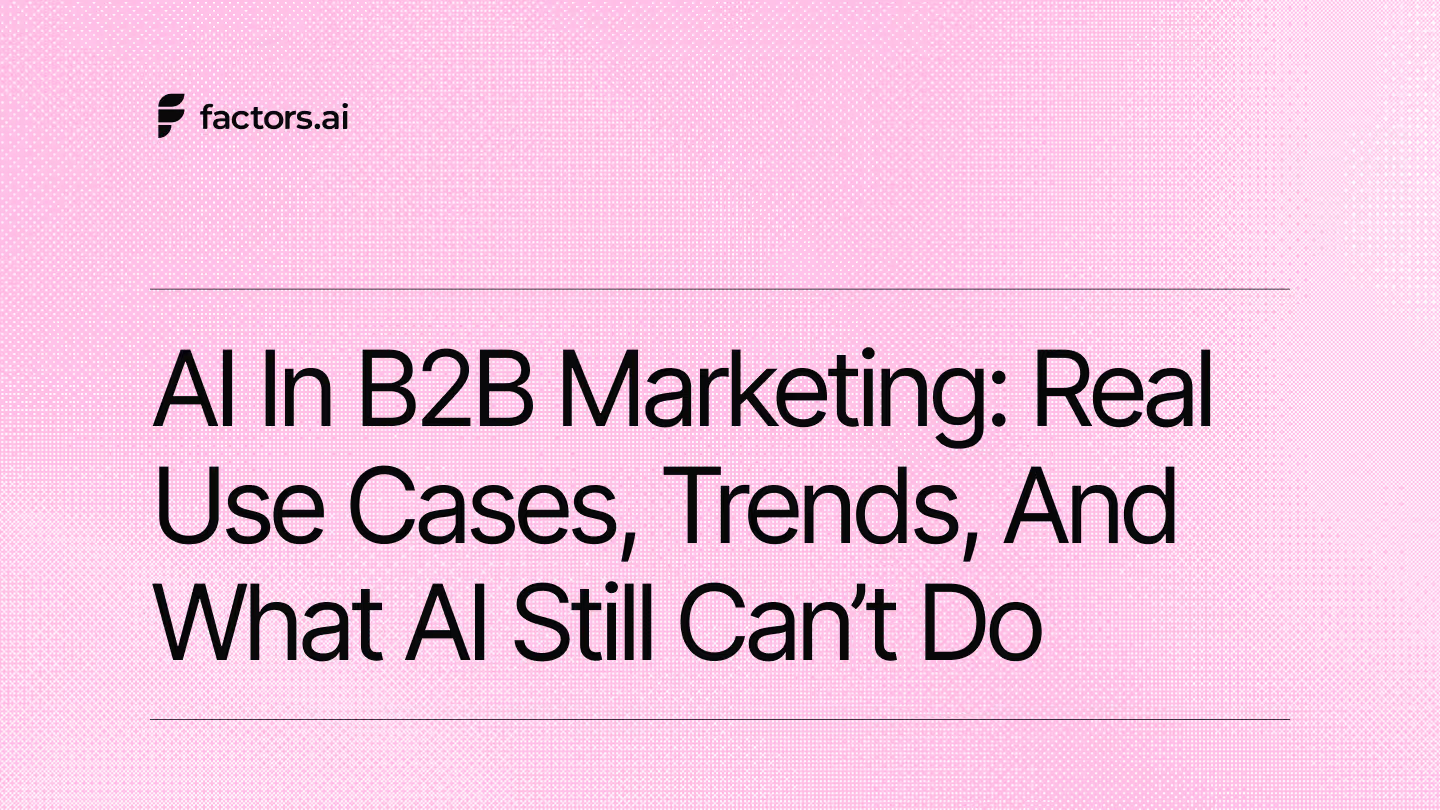
AI in B2B Marketing: Real Use Cases, Trends, and What AI Still Can’t Do
When AI walked into B2B marketing, it came with big promises to ‘revolutionize’ the space and bigger fears… replace teams, automate thinking, and outpace humans at every turn.
Both didn’t happen. What has happened is something more complicated.
AI is everywhere now, yet most B2B teams still struggle to connect it to real GTM decisions. They have a bunch of insights from various AI marketing tools, but knowing what to do with them – and actually doing it – is still difficult.
This article talks about that gap. It looks at how AI is currently being used in B2B marketing today, where it helps, where it lags, and how strong teams utilize it to get optimal value from AI without letting it run the show.
TL;DR
- AI in B2B marketing works best when it improves both execution and decisions.
- Most teams struggle with turning signals received from their AI tools into action.
- AI is most effective when applied at the account and workflow level, instead of isolated tasks.
- Generative AI speeds things up, but human judgment still decides what matters.
- Best impact comes from combining AI insights with clear GTM orchestration.
What does AI in B2B marketing actually mean?
When people talk about AI in B2B marketing, they often conflate very different things. That’s where confusion starts.
At its core, AI in B2B marketing means using machine learning to process signals faster than humans can, to improve marketing decisions.
In practice, AI does four things B2B teams struggle to do manually at scale:
- Analyze behavior across systems
AI pulls together signals from CRM data, website activity, ad engagement, email interactions, product usage, and sales notes. This is important because B2B journeys are fragmented, and without AI, you won’t see the full picture.
- Predict intent and likelihood to act
Instead of treating all leads or accounts equally, AI looks for patterns that historically led to conversions, pipeline movement, or churn. This helps your teams move from reactive marketing to prioritized action.
- Personalize customer experiences without hand-building everything
AI adapts messaging, timing, and content based on behavior and context. It personalizes beyond “Hi, John!” by adjusting what is sent, when it is sent, and to whom, based on how an account behaves in real time.
- Optimize decisions early on
With insights from AI, you can spot issues early. Instead of reviewing what went wrong later, you can adjust spend, outreach, routing, or messaging in real-time.
Most B2B teams use AI across three layers.
- Generative AI: The generative AI layer helps create. It’s mostly used for creating drafts for ads and emails. Beyond that, it also helps with topic ideation, content outlines, message variants, sales enablement drafts, customer interaction call summaries, and content repurposing. It’s great at speed, but it has no sense of context on its own.
- Predictive and analytical AI: This layer helps in decision-making. It handles lead and account scoring, intent detection, win-loss analysis, forecasting, and performance evaluation.
- Orchestration and workflow AI: Finally, this layer helps in action-taking. It routes accounts, triggers outreach, syncs systems, and turns insights into movement.
Most teams stop at creation and wonder why results feel underwhelming. Once you run these layers together, you end up utilizing artificial intelligence for what it’s meant to do: help you make better decisions consistently.
Where AI is used in B2B marketing today
Now that you understand AI works in layers, let’s see how it is used practically in B2B marketing for better decision-making and reducing repetitive tasks.
- Content generation and content strategy:
People think AI helps in creating content fast, but its real value lies in helping you decide what deserves to be written in the first place.
AI, here, looks at how people actually search and what already exists on the internet. It analyzes search queries, groups related keywords into themes, and compares your content against competitors to spot gaps. It also suggests outlines based on how top-performing pages are structured and flags older content that needs updating or better internal linking.
You still decide the voice, angle, and point of view. AI helps narrow down the field so you don’t spend weeks on a content creation process that was never going to rank or convert.
- Paid media and performance marketing:
The thing about paid marketing is that it moves fast, but feedback often comes too late.
AI helps your team react earlier. It generates creative variations of ad copies based on what’s already working, tags marketing campaigns that are likely to fatigue, and recommends budget shifts so that you don’t end up spending more on inefficient campaigns. When performance dips, it can correlate creative, audience, and timing signals to show where the problem might be.
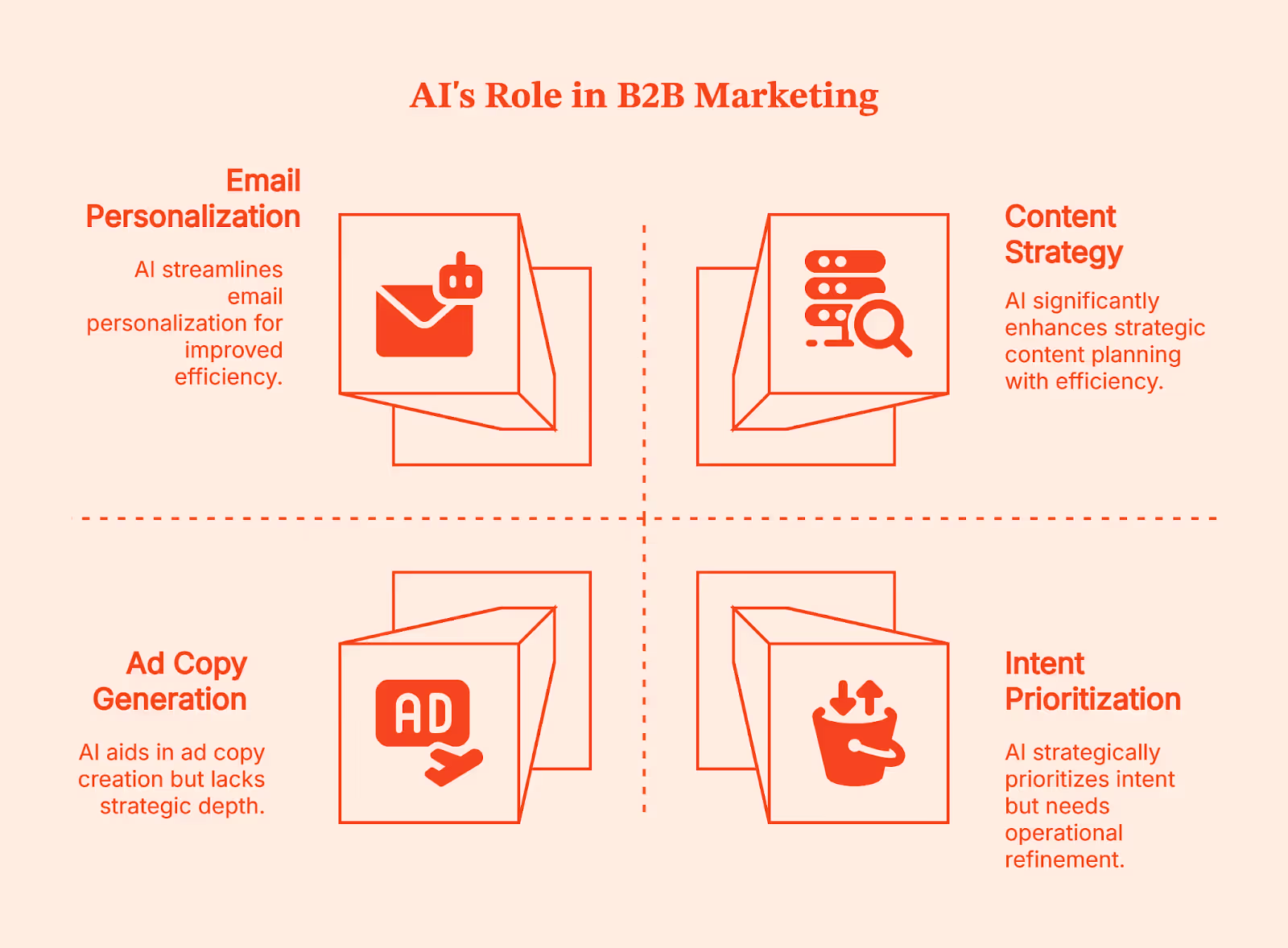
- Email, lifecycle, and personalization:
People think the challenge here is scale – but the real challenge is relevance. AI continuously tests subject lines and previews text, triggers messages based on real behavior, and adjusts outreach at the account level based on engagement. It can even hold back messages when signals suggest someone isn’t ready yet. This way, you end up sending fewer, more targeted emails with better timing and higher response rates.
- Intent, scoring, and prioritization:
This is where AI starts to influence revenue decisions. It analyzes behavior across channels to identify which accounts are warming up, enabling your team to prioritize outreach. It updates scores as buying groups grow or stall and helps align ABM efforts with real-time intent signals.
Across all these areas, AI works best as your intern. It gathers information, spots patterns in customer journeys, and brings you options. But it still needs direction, review, and a final call from someone who understands the business.
Real AI marketing examples in B2B
Theoretically, it all makes sense. But seeing how AI works in very specific moments inside everyday B2B workflows and influences GTM decisions makes it easy to understand.
- Demand generation: reallocating spend based on intent
The most difficult decision your demand generation must make is to take a call about when to shift focus. AI makes this easier for your team by looking for intent signals like website behavior across pages and sessions, ad engagement by account, content consumption patterns over time, and CRM activity.
When AI is utilized optimally in demand gen, it leads to very concrete actions that result in campaign optimization by pausing low-intent marketing campaigns early, reallocating spend toward high-intent accounts, and coordinating ads and outbound for the same buying group.
- Product marketing: refining messaging using win-loss signals
Now, let’s look at the product marketing team. Their decisions are often based on opinions that aren’t backed by evidence. AI steps in here as a pattern detector. It helps your team by consolidating win-loss notes and call transcripts, objection patterns tied to deal outcomes, feature usage and adoption data, and competitor messaging changes over time.
This helps product marketers see patterns in lost deals:
- Certain phrases appear repeatedly either before deals move forward or right before deals fall apart.
- Some features are mentioned constantly but are barely used, while others slowly drive retention.
This obviously helps your team in making smart decisions like removing or reframing weak messaging, updating sales enablement based on real buyer language, aligning positioning with actual product usage, etc.
- RevOps: connecting multi-touch journeys for attribution
RevOps feels the pain of disconnected data more than anyone. Long B2B buying cycles make attribution messy, and it’s difficult to pin down what worked (in case of a win) and what didn’t (in case the deal is lost).
For this segment, AI connects long, messy, and chaotic buyer journeys. It analyzes every touchpoint across ads, content, emails, demos, and sales interactions over weeks or months and highlights which sequences consistently moved the deals forward and which didn’t.
Armed with these data-driven insights, your team can adjust routing, scoring, and handoffs. You also get cleaner reporting, better alignment between marketing and sales teams, and smarter investment decisions.
AI marketing tools for B2B: ownership matters more than features
By now, most B2B teams have tried AI marketing tools, and yet they are still scratching their heads about why it isn’t working the way they expected.
In my experience, the problem isn’t tool-specific. It's more to do with who owns the decisions and which decisions it influences.
If you look at your tech stack, you’ll realize your team already has a bunch of tools they are barely using. Some were meant to 10X your content output, others (predictive analytics tools) promised to transform decisions. Initially, your teams got excited about these tools, but by the third month, they forget their existence.
It’s a common scenario:
- Your generative AI creates 50 email variants, but who decides which three to test?
- Your intent platform flags 40 accounts showing buying signals, but who follows up within 24 hours?
- Your attribution model shows mid-funnel content drives pipeline, but who has the authority to shift the budget based on that?
Without clear ownership, every insight remains an insight rather than a direction.
Strong teams work backwards from decisions. They don't ask "which AI marketing tool should we buy?" Instead, they ask, "What decision needs to happen faster?" Then they assign one owner, create one ritual, and close the loop.
For example, say a Series B SaaS company had 6sense, but their wasn't changing their behaviour/processes based on the insights from 6sense. Every account got equal treatment, and the pipeline was erratic. To refine the process, they need to clearly define:
- Which decision does it influence? Identify accounts sales must prioritize this week
- How does the tool help? Score accounts based on intent.
- Who’s accountable? RevOps updates scoring monthly, and sales lead identifies accounts weekly.
- How to build it into a habit? For example, Monday morning, review top 20, pick 10, no debate until next week.
If you can't answer these questions clearly, you're just adding another tool to your tech stack.
Remember: Teams winning with AI use fewer tools and exercise greater discipline. They've built the structure to turn insights into action before they go stale.
💡Check out our guide on how to interpret correlated data in B2B marketing
Artificial Intelligence (AI) in product marketing (B2B context)
Product marketing decisions suffer from too many partial truths. When sales, marketing, and product teams see a different reality (that tells them only one part of the story), it’s time for you to bring in AI.
Implementing AI in product marketing is like using a synthesizer, where four different elements come together:
- Persona analysis:
Traditionally, persona analysis relies on interviews and surveys on customer behavior that age quickly. AI changes this by analyzing inputs and customer data that product marketers come across every day:
- transactional sales call transcripts
- demo notes
- onboarding behavior
- feature usage
- churn reasons
- support tickets
Instead of asking "who is our buyer?" once a year, AI tells your team how different buyer groups actually behave over time.
- Messaging validation:
Product marketers test messaging across landing pages, emails, sales decks, outbound sequences, ad copy, in-app prompts, onboarding flows, help documents, pricing pages, etc. AI analyzes which phrases correlate with pipeline movement and which ones stall deals.
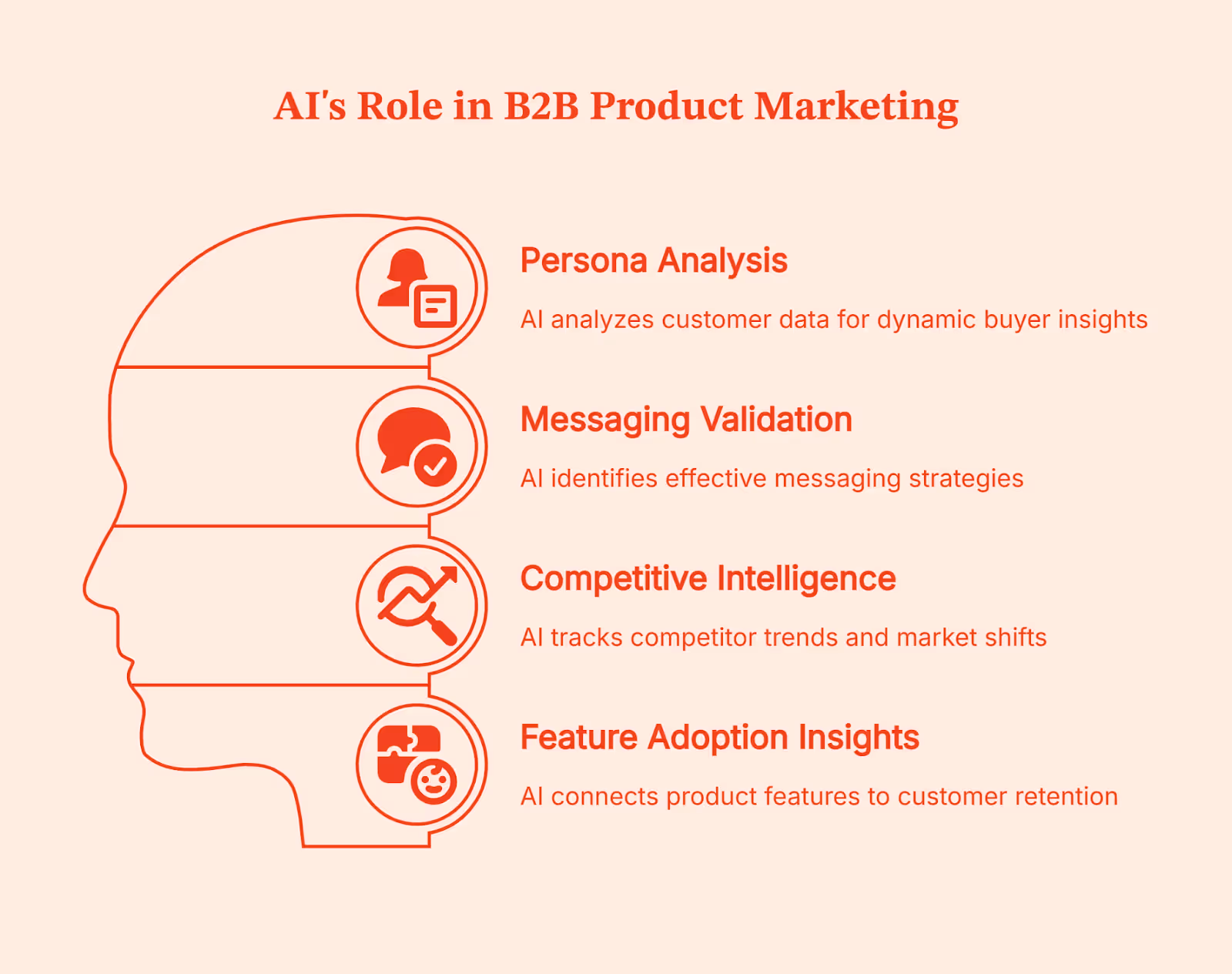
- Competitive intelligence:
Competitive intelligence shifts the burden from manual monitoring to pattern recognition. AI here tracks how competitors talk about themselves over time, indicating when certain claims become table stakes and when a category narrative starts shifting. From this, AI also helps in deciding whether you should opt into the differentiation factor or reinforce credibility.
- Feature adoption insights:
The feature adoption insights help in connecting brand positioning to product reality. AI highlights which features correlate with retention, expansion, or early drop-off. Product marketers use this to decide what to emphasize, what to scale-down, and where messaging overpromises. This bridges the classic gap between what you promised on the roadmap and the actual customer experience.
💡Creating a framework for product-led growth is so easy. Check this guide.
Limitations of AI tools in B2B Marketing
While AI can help automate a lot of B2B processes, it comes with a set of limitations too:
- It has no business context:
AI doesn’t know your positioning, why deals fall through, or what trade-offs your sales team is making. It works on patterns, not marketing strategy. So, without clear context, the output might sound fine but is most likely to miss the mark.
- It hallucinates with confidence:
AI will fabricate stats, examples, or references if the data is weak or unclear. If your data is messy, AI will confidently amplify the mess.
- It breaks on edge cases:
Complex buying journeys, niche markets, or unusual sales motions are often not accounted for by this model, so it generates random patterns that don’t apply.
- Over-automation hurts brand trust:
Buyers easily notice and disengage from templated messages. AI can scale bad messaging just as fast as good messaging.
- Fragmented tools create chaos:
Conflicting signals, mismatched attribution, and dashboards full of “insights” with no clear next step only add to the confusion.
5 key trends shaping AI in B2B marketing
These AI trends are already changing the way B2B teams work. Teams are shifting from ‘just experimenting’ to using AI in significant decision-making processes.
- Decision intelligence is replacing task-level automation
AI is moving beyond basic task automation and into decision support. According to a survey, 62% of teams use AI-powered search and insights, showing a clear shift toward using AI to interpret data and guide actions.
- Account-level thinking is becoming the default
B2B marketers are focusing on whole accounts instead of single leads. This is visible in adoption patterns, too. 43% of organizations already use predictive analytics or recommendation systems, which rely on aggregated signals across accounts rather than single leads.
- AI embedded inside GTM workflows
AI is becoming part of core GTM workflows. It’s now embedded in lead and account scoring, intent detection, routing and assignment, outbound sequencing, attribution, and pipeline forecasting.
- Attribution and signal quality are rising priorities
As more teams rely on AI for insights, data quality is becoming a real bottleneck. 23% of organizations say poor data quality or data silos are a major barrier to getting value from AI, directly affecting attribution and signal accuracy
- Expectations for human marketers are rising
Marketing continues to lead AI adoption within organizations. 53% of companies say marketing teams are the primary drivers of AI use, raising expectations for strategy, judgment, and interpretation over raw execution.
How AI changes B2B marketing roles
As AI automates repetitive tasks such as content drafting, analysis, and basic optimization, marketers have more time to focus on strategy. Marketing roles have shifted from repetitive tasks to system design. Instead of pulling reports, teams are busy interpreting signals, building systems, defining rules, and streamlining workflows.
This also pulls Marketers closer to Sales, Product, and RevOps teams. Decisions are no longer isolated by channel; they cut across the funnel and require shared context. The value is shifting to judgment, prioritization, sequencing, and trade-offs. Knowing what to ignore is becoming just as important as knowing what to act on.
Where Factors fits: AI-enabled GTM engineering for B2B
At this point, you are already familiar with the ‘isolated data’ problem while working with various AI tools. Your team already has insights from the AI tools, yet someone asks, “So what should we do next?” because human guidance is still needed to steer them in the right direction.
This is what most B2B teams struggle with - a lack of connection.
But what if you could automate this, too? Impossible, right? Especially since we discussed that AI can’t decide on its own (for the entire length of this article). That’s the problem the GTM engineering system solves. It automates workflows so that you don’t have to make the same kind of decisions for ten different customers.
To automate the decision-making process, GTM engineering treats AI as one part of a larger system rather than a standalone tool/feature. With the help of AI, the GTM engineering system collects and interprets signals across website behavior, ads, CRM, and sales outreach, and then applies the rules your team has defined when those signals line up.
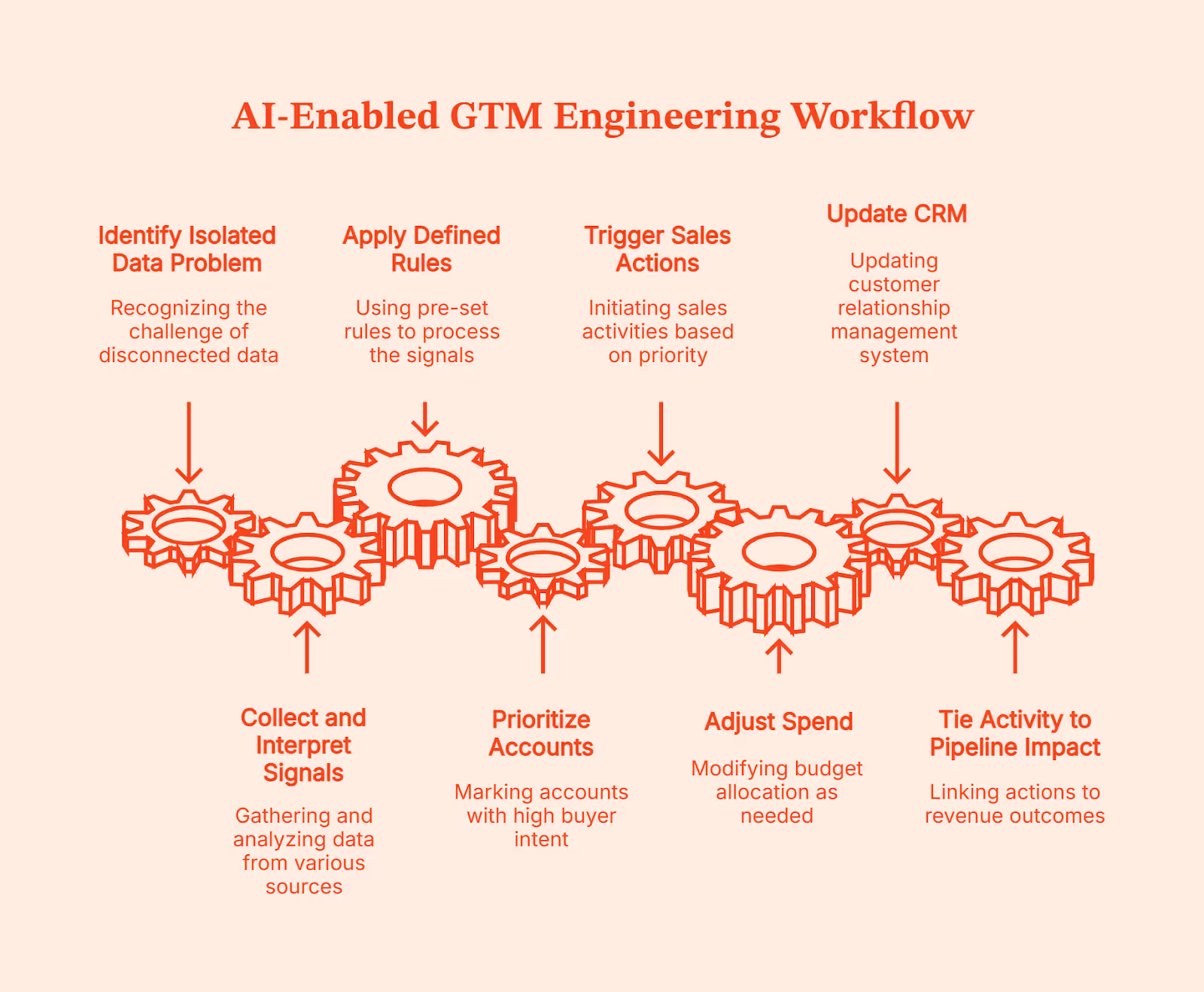
That’s what Factors.ai does. Factors.ai is an AI-enabled GTM system that unifies buying signals at the account level and helps teams act on them. When an account starts showing real buyer intent, it marks it as ‘high priority’ and executes the workflows your teams have already defined. Basically, Factors.ai’s GTM system will follow the process you’ve set:
- Accounts get prioritized
- Sales actions are triggered
- Spend is adjusted,
- CRM gets updated, and
- Activity is tied back to pipeline impact
Once these workflows are set, your team can work unilaterally without manual handoffs, following a clear path from signal to revenue.
Consensus: How to optimize AI in B2B marketing
Using AI in B2B marketing is more about optimizing those AI tools to enhance your decision-making rather than adding more to the tech stack.
Content marketers see the real impact of these AI tools when they use AI as a strategic partner, not as a replacement for thinking. They combine three things deliberately:
- AI handles speed, pattern recognition, and scale
- Human intelligence is responsible for judgment, context, and trade-offs, and
- GTM orchestration ensures insights actually turn into action across teams
When one of these is missing, AI either feels underwhelming or creates more chaos than clarity.
The future definitely isn’t about replacing marketing teams with AI. It’s about AI-powered content marketers focusing their time on critical judgments, deciding what matters, and what to do next.
FAQs on AI in B2B Marketing
Q. What is AI in B2B marketing?
AI in B2B marketing refers to using machine learning to analyze buyer behavior, predict intent, personalize experiences, and support better marketing and GTM decisions at scale, not to replace human strategy.
Q. How are B2B companies actually using AI today?
Most B2B companies use AI for content and search engine optimization (SEO) support, intent detection, lead and account prioritization, performance analysis, and workflow automation, mainly to improve focus and timing rather than fully automate marketing.
Q. What are the biggest limitations of AI in B2B marketing?
AI lacks business context, struggles with edge cases, and can produce confident but incorrect outputs, especially when data is fragmented or workflows aren’t clearly defined.
Q. How does AI support account-based marketing?
AI supports ABM by identifying in-market accounts, tracking buying group behavior, prioritizing outreach, and helping teams coordinate ads, content, and sales actions for the same group of target companies.
Q. How do you measure ROI from AI in B2B marketing?
ROI is measured by improvements in decision speed, pipeline quality, conversion rates, and time-to-pipeline, not by how much content AI produces or how many tools are deployed.

Factors vs Visitor Queue: Which Visitor Identification Tool Fits Your B2B Team?
Here’s the uncomfortable truth: GTM teams have plenty of data, but not enough clarity.
Visits happen, intent trickles in, and yet decisions still feel reactive because no one’s sure which signals actually mean something.
Tools like Visitor Queue and Factors.ai step in at this exact moment… after the visit, before the chaos (thankfully). While both surface buyer signals, they’re designed for very different ways of running GTM.
Visitor Queue focuses on identification. It tells you which companies showed up.
Factors.ai goes a step further. It helps teams identify intent and activate it… turning those signals into alerts, workflows, audiences, and follow-ups that actually move deals forward.
This guide breaks down where each platform shines, where each one stops short, and how to tell which one actually fits your GTM motion, not just your curiosity about website traffic.
Factors vs Visitor Queue: Functionality and Core Capabilities
Factors.ai Functionality and Core Capabilities

Factors.ai is designed to connect different parts of the revenue engine, enabling GTM teams to work from a single, consistent view. It identifies more than 75% accounts visiting your websites, enabling you to identify high-intent accounts, capture activity across channels, and turn that data into actions that help both sales and marketing teams stay aligned.
Key strengths include:
- Identifies accounts the website, so you can tie in intent across channels
- Combines website, ad, product, and CRM touchpoints
- Generates account scores using intent and ICP fit
- Sends alerts when an account shows meaningful movement
- Supports teams with AI Agents for research, buyer discovery, and follow-ups
- Creates complete journey timelines that show how accounts progress
- LinkedIn AdPilot connects LinkedIn Ads data with account-level engagement and CRM outcomes.Account-level ad visibility
See which companies viewed, clicked, or engaged with LinkedIn ads. - View-through attribution
Track accounts influenced by ads even if they didn’t click. - Account-based reporting
Measure pipeline and revenue influenced by LinkedIn Ads. - Audience performance insights
Understand which audiences actually move deals forward. - Ad exposure control
Reduce wasted impressions on low-intent or already-converted accounts.
- LinkedIn AdPilot connects LinkedIn Ads data with account-level engagement and CRM outcomes.Account-level ad visibility
- Google AdPilot ties Google Ads engagement to accounts and downstream funnel events something standard Google Ads reporting can’t do on its own.
- Account-level attribution for Google Ads
See which companies engaged with search or display ads. - Keyword-to-pipeline visibility
Understand which keywords drive qualified accounts, not just traffic. - Cross-channel attribution
Measure how Google Ads assist conversions alongside LinkedIn, website, and CRM signals. - Spend efficiency insights
Identify keywords and campaigns driving low-quality or irrelevant accounts.
- Account-level attribution for Google Ads
This structure helps teams that want a single place to track and act on GTM activity.
Visitor Queue Functionality and Core Capabilities
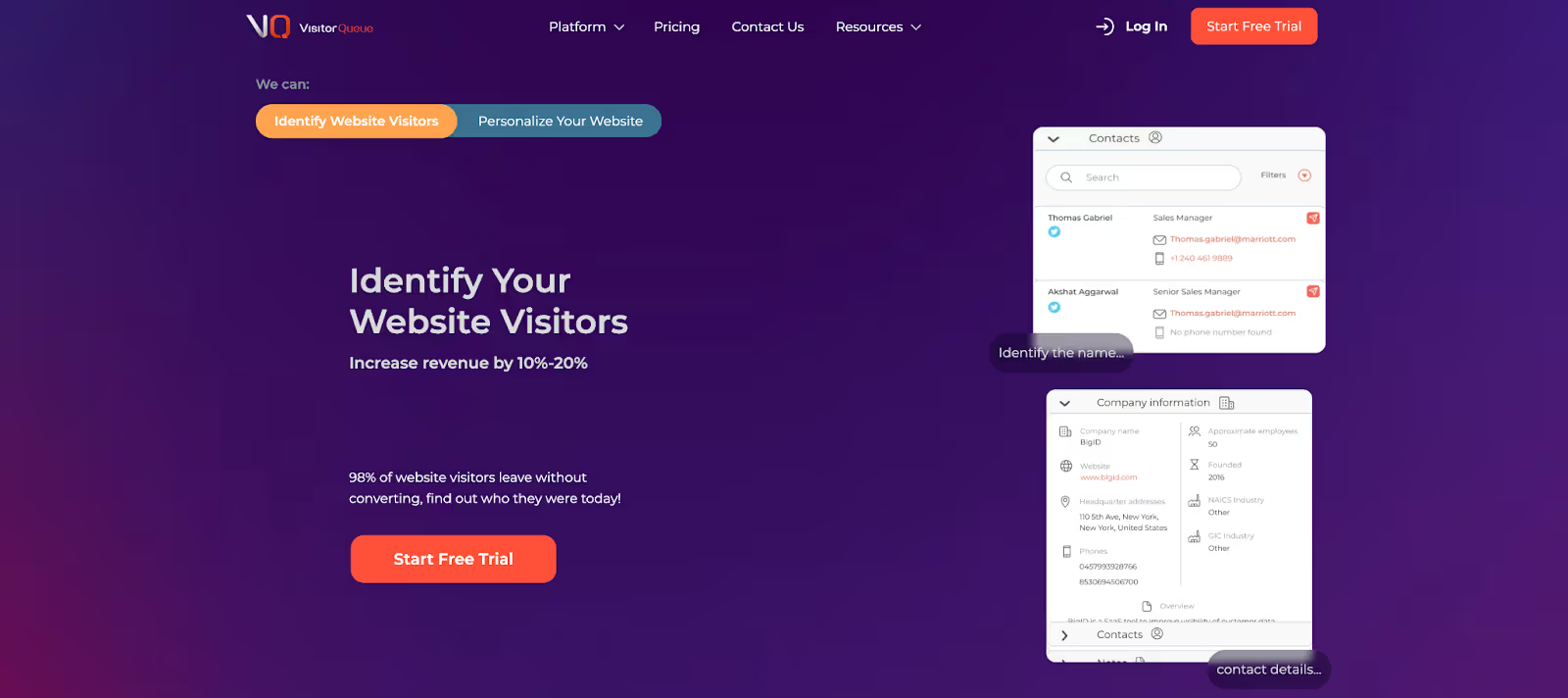
Visitor Queue concentrates on showing which companies are landing on a website.
It is built to give fast visibility without complicating the setup. Teams can quickly see firmographic information, pages viewed, engagement time, and available contacts.
Its main strengths include:
- Tracks companies using IP-based identification
- Shows pages visited and on-site behavior in real time
- Surfaces key contacts from each visiting company
- Sends alerts when new companies appear
- Keeps configuration simple with a tracking snippet
- Works well for smaller teams looking for quick insights
This makes Visitor Queue suitable for teams that want immediate clarity on website visitors without requiring a larger GTM framework.
Factors.ai vs Visitor Queue: Verdict on Functionality and Core Capabilities
Both platforms help teams understand who is engaging with their website.
Factors.ai expands this into a full GTM system with cross-channel visibility, scoring, alerts, and automation.
Visitor Queue stays lightweight, giving teams an easy way to see who is landing on their site and personalize accordingly.
Both approaches are valid.
Teams simply choose based on whether they need basic visitor clarity or full-funnel GTM insight and activation.
Curious how account journeys look in practice? Read our Account Scoring Guide to see scoring and timeline examples that drive prioritization.
Factors vs Visitor Queue: Pricing & Plans
Factors.ai Pricing

Factors.ai structures its pricing around usage and team size, which helps companies adopt it at their own pace.
The platform offers four clearly defined tiers that scale in capability:
- Free for early teams that want to validate their GTM visibility
- Basic for teams that need intent signals, dashboards, and simple workflows
- Growth with deeper analytics, scoring, G2 intent, advanced integrations, and a dedicated CSM
- Enterprise with predictive scoring, AdPilot tools, Milestones, white-glove onboarding, and higher limits
Pricing varies based on the number of accounts identified each month and the number of seats required.
Teams also have the option to add GTM engineering support if they need operational help running automations, building segments, or optimizing journeys.
This structure gives companies room to start small and expand gradually as their GTM operations mature.
Visitor Queue Pricing
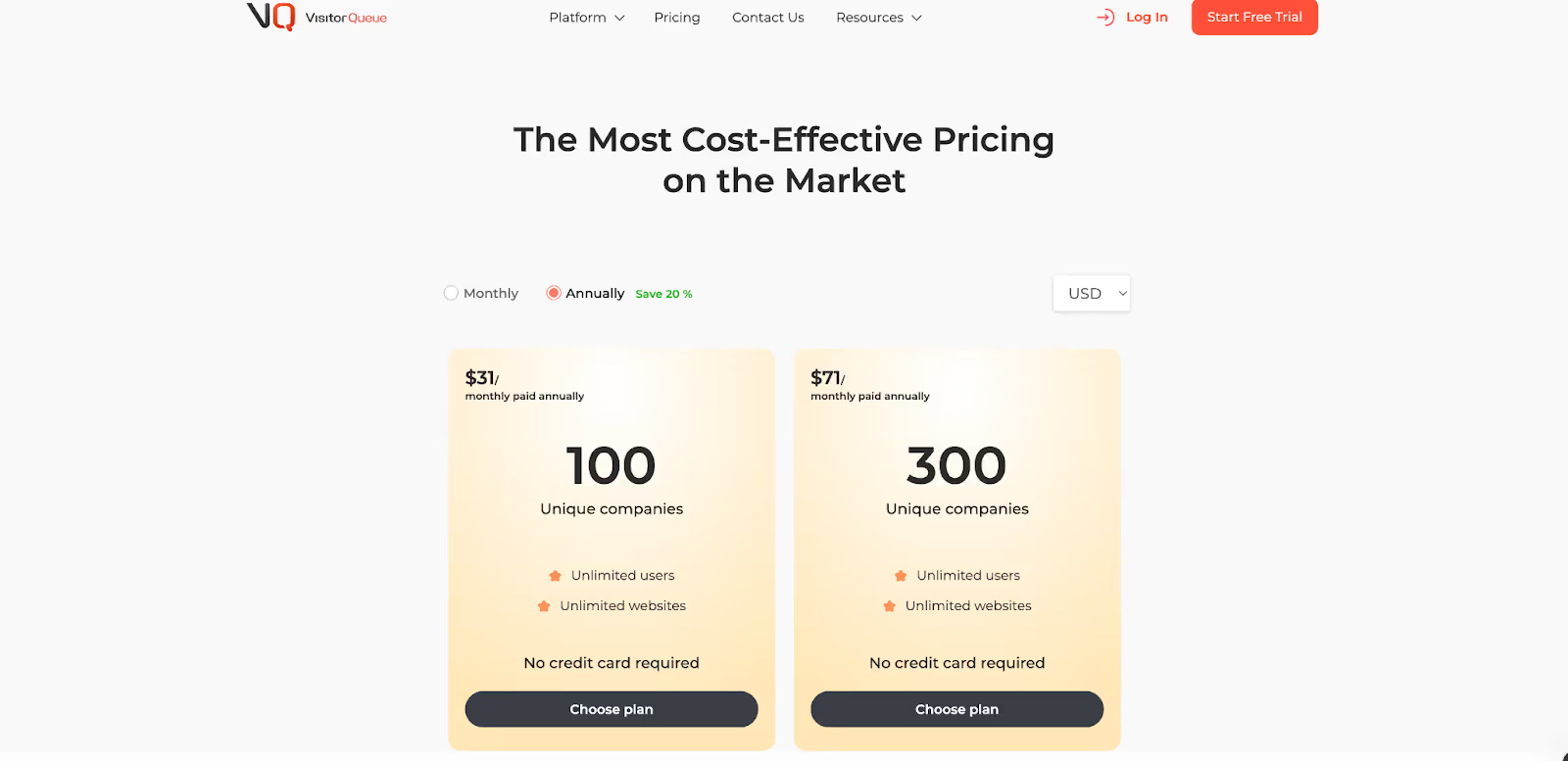
Visitor Queue keeps its pricing simple.
Plans increase based on how many leads a team expects to receive each month, ranging from $31 to $1000/month.
The structure is easy to understand and works well for smaller teams that want predictable monthly costs tied to visitor volume.
Key points about their model:
- All tiers include unlimited users
- Pricing is tied directly to the number of identified leads
- Higher tiers include more leads and contact data
- No complex onboarding or multi-tier support layers
It’s built for teams that want clear, predictable pricing without additional components like automations or advanced analytics.
Factors vs Visitor Queue: Verdict on Pricing
Both platforms keep their models transparent, but they are designed for different needs.
Visitor Queue is suitable for teams that only require visitor identification and want a predictable monthly price tied to lead volume.
Factors.ai fits teams that want pricing tied to business growth, features, and deeper GTM operations, with the option to expand into advanced analytics, scoring, and activation as needed.
Both pricing models make sense for the audiences they serve.
Want to compare pricing approaches across vendors? Our ABM Platform Pricing Guide breaks down common models and what you actually get at each tier.
Factors vs Visitor Queue: Account Identification and Customer Journey Visibility
Factors.ai Account Identification and Customer Journey Visibility
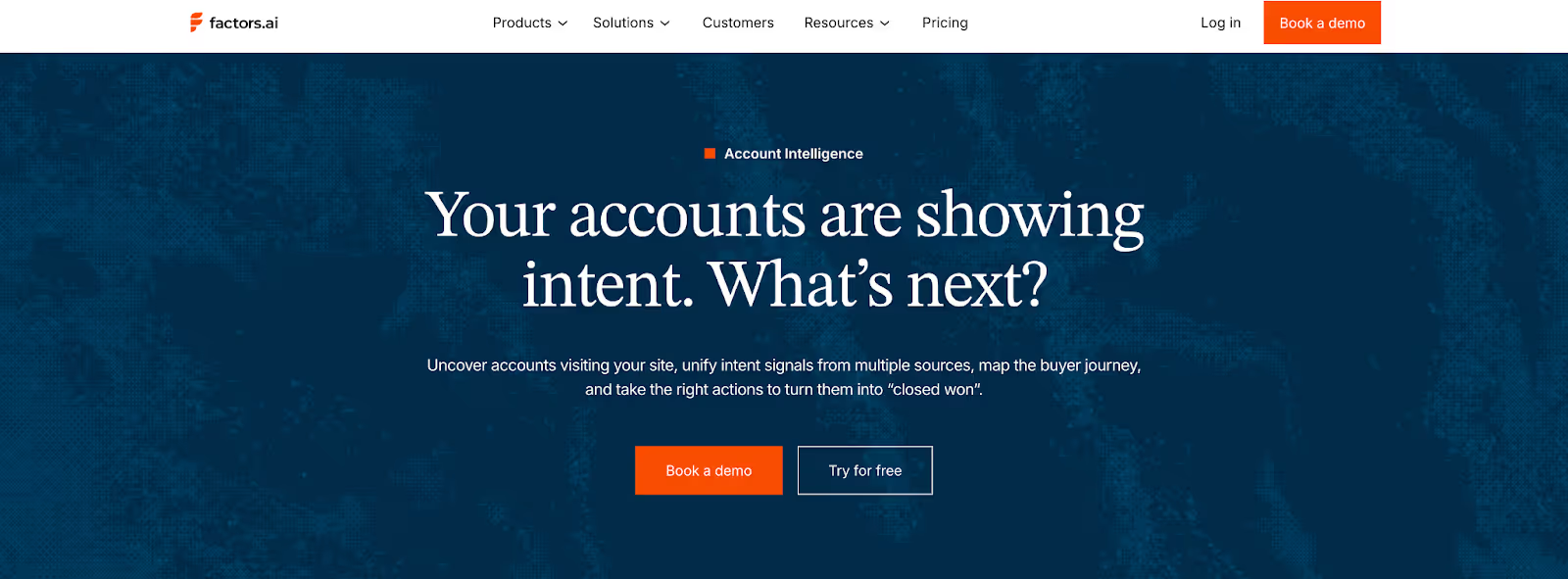
For identification and journeys, Factors.ai is built for GTM teams that need more than just “who visited.” With over 75% account identification coverage from website traffic, it enables teams to reliably map engagement across channels and understand how accounts progress over time.
It focuses on:
- Website-based account identification with multi-signal enrichment
- Website visits
- CRM records
- Ad platform activity
- Product usage
- Account 360 view
- All key interactions stacked into a single timeline for each account
- Includes marketing, sales, and product touchpoints
- Customer Journey Timelines
- Shows the order of events: ad view → website visit → form fill → demo → renewal or expansion
- Shows the order of events: ad view → website visit → form fill → demo → renewal or expansion
- Contextual depth
- Helps sales and marketing see not just who visited, but what they did before and after
- Helps sales and marketing see not just who visited, but what they did before and after
- Built-in prioritization
- Identification feeds directly into scoring and funnel stage, so teams know which accounts are further along
This makes Factors.ai suitable when you want to see how accounts move across channels, not just on your website.
Visitor Queue Account Identification and Customer Journey Visibility

Visitor Queue keeps things focused on website traffic.
It focuses on:
- Real-time company identification
- Uses IP-based tracking to match companies
- Adds firmographic data like size, industry, and location
- On-site journey view
- Pages visited
- Time spent on each page
- Referral source
- Contact enrichment
- Surfaces key contacts and social profiles where available
- Surfaces key contacts and social profiles where available
- Simple journey context
- Lets teams see what a visiting company did during a visit, in one place
- Lets teams see what a visiting company did during a visit, in one place
- Easy starting point
- Good for teams that mainly want to know “who was on the site today?” and “what did they look at?”
It is a practical fit for smaller teams or those who only care about website session insight rather than cross-channel journeys.
Factors.ai vs Visitor Queue: Verdict on Account Identification and Customer Journey Visibility
Both tools help you move beyond anonymous traffic.
- Visitor Queue gives a clear, simple view of which companies visited your site and what they did during that visit. It does that one job well, with minimal setup.
- Factors.ai goes deeper, connecting website visits with campaigns, CRM activity, and product usage, then arranging all of it into account-level journeys that can feed scoring and GTM workflows.
It is not about better or worse here, but about scope:
- Choose Visitor Queue if you mainly want website visitor identification and quick lead lists.
- Choose Factors.ai if you want account journeys that stretch across web, ads, CRM, and product, and plan to use that view to drive GTM decisions.
Factors.ai vs Visitor Queue: Account Scoring and Prioritization
Factors.ai Account Scoring and Prioritization

Factors.ai uses predictive account scoring and contact scoring to help teams focus on the right companies at the right time.
Scoring sits directly on top of identification and journey data, so it reflects real movement across the funnel.
Scoring is driven by:
- ICP matching (firmographic fit)
- Website and product behaviors
- Ad views and clicks
- CRM interactions
- Funnel progression
- Third-party intent (e.g., G2, Bombora)
This system maps into:
- Alerts when a score crosses a threshold
- Prioritized account lists for SDRs and sellers
- Workflow triggers to nurture or follow upfollow-up at key moments
Teams using Factors.ai don’t have to build scoring rules from scratch. They get a prioritized pipeline view automatically that aligns with their GTM motion.
Visitor Queue Account Scoring and Prioritization
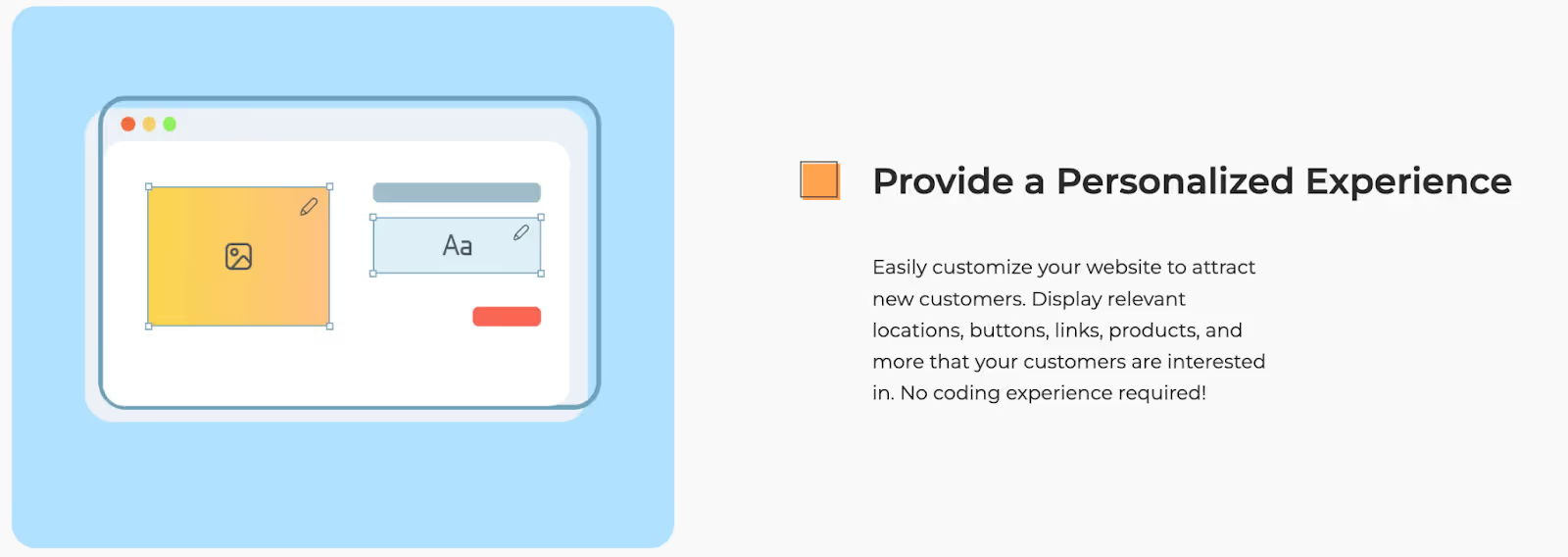
Visitor Queue does not include a built-in scoring layer.
It surfaces:
- Companies that visited your website
- Firmographic data
- Key contacts and available identifiers
- On-site behavior like pages visited and time spent
Teams can export this data or connect it to tools like Salesforce or HubSpot to assign lead scores manually.
For small teams, this can be enough. For growing operations, it usually requires an added layer of scoring logic somewhere else.
Factors.ai vs Visitor Queue: Verdict on Scoring and Prioritization
Factors.ai puts prioritization at the heart of its GTM workflow.
It collects multi-touch signals, uses them to calculate scores, then drives action across marketing automation and sales outreach.
Visitor Queue keeps things simple and leaves scoring decisions to the user.
It offers useful intelligence but no baked-in way to turn it into a prioritized pipeline without extra work.
Your choice depends on how quickly and efficiently your GTM team needs to move from "insight" to "action."
Factors.ai vs Visitor Queue: Alerts, Signals and Sales Enablement
Factors.ai Alerts, Signals and Sales Enablement
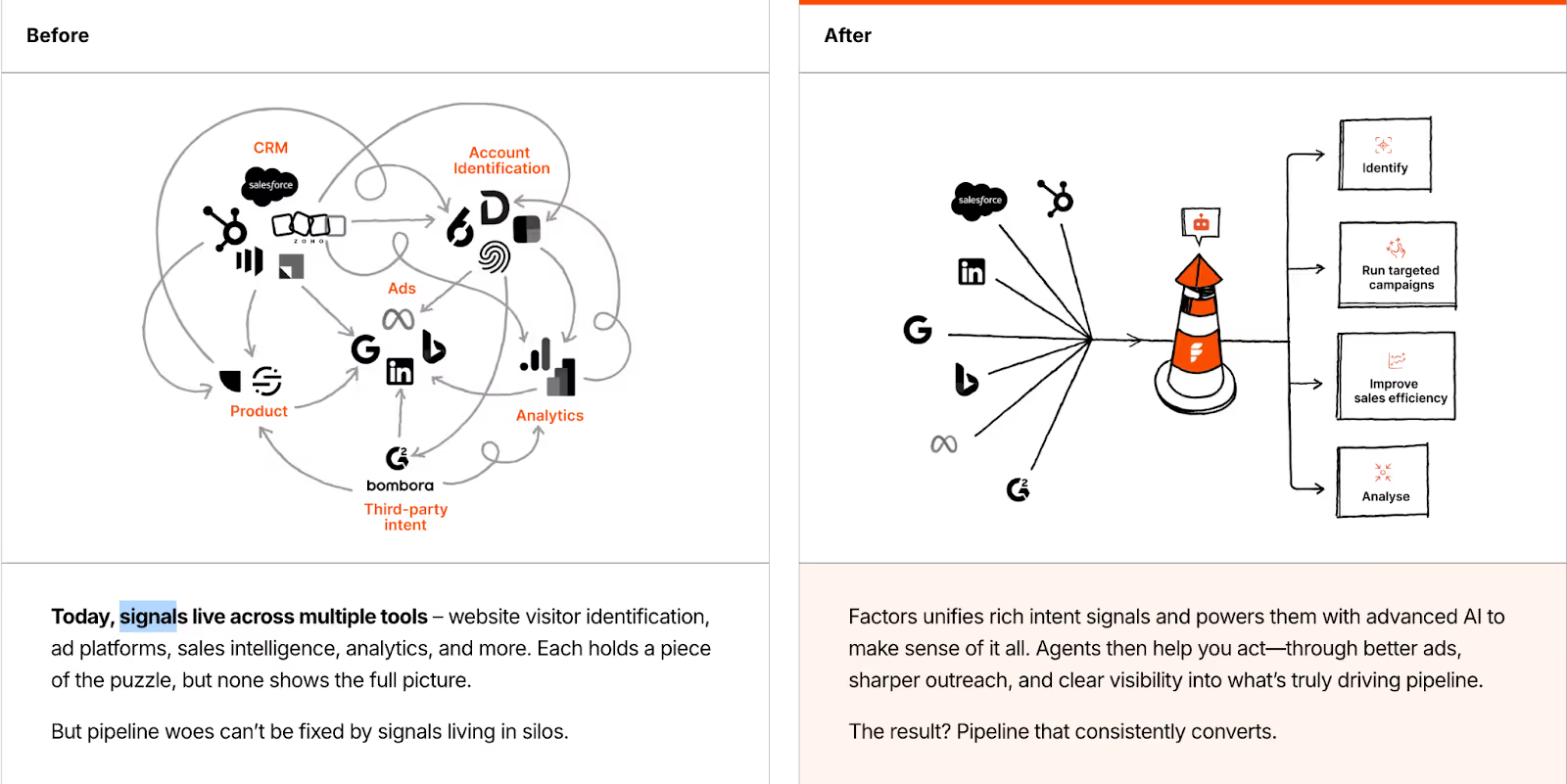
Factors.ai sends context-rich signals that help sales and marketing take the right next step, instead of sending just alerts.
Teams use alert styles like:
- Post-demo browsing: an account continues researching after the meeting
- Closed-lost activity: buyers revisiting after a paused deal
- Form-drop-offs: users who started but did not complete a conversion
- High-intent movement: sudden score increases or stage progression
Each alert contains:
- What happened
- Why it matters
- Account and contact details
- A path to take next
Delivered via Slack or Teams, these signals prompt action across teams with clarity and timing in mind.
Visitor Queue Alerts, Signals and Sales Enablement
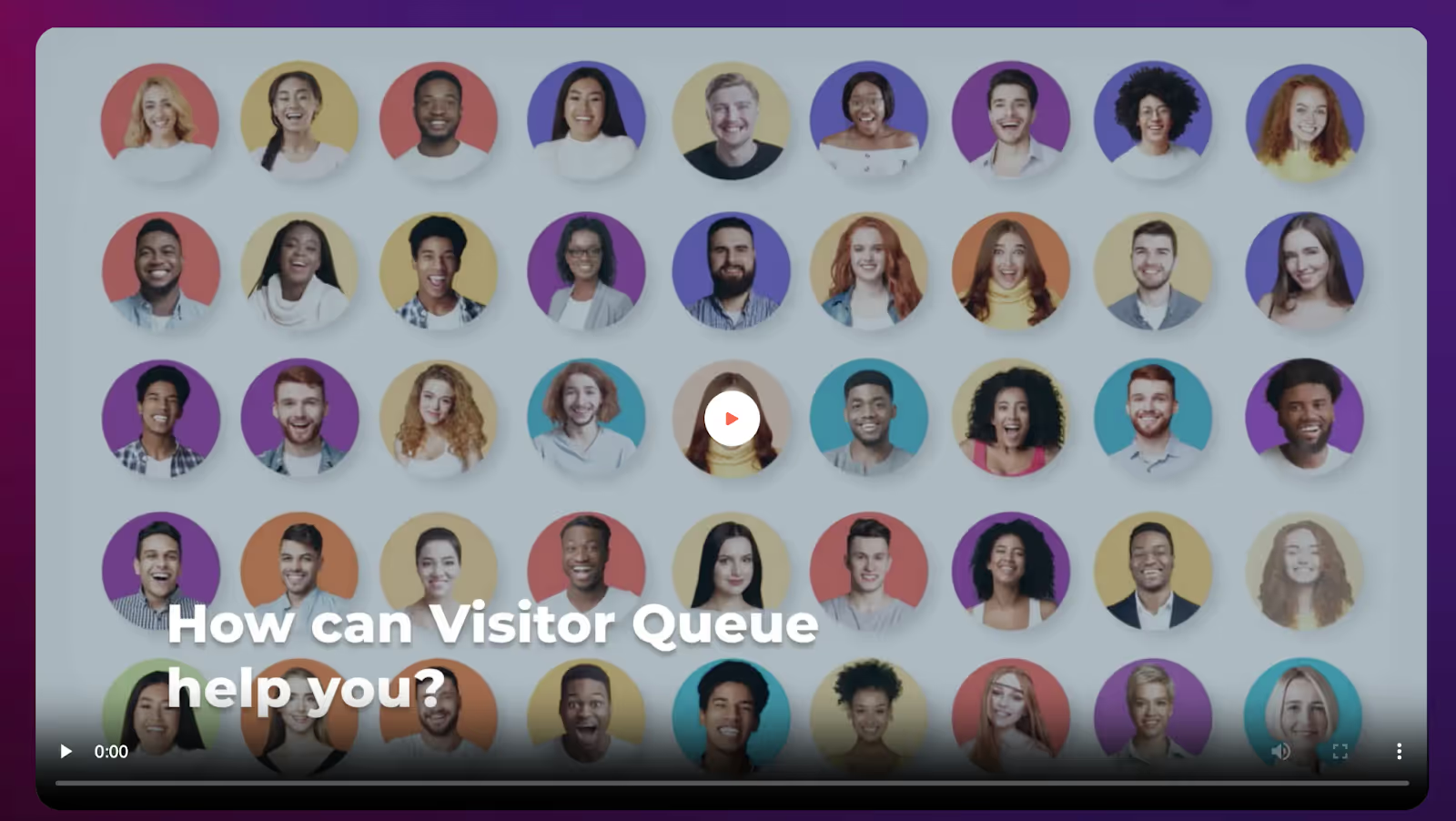
Visitor Queue alerts are straightforward and helpful for smaller sales or marketing teams.
- Alerts trigger when a new company visits the site and matches the criteria
- Teams receive company profiles and contact details (where available)
- Delivered directly into Slack for quick awareness
This approach works well when teams want to instantly know which companies were on the site that day.
While there's no context beyond the visit itself, it offers a fast way to mobilize manual outreach.
Factors.ai vs Visitor Queue: Verdict on Alerts & Enablement
Both platforms help teams spot buying interest.
Visitor Queue alerts show who came to the site, what pages they viewed, and how to reach them. They function as early signals for manual outreach.
Factors.ai builds alerts into the broader GTM motion, using scores and intent milestones to detect meaningful buyer activity across channels, not just the website.
Choosing between them depends on your motion:
- If you just need to catch visitors and act fast, Visitor Queue alerts get the job done.
- If you need a reasoned signal that says what's happening, why it matters, and what you should do next, Factors.ai brings more depth to the table.
Factors.ai vs Visitor Queue: AI Agents and Automation
Factors.ai AI Agents and Automation

Factors.ai adds AI automation to traditional revenue intelligence.
It offers AI Agents and GTM engineering services that help your team:
- Enrich account and contact data instantly
- Discover active buyers within an account
- Surface post-meeting activity that signals next-step readiness
- Revive closed-lost opportunities when intent resurfaces
- Stay ahead of activity without checking multiple systems
GTM Engineering ensures that workflows, scoring, alerts, and playbooks are all implemented correctly and optimized over time, without additional internal setup.
Visitor Queue AI Agents and Automation
Visitor Queue does not include automation.
It surfaces:
- New companies visiting the site
- Firmographic and contact info
- Browsing behavior
From there, teams must:
- Transfer insights into their CRM
- Determine who is worth follow-up
- Research decision-makers
- Build workflows manually if they want repeatable motion
It suits teams with a simple motion or those already relying on manual or separate tools to automate processes.
Factors.ai vs Visitor Queue: Verdict on AI Agents and Automation
This chapter highlights the clearest difference between the two tools.
Visitor Queue offers fast visibility, leaving decisions and execution to the user. It's lightweight and works best in simpler setups.
Factors.ai combines intelligence with action. AI Agents automatically surface insights, run follow-ups, and remove operational friction which is all supported by a team that helps with implementation.
If your revenue operation needs to scale without adding headcount, Factors.ai delivers that leverage.
If your motion is more basic and you’re fine with manual next steps, Visitor Queue meets that need well.
Factors.ai vs Visitor Queue: Integrations and GTM Fit
Factors.ai Integrations and GTM Fit
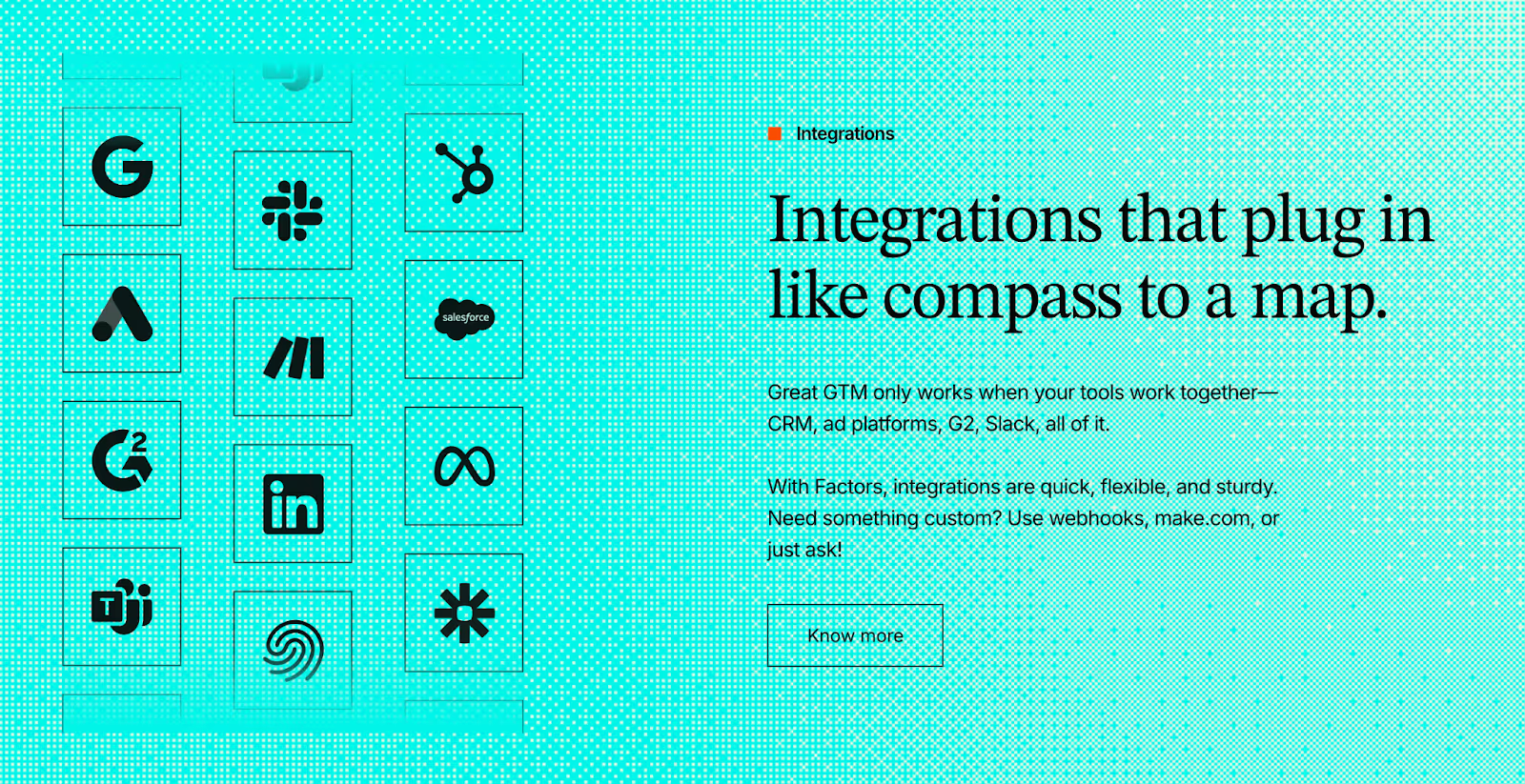
Factors.ai supports deep, bidirectional integrations that connect your CRM, MAP, ad platforms, and engagement tools.
This system-level integration ensures your GTM team always sees the latest activity in the context of their role.
Notable integration points include:
- CRM sync that pulls and pushes account, opportunity, and campaign data
- Ad platform connectivity for audience activation, suppression, and attribution
- CDP and reverse ETL support for unified data pipelines
- Workflow integration via webhooks, Zapier, Make, and Slack
- G2, Marketo, HubSpot, Drift, and Snowflake support in higher tiers
This setup helps your GTM stack act like it’s connected by default, without heavy internal plumbing.
Visitor Queue Integrations and GTM Fit
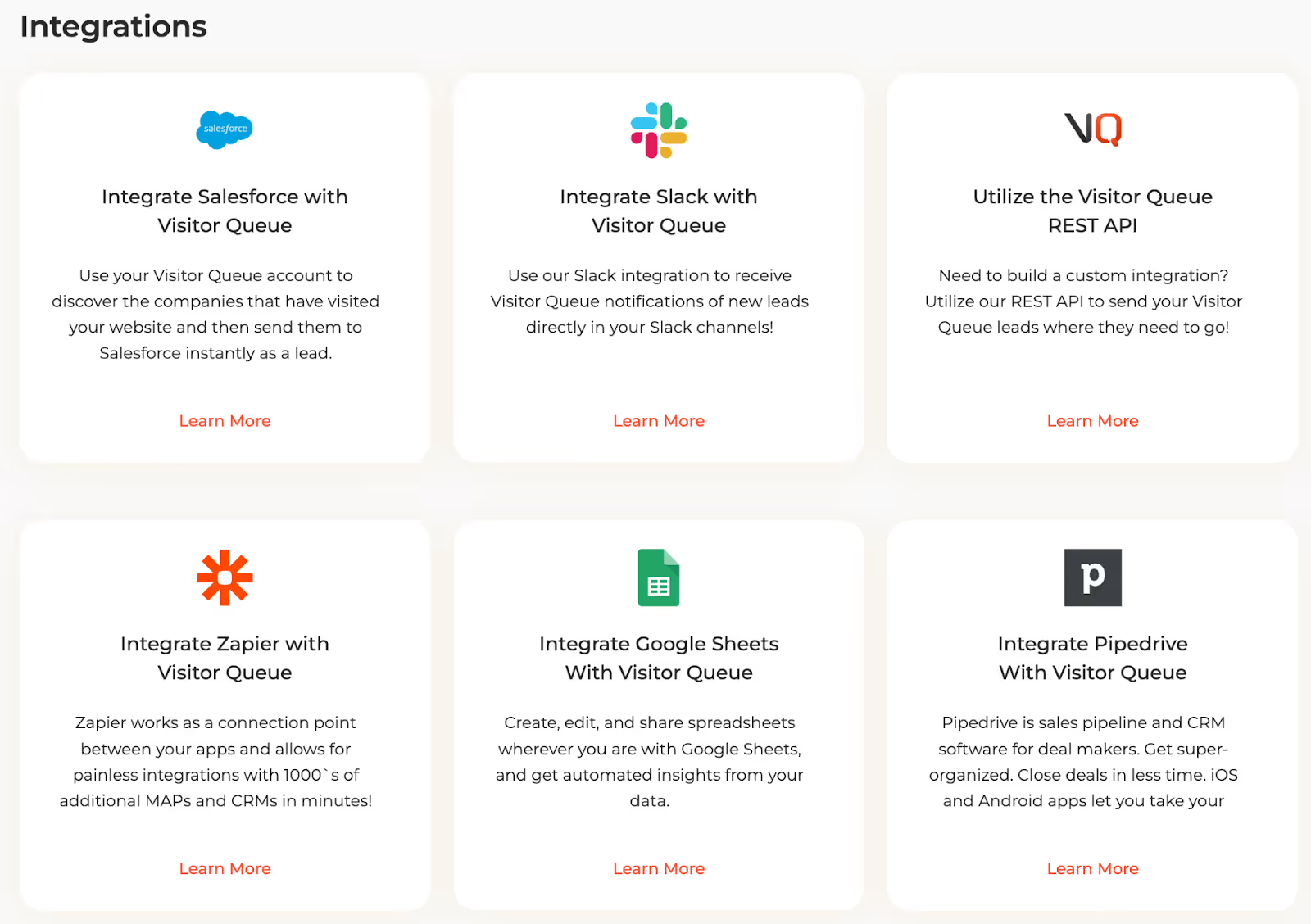
Visitor Queue keeps things focused on essential connections.
It offers:
- Out-of-the-box data sync with Salesforce and HubSpot
- A Zapier integration that supports pushing data into hundreds of tools
- API access for custom workflows
- Slack notifications for alerts on new leads
It supports enough integration depth for teams that only need visitor detail and lead enrichment inside their CRM or outbound motion.
That makes it effective for smaller GTM teams that don’t run connected multi-channel motions yet.
Factors.ai vs Visitor Queue: Verdict on Integrations and GTM Fit
Visitor Queue integrates where it counts, CRM, Slack, Zapier, and avoids scope creep.
It’s practical and quick to connect when all you need is identification data in your CRM.
Factors.ai connects deeply across all major GTM tools and pushes updates both ways.
That makes it better suited for teams that want unified account visibility, automated activation in ad platforms, and scoring frameworks that depend on real-time data sync.
If your revenue workflows span multiple tools and channels, Factors.ai builds the connective tissue for you.
If your GTM team only needs insights from website visitors in CRM, Visitor Queue keeps it simple and efficient.
Factors.ai vs Visitor Queue: Onboarding and Support
Factors.ai Onboarding and Support

Factors.ai puts a service layer behind the software.
Every customer gets onboarding support from a dedicated CSM team, which includes:
- Account configuration
- Data pipeline setup
- Scoring rules and workflows aligned with their GTM motion
- Weekly checkpoints to measure ROI and optimize processes
- Slack support for direct troubleshooting and campaign guidance
For teams that want someone to own the operational lift, GTM Engineering Services can also handle advanced workflows, data flows, automation setup, and intent-based campaign routing.
This level of support is designed for teams seeking a mix of platform ownership and strategic alignment.
Visitor Queue Onboarding and Support
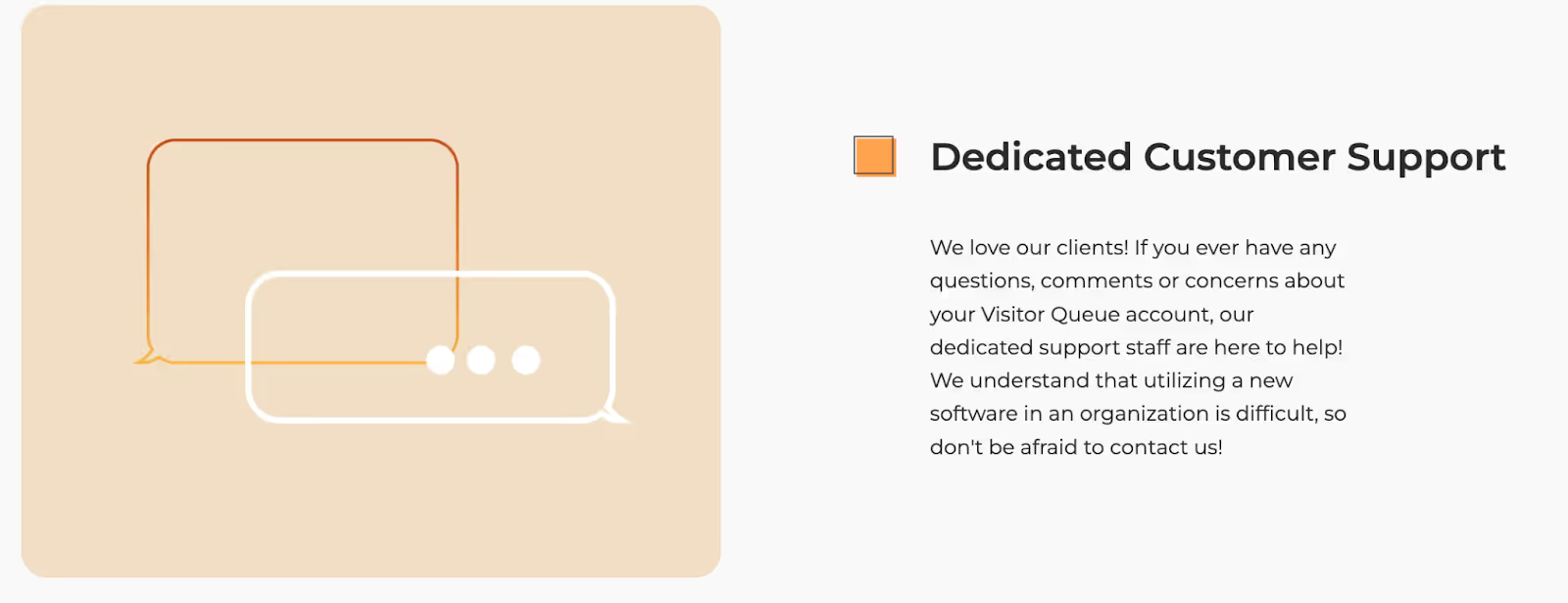
Visitor Queue is built with simplicity in mind, and the support model reflects that.
After signing up, teams:
- Install a tracking script on their website
- Connect their CRM (if needed)
- Start seeing identified companies immediately
Support is available via email, help documentation, and dedicated customer support.
Teams manage their own setup and workflows, which works well when the goal is visibility, not multi-channel GTM orchestration.
Visitor Queue also scales to unlimited users across all plans, making it easy to share with sales and marketing without extra cost or complexity.
Factors.ai vs Visitor Queue: Verdict on Onboarding and Support
Factors.ai delivers a high-touch experience for GTM teams that expect strategic and technical guidance alongside the platform.
That includes full CRM and scoring setup, ongoing sync checks, and direct access to the support team.
Visitor Queue is lightweight: install, integrate, and go.
It asks less upfront and keeps the path light, but also offer additional support beyond setup assistance.
If you want quick visibility without heavy lifting, Visitor Queue fits well.
If your GTM strategy needs more than a tool and you benefit from expert support to run it, Factors.ai carries that weight for you.
Factors.ai vs Visitor Queue: Security and Compliance
Factors.ai Security and Compliance

Security in Factors.ai draws from globally recognized compliance frameworks.
Platform practices include:
- SOC II Type 2 and ISO 27001 certification
- Secure data hosting through Google Cloud Platform
- AES-256 encryption at rest and enforced encryption in transit
- Role-based access control, multi-factor authentication, and internal logging
- Strict access provisioning for production environments
- Regular audits and incident management processes
- Long-term secure retention and backup policies
For enterprise GTM teams, this means procurement and infosec checks can be passed confidently and quickly.
Visitor Queue Security and Compliance

Visitor Queue is designed to process firmographic and session data. It follows:
- GDPR and CCPA compliance guidelines
- Standard cloud-based infrastructure protections
- Encrypted transfer and secure storage of visitor activity
- No processing of personal PII beyond available contact enrichment
It works well for teams with limited compliance exposure or those building early-stage GTM programs where regulatory requirements aren’t as stringent.
Factors.ai vs Visitor Queue: Verdict on Security and Compliance
Both platforms take security seriously, but the depth differs.
Visitor Queue maintains core compliance practices suited to small and mid-sized teams that mostly enrich visitor data and want peace of mind.
Factors.ai extends this into enterprise-grade territory. Certifications, strict access policies, log management, and full lifecycle data protection make it suitable for larger GTM teams with serious audit requirements.
If your organization demands SOC II/ISO validation and thorough data protections, Factors.ai covers that standard.
For simpler compliance needs, Visitor Queue offers enough to stay aligned without adding complexity.
If compliance matters to procurement, learn more about best practices for visitor data and privacy in Website Visitor Identification Privacy.
Factors.ai vs Visitor Queue: What to choose when?
Factors.ai vs Visitor Queue: Final Verdict
Both platforms help marketing and sales teams understand who’s showing interest, but they serve different motions and maturity levels.
Visitor Queue helps you uncover the companies already on your website.
It delivers fast visibility and basic personalization with minimal friction.
If your focus right now is identifying visitors and passing that information along to sales, it’s a clean and accessible match.
Factors.ai builds on that foundation and extends into full-funnel GTM orchestration.
It identifies accounts, scores them based on real behavior and ICP match, surfaces buying signals, activates campaigns, and provides guided insights, supported by AI and real human assistance.
Teams that want clarity and action, built into one system, will find Factors.ai offers more room to scale as the GTM motion matures.
FAQs for Factors.ai vs Visitor Queue
Q. What is the main difference between Visitor Queue and Factors.ai?
The biggest difference is scope.
Visitor Queue focuses on identifying companies that visit your website and showing basic on-site behaviour.
Factors.ai goes beyond identification and connects website activity with ads, CRM data, product usage, scoring, alerts, and automation across the full GTM funnel.
If you only want to know who visited, Visitor Queue does that well. If you want to know what that visit means and what to do next, Factors.ai is built for that.
Q. Is Factors.ai a good alternative to Visitor Queue?
Yes, Factors.ai is a strong alternative to Visitor Queue, especially for teams whose GTM motion goes beyond basic website visitor visibility.
If you’ve outgrown simply knowing which companies visited your site and want to understand how that interest connects to ads, CRM activity, product usage, and pipeline movement, Factors.ai offers that broader context. It brings scoring, prioritisation, alerts, and workflows into one system, reducing the need to manually stitch insights together across tools.
Visitor Queue works well for teams that only need quick visitor identification. Factors.ai is better suited for teams that want to turn those visits into coordinated GTM action across channels.
Q. Is Visitor Queue a good alternative to Factors.ai?
Visitor Queue can be a good alternative for teams with simpler GTM needs.
If your main goal is visibility into website visitors and you’re comfortable handling prioritisation and follow-ups manually, Visitor Queue is often sufficient.
Factors.ai is better suited when your GTM motion spans multiple channels and you want signals, scoring, and workflows handled inside one system rather than stitched together manually.
Q. Which tool is better for small or early-stage teams?
For early-stage teams that want fast setup and quick answers, Visitor Queue is often the easier starting point. It requires minimal configuration and delivers immediate visibility into website visitors.
Factors.ai also offers a free tier, but it’s typically more valuable once a team starts running ads, managing a CRM actively, or coordinating between marketing and sales.
Q. Does Visitor Queue offer account scoring or prioritisation?
No. Visitor Queue does not include built-in account or contact scoring.
Teams usually review visitor data manually or export it into a CRM or another tool to apply scoring logic.
Factors.ai includes native scoring based on ICP fit, intent signals, funnel stage, and multi-channel activity, helping teams prioritise accounts automatically.
Q. Can Factors.ai replace multiple GTM tools?
For many teams, yes.
Factors.ai can reduce reliance on separate tools for visitor identification, intent tracking, scoring, alerting, and basic GTM workflows by consolidating those functions into one platform.
That said, it’s designed to connect with your existing CRM, ad platforms, and CDP rather than replace them entirely.
Q. How do alerts differ between Visitor Queue and Factors.ai?
Visitor Queue alerts notify teams when a new company visits the website and share basic visit details.
Factors.ai alerts are contextual. They explain why an alert triggered, such as post-demo activity, score changes, closed-lost reactivation, or funnel movement, and often suggest the next best action.
Q. Does Visitor Queue support automation or AI agents?
No. Visitor Queue does not include automation or AI-driven workflows.
All enrichment, prioritisation, and follow-up actions are handled manually or through external tools.
Factors.ai includes AI Agents and GTM Engineering support to automate research, buyer mapping, alerts, follow-ups, and deal revival workflows.
Q. Which platform is better for sales teams?
It depends on how sales works in your organisation.
If sales wants daily visibility into who visited the site, Visitor Queue does the job.
If sales wants clear signals on who to call, when, and why, Factors.ai provides more guidance through scoring, alerts, and journey context.
Q. How do the pricing models compare?
Visitor Queue uses a volume-based pricing model, where costs increase based on the number of identified leads. It’s predictable and easy to understand.
Factors.ai pricing scales based on usage, features, and team size, with options to grow into advanced analytics, automation, and support as GTM complexity increases.
Q. Which tool is more suitable for enterprise teams?
Factors.ai is generally more suitable for enterprise GTM teams due to its:
- SOC II and ISO certifications
- Multi-channel data integration
- Scoring and automation capabilities
- Dedicated onboarding and support layers
Visitor Queue is better suited for SMBs or teams with lighter compliance and operational requirements.
Q. Can I use Visitor Queue and Factors.ai together?
Technically, yes. But for most teams, it’s unnecessary overlap.
Factors.ai already includes visitor identification as part of a broader GTM system, so teams usually choose one or the other based on how much orchestration they need.
Q. How do I decide which platform is right for my team?
Ask yourself three questions:
- Do we only need to know who visited, or do we need to know what to do next?
- Are we running multi-channel campaigns that need shared context?
- Do we want manual control or automated GTM workflows?
Your answers will usually make the choice clear.
.avif)
Benefits of Paid Search for B2B SaaS (Why Teams Keep Coming Back to It Anyway)
As B2B marketers, we have all gone through this moment.
Organic traffic is steady.
The content calendar is full.
And then the founder asks, “This is all great, but what’s going to move the pipeline this quarter?”
That question usually leads to the same discussion: “What can we turn on quickly?”
And that’s when paid search enters the conversation.
It starts as a short-term fix. Pipeline feels tight. Leadership wants quicker results. Someone suggests increasing spending on Google Ads. Costs rise, and before you realize, paid search steps up to take the blame.
Paid search is often misunderstood, occasionally abused, and regularly criticized.
Yet paid search keeps getting budget for one simple reason: it delivers predictability when teams need results fast.
This piece breaks down the real benefits of paid search advertising for B2B SaaS. No hype, just what it’s actually good at.
TL;DR
- Paid search works best as a demand capture channel, showing up when buyers are already evaluating tools, not when you’re trying to create awareness from scratch.
- It gives fast, honest feedback on messaging and positioning, helping teams learn what actually resonates in days, not months.
- Its biggest advantage is predictability. Paid search is one of the few channels through which B2B teams can reliably plan for the pipeline.
- The real upside isn’t lead volume, but clarity: better targeting, stronger sales context, and tighter alignment between marketing and sales.
First, a quick reality check on paid search advertising
Paid search is not magic. Scroll through any PPC or SaaS subreddit, and you’ll see the same frustrations pop up:
- “We’re paying for demo clicks that never convert.”
- “Sales says the leads are junk.”
- “Google Ads feels like a tax, not a growth channel.”
And they’re not wrong when paid search is treated like a lead faucet. But when it’s treated like a demand capture and signal channel, the benefits compound fast.
Let’s get into the benefits of paid search.
1. Paid search captures demand at the exact moment it exists
This is the most obvious benefit of paid search marketing. It’s also the one people still underestimate.
Paid search doesn’t show up to educate or warm people up. It shows up after someone has already decided to look for a solution.
They’re not browsing. They’re searching for queries like:
No one types these queries “just to explore.” These are decision-stage searches.
The buyer is comparing options, building a shortlist, or getting ready to talk to vendors. In practice, these keywords tend to have:
- Lower volume but higher conversion rates
- Longer time-on-page
- Higher demo-to-opportunity rates compared to generic terms
And that’s where paid search works best.
You’re not trying to convince someone they have a problem. That part is already done. You’re helping them decide which tool to pick.
And in that moment, timing matters more than clever copy.
That’s when paid search shows up exactly when the buyer is ready to choose.
Related read: Google Ads strategy for B2B SaaS
2. Paid search gives you immediate feedback on what the market actually cares about
Content takes time.
SEO takes patience.
Brand takes consistency.
But paid search? Paid search gives you feedback this week, often within the first few hundred clicks.
Run a few focused campaigns, and the market stops being polite. Within days, you learn:
- Which pain points actually get clicks
- Which value props sound great internally but fall flat externally
- Which keywords attract buyers versus people just doing “research”
Instead of debating positioning in meetings, paid search forces a real-world test. It’s honest, slightly brutal, and very efficient. If the message is unclear, performance drops immediately. If it resonates, you’ll know fast.
That’s why many marketers view paid search as a market research tool. Not the cheapest option, but faster than waiting three months for content data to roll in.
These insights from ads don’t just stay in ads. Teams regularly reuse these signals across:
- Homepage and landing page headlines
- Sales decks and demo flows
- Outbound email copy
- Product positioning
The real benefit here isn’t traffic. It’s knowing what language your market actually responds to.
3. Paid search is predictable, which is rare in B2B marketing
SEO compounds slowly.
Social performance fluctuates.
Events depend on calendars, attendance, and whether people actually show up.
Paid search is different. It’s refreshingly boring.
Put in X dollars.
Get Y clicks.
Convert Z percent.
Is it perfect? No.
Is it controllable? Yes.
That predictability matters, especially when B2B SaaS teams are under revenue pressure. Paid search lets you:
- Forecast pipeline contribution with more confidence
- Model CAC scenarios before committing the budget
- Turn spend up or down intentionally, not emotionally
You may not always love the efficiency, but you can plan around it.
And when leadership wants clear visibility into spend versus output, paid search delivers something most channels can’t: a lever you can actually pull. In B2B, that kind of predictability is a big plus.
4. Paid search supports your digital marketing strategy and other channels
One of the most underrated benefits of paid search ads is how much they help every other channel work better.
Paid search is not the star of your GTM motion, but it just shows up and does the supporting work.
Here’s what actually happens in B2B buying journeys:
- Someone sees your LinkedIn Ad and Googles you five minutes later
- Someone reads a blog and searches for pricing “just to check.”
- Someone gets a sales email and does a quick sanity search before replying
And your search ads are there for all of it.
It reinforces credibility, reduces friction, and makes your brand feel familiar instead of seeming risky. That’s why paid search often shows up late in the buying journey. It’s not discovering buyers. It’s confirming decisions.
So, paid search is not the hero, not the villain. It is the supporting character that holds the plot together.
5. Paid search forces strategic clarity (whether you like it or not)
If your positioning is fuzzy, CPCs go up.
If your ICP is wrong, conversion rates tank.
If your value prop is vague, no one clicks.
Paid search has a reputation for “punishing bad messaging.” That sounds harsh, but it’s actually one of its best features.
Paid search doesn’t let you hide behind impressions or vanity metrics; it asks one simple question: Did this message make someone act? If the answer is no, you don’t argue about it in a meeting. You fix it. Fast.
That pressure forces teams to get clear on the basics:
- Who is this for?
- What problem are we solving right now?
- Why should someone choose us at this stage?
Because paid search doesn’t reward vague positioning, it often accelerates decisions teams were already avoiding.
In that sense, paid search isn’t just a channel. It’s a constraint that creates clarity.
6. Paid search makes sales calls easier (before the demo even starts)
One underrated benefit of paid search ads is what happens after the conversion.
By the time someone books a demo from paid search, they’ve usually done some homework:
- Compared vendors
- Read positioning pages
- Self-qualified based on use case or price expectations
In other words, sales teams don’t start from zero.
When sales teams can see keyword and campaign context, they walk into calls with a lot more information. Instead of opening with generic discovery, sales can see:
- What keywords triggered interest
- Which use cases resonated
- Whether competitors were being evaluated
That context alone can change the tone of a call. Conversations become more focused, less defensive, and much more productive.
It’s a benefit that rarely shows up in dashboards, but sales teams feel it immediately.
What redditors actually say about paid search (unfiltered)
To separate theory from reality, it helps to look at how marketers talk about paid search when they’re not writing polished blog posts or pitch decks.
Reading Reddit threads about paid search can feel confusing at first.
People complain constantly.
- CPCs are too high.
- Lead quality is inconsistent.
- Google Ads feels expensive and unforgiving.
But if you read closely, something interesting shows up. Most of the frustration isn’t about whether paid search works. It’s about how narrowly it works.
Across B2B-focused communities, the same patterns keep coming up:
- Paid search performs best for bottom-of-funnel and competitor keywords
- Broad, generic keywords burn budget quickly and attract low-quality leads
- Rising CPCs are real, but they’re also stable enough to plan around
- Performance improves sharply when landing pages match intent instead of traffic volume
In other words, Reddit doesn’t disagree with paid search. It disagrees with how teams often try to use it.

Many of the loudest complaints come from teams treating paid search like a volume channel, when it behaves more like a precision tool. That lines up with everything earlier in this article.
Paid search works when:
- Demand already exists
- Messaging is specific
- Intent is respected
- Expectations are realistic
That’s why experienced marketers sound conflicted. They don’t enjoy paid search. They question the costs. They debate efficiency, but they still rely on it.
Because when buyers are actively evaluating options, paid search is one of the few channels that reliably shows up at the right moment. (And even its critics know that’s hard to replace.)
Turn paid search into an ABM growth engine with Factors.ai’s Google AdPilot
If paid search works best when it’s precise, predictable, and intent-led, then treating Google Ads like a volume channel is the fastest way to waste budget.
That’s exactly what Google AdPilot by Factors.ai fixes.
Target. Train. Track. Google Ads re-engineered for ABM.
With Google AdPilot, you stop paying for random clicks and start running Google Ads that are built for high-ACV B2B deals:
- Target the right accounts: Run ads only for ICP-fit, high-intent accounts. No job seekers. No competitors. No junk traffic.
- Train Google’s AI better: Send richer, value-weighted conversion signals back to Google using Google CAPI, so it optimizes for pipeline, not form fills.
- Track real impact: See which keywords and ads actually influence accounts, opportunities, and revenue, not just clicks.
The result? You can scale into broader keywords without tanking efficiency, improve conversion quality, and finally understand how paid search fits into the full buyer journey.
If you’re tired of paying for non-ICP clicks, Google AdPilot helps Google work the way B2B teams actually need it to.
👉 Book a demo or try it free and see how paid search should really work.
So… is paid search worth it for B2B SaaS?
Yes.
But only if you stop asking it to do the wrong job.
Most teams don’t fail with paid search because of execution. They fail because of expectations.
Paid search works best when it’s not treated like a lead-dumping machine. The real benefits show up when you use it as:
- A demand capture layer for buyers who are already searching
- A messaging feedback loop that tells you what actually resonates
- A signal engine that helps sales and marketing stay aligned
Paid search won’t fix a broken funnel. It won’t rescue unclear positioning. And it definitely won’t make CPCs magically cheaper.
But it will make a good funnel move faster.
And when leadership wants answers this quarter, paid search remains one of the few channels that can actually deliver them.
So the real question isn’t whether you should run paid search. It’s how you’re using it. Are you collecting leads…or are you learning what your buyers care about before they ever talk to sales?
That’s where the real upside lives.
Related read: Are Google Ads worth it?
FAQs on the benefits of paid search
Q1. Is paid search worth it for B2B SaaS companies?
Yes, when used for bottom-of-funnel and high-intent keywords. Paid search works best for capturing existing demand, not generating awareness from scratch.
Q2. Why does paid search feel expensive for B2B?
Because B2B keywords are competitive and intent-heavy. Higher CPCs are common, but they’re also predictable and easier to plan around compared to most channels.
Q3. Does paid search generate low-quality leads?
It can, if campaigns target broad or generic keywords. Lead quality improves significantly when keywords, landing pages, and intent are tightly aligned.
Q4. How long does it take to see results from paid search?
Usually, days to a few weeks, not months. Performance signals like CTR, conversion rate, and keyword quality show up quickly once campaigns go live.
Q5. Should B2B companies use paid search or SEO?
Both. SEO builds long-term demand, while paid search captures demand that already exists. They work best together, not as replacements.

Audience Identification: How B2B Marketers Can Stop Marketing to “Everyone”
Let’s start with an uncomfortable truth:
If your audience is “everyone,” your real audience is… no one.
Sure, your ad might get impressions.
Your blog might get traffic.
Your website might look busy.
But busy doesn’t mean effective.
Because when your message tries to speak to everyone, it usually ends up sounding like white noise. Polite. Generic. Instantly forgettable..
In this guide, we’ll break down what audience identification really means, why it matters for B2B marketing, and how to identify your audience step by step, without overcomplicating it.
But first, the basics.
TL;DR
- Audience identification means defining the specific people your marketing is meant to reach, not broad groups such as B2B companies or mid-market SaaS.
- Clear audience identification helps B2B marketers create more relevant messaging, choose the right channels, and reduce wasted spend.
- The best way to identify your target audience is by analyzing existing customers, understanding real pain points, studying behavior, and defining who you are not targeting.
- When you know exactly who you are talking to, your content feels sharper, your ads perform better, and your marketing feels more human and effective.
What is audience identification?
Audience identification is the process of figuring out exactly who your marketing is meant to speak to.
Not who could buy your product and definitely not who might someday care. But the specific people your messaging is designed for.
Imagine your product is for the B2B companies. But your audience might be:
- Demand gen managers drowning in dashboards
- RevOps leaders side-eyeing attribution reports
- Founders doing five jobs and sleeping four hours
Same market, totally different conversations.
Related read: What is ICP?
Target audience vs. target market (PS: They’re not the same)
This mix-up causes more bad marketing than Google algorithm updates. So let’s clear it.
- The target market is the broad group your product is built for
- The target audience is the specific subset your marketing is speaking to
For example, if your target market is B2B SaaS businesses, your target audiences could be:
- Founders
- Performance Marketers
- RevOps managers
Trying to talk to all of them at once is how you end up with copy that says… absolutely nothing.
Most businesses have multiple target audiences. The trick is knowing which one you’re talking to in that moment.
Related read: ICP Vs Buyer persona
Why audience identification actually matters (especially in B2B)
Here’s the truth that most B2B marketers agree on: B2B buyers are busy, skeptical, and allergic to fluff.
If your message doesn’t immediately feel relevant, they’re gone. No second chances, and definitely no “let me think about this.”
But on the other hand, when you nail audience identification, you can:
- Write copy that feels oddly specific (in a good way)
- Choose channels that actually convert
- Stop burning the budget on people who were never going to buy
Build a brand voice that feels intentional, not confused.
A PPC tool for enterprise teams shouldn’t sound like one built for local businesses.
And a message for a CMO should not read like one for a junior marketer.
Audience identification gives your marketing context (because without it, you’re guessing... and guessing is expensive.)
Related read: ICP marketing strategy
Common types of target audiences (aka: how people are usually grouped)
Most brands don’t have just one audience; they have layers. Here are the most common ways audiences are defined:
- Demographics: Age, location, job title, industry. (Basic, but useful.)
- Psychographics: Beliefs, motivations, values. (This is where things get interesting.)
- Purchase intention: Just browsing? Actively comparing? Ready to buy yesterday?
- Interests & subcultures: Communities, professional circles, shared obsessions.
- Lifestyle & behavior: How they work, where they hang out online, how they consume content.
Strong audience identification typically involves several of these, not just a single checkbox.
How to identify your target audience
If your audience feels fuzzy or suspiciously large, then you have to start here.
Step 1: Start with your customers (they already said yes)
Your existing customers are marketing gold. All you need to do is look for patterns:
- Job titles
- Industries
- Company size
- Geography
Pay extra attention to:
- Long-term customers
- Repeat buyers
- People who actually use the product
Then you have to talk to them. Yes, real conversations. (Wild, I know.)
Ask the following questions:
- What problem were you trying to solve?
- What almost stopped you from choosing us?
- What alternatives did you consider?
- Where do you go for advice or learning?
- What content do you actually read?
You’re collecting data and stealing their language (politely).
Step 2: Look at your social followers (the voluntary audience)
Your social followers are people who choose to hear from you. That alone is a clue. Look at:
- Location
- Age range
- Career level
- Engagement patterns
- Other brands they follow
You don’t need fancy tools. Even native LinkedIn or Meta analytics can show trends.
Pro tip: Focus on who engages, not who merely exists.
Step 3: Dig into your content and website analytics
Your website is quietly telling you who cares, but you have to listen.
Use analytics to understand:
- Where visitors come from
- Which pages do they linger on
- What content converts them
- What keywords bring them in
If founders gravitate to one set of pages and marketers to another, then you probably have multiple audiences.
And no, they all should not get the same homepage message.
Step 4: Stalk your competitors (professionally)
Your competitors are doing audience identification, whether they admit it or not. Study the following:
- Who are they clearly speaking to?
- What pain points do they repeat
- Where do they advertise?
- Who engages with their content?
The overlap between you and your competitor indicates a crowded market. The gaps reveal opportunities.
Sometimes differentiation is all about being clearer.
Step 5: Decide who your audience is not (this part stings)
This step is uncomfortable, which is why it works. For example:
- If you don’t offer a free plan, then stop targeting bargain hunters.
- If you only sell in the US, then exclude global traffic.
- If you serve mid-market, then stop messaging early-stage founders.
Saying “no” to the wrong audience makes it much easier to say “yes” to the right one.
Step 6: Creating a target audience profile (make it usable)
Once you’ve gathered the info, consolidate it. Include what actually matters:
- Role & seniority
- Industry
- Goals
- Pain points
- Buying triggers
- Platforms they trust
From there, create personas that are practical, share “this is who we’re talking to” profiles with your teams (so sales and marketing don’t argue about it in meetings)
PS: They don’t need cute names. They need clarity.
Related read: How to build your ICP in 15 steps
What target audience identification looks like in the real world
Let’s say you’re marketing a B2B SaaS product that helps companies understand which marketing efforts actually drive pipeline and revenue. (The kind of question leadership loves to ask five minutes before your review.)
At first, your audience looks like “B2B companies” or maybe “mid-market SaaS.” Which sounds reasonable… until you realize that points to thousands of (very) different teams. Way too broad to be helpful. So you zoom in.
Step 1: Start with your existing customers
You look at who’s already using and loving the product. A pattern jumps out. Your most engaged users tend to be RevOps or marketing ops leaders at SaaS companies with 50 to 500 employees. They’re the ones building dashboards, cleaning up CRM data, and calmly explaining ROI to leadership (or at least trying to).
Step 2: Look at behavior and pain points
Customer calls, and demos start sounding familiar. Everyone’s frustrated with disconnected tools, unclear attribution, and the constant pressure to prove marketing’s impact on revenue. Different companies, same headaches.
Step 3: Check where they spend time
You notice they’re active on LinkedIn, actually read long-form reports, and engage with content about attribution, pipeline visibility, and GTM alignment. Quick hacks don’t cut it. Depth does.
Step 4: Define who you’re not targeting
You intentionally rule out very early-stage startups and non-SaaS businesses. They’re not the wrong audience for the product forever, just not right now.
The result is a clearly identified target audience.
Your messaging shifts from generic feature lists to outcomes they care about: revenue visibility, cleaner reporting, and fewer awkward questions from leadership.
How to reach your audience once you’ve identified them
Once you know who you’re talking to, marketing stops feeling like guesswork and starts feeling… logical.
Here’s how to actually reach your audience without overthinking it.
1. Choose the channels they already trust
You don’t need to “be everywhere.” You just need to be where your audience already shows up.
If your target audience lives on LinkedIn, reads long-form reports, and joins webinars, forcing Instagram into your strategy is unnecessary.
Meet them where they’re comfortable, not where a trend report told you to be.
When you show up in trusted spaces, your message doesn’t feel like an interruption. It feels expected.
2. Use their language, not your product features list
This one’s big.
Your audience does not wake up thinking about your product features. They wake up thinking about their problems. So instead of saying what your tool does, talk about what it fixes.
If they complain about “messy attribution” or “answering ROI questions for the tenth time,” use that exact language. The moment they think, “Oh wow, that’s me,” you’ve won.
3. Match content to intent
Not everyone is ready to buy. And that’s okay.
Early on, they want education and clarity. Later, they want proof, examples, and reassurance that they won’t regret the decision.
Teach first. Prove second. Sell last. Trying to rush this is how good leads quietly disappear.
4. Test, learn, adjust (because humans change)
Audiences evolve, priorities shift, and new pain points appear.
The smartest teams keep listening, testing, and tweaking. Audience identification isn’t a one-time task. It’s an ongoing calibration.
And honestly, that’s what keeps marketing interesting.
Final thought: clarity beats cleverness (every time)
Here’s the thing most of us learn the hard way: when marketing feels hard, it’s usually not because you need better copy. It’s because you’re not sure who you’re talking to.
When the audience is blurry, everything downstream gets messy. Headlines start overexplaining. Campaigns try to please too many people. Results look fine, but never great. And explaining them in reviews becomes a whole separate job.
But when you’re clear on your audience? Suddenly, decisions get easier.
What to say stops being a debate.
What not to do becomes obvious.
Your content starts sounding oddly specific. Your ads feel less like interruptions and more like “oh wow, that’s exactly my problem.” And your marketing stops trying so hard to be clever, because it finally knows what audience is reacting to.
You don’t need more channels. You don’t need smarter words. You need a clearer persona in mind. Because the best marketing doesn’t feel like marketing. It feels like someone actually gets the job you’re trying to do.
And that’s what good audience identification is all about.
FAQs on audience identification
Q1. What is a B2B target audience, and how is it different from a target market?
A target market is the broad group your product is built for, such as SaaS companies or mid-market businesses. A target audience is a smaller, more specific group within that market that your marketing is meant to reach.
For example, your target market might be B2B SaaS companies, but your target audience could be RevOps leaders at SaaS companies with 50–500 employees. The narrower definition helps you create messaging that actually resonates instead of trying to appeal to everyone at once.
Q2. How do B2B marketers decide who their target audience is?
Most B2B marketers start with existing customers. They look for patterns in job roles, company size, industry, and buying behavior among their most successful accounts.
From there, they layer in qualitative insights from sales calls, demos, and customer conversations to understand real pain points and motivations. The goal is to identify the people who feel the problem most strongly and are most likely to influence or make the buying decision.
Q3. What questions should I ask to understand my B2B target audience better?
Focus on questions that reveal problems and behavior, not just demographics. Ask what challenge they were trying to solve, how they were solving it before, and what nearly stopped them from choosing your solution.
It is also useful to ask where they go for information, what content they trust, and what success looks like in their role. These answers help shape both your messaging and your channel strategy.
Q4. How do you reach specific decision-makers like CMOs or RevOps leaders?
Reaching specific B2B roles starts with choosing the right channels. Platforms like LinkedIn are often more effective because they allow role-based targeting and professional context.
Beyond targeting, messaging matters just as much. Decision-makers respond better to content that speaks directly to their responsibilities, pressures, and outcomes rather than generic product features.
Q5. Do I need more than one target audience in B2B marketing?
In most B2B companies, yes. Buying decisions usually involve multiple stakeholders such as marketers, operations leaders, and executives.
Each group cares about different outcomes, so a single persona is rarely enough. Successful B2B teams identify a few core audiences and tailor messaging for each, while keeping the overall positioning consistent.
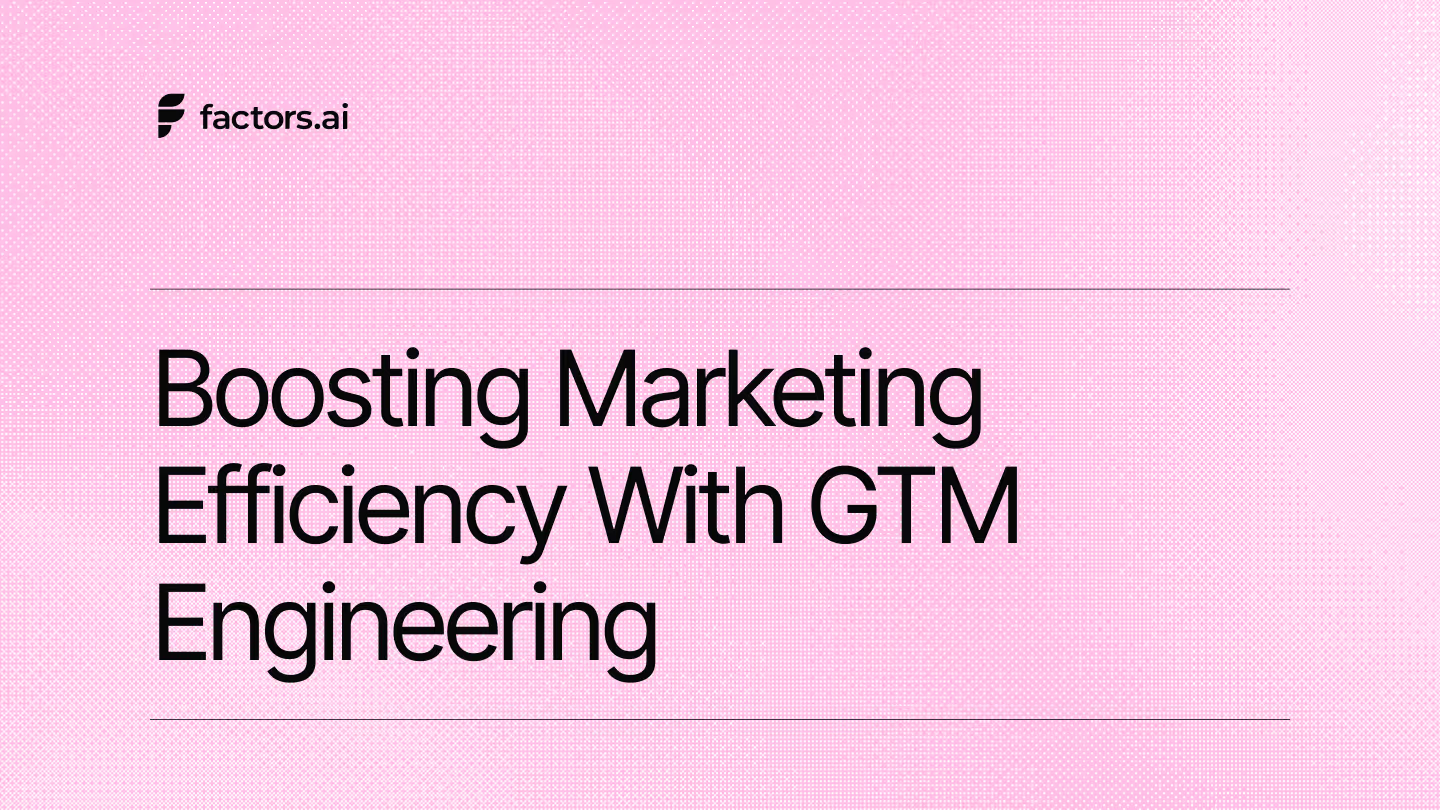
Boosting Marketing Efficiency with GTM Engineering
Think of a campaign you recently launched and generated fifty qualified leads from. The emails synced to your CRM, and that was it.
Sales leaders say the inbound leads are ‘low quality.’ Marketing says Sales isn't following up fast enough. The ops team is stuck in the middle, trying to fix broken zaps and CSV uploads.
This is the standard state of affairs for many B2B companies, from early-stage companies to established enterprises. We throw more money at the problem, hoping for different results. But the problem isn't usually the ad copy or the sales script. It's the pipes.
The connection between your systems is broken. That is where GTM engineering comes in to fix the mess and drive GTM engineering marketing efficiency.
TL;DR:
- Lead scoring assigns numerical values to prospects based on firmographic fit (company size, industry, tech stack) and behavioral signals (page visits, content downloads).
- Clay centralizes data enrichment from 100+ providers and automates scoring with formula columns.
- Pair it with a visitor identification tool like Factors.ai to capture anonymous website traffic at the account level, then let Clay find the new contacts and route them based on score.
- Start with five to seven scoring attributes, set threshold bands for routing, and refine quarterly based on conversion data.
First, What is GTM Engineering in B2B Marketing?
GTM engineering is the practice of using code, data, and automation to build scalable revenue infrastructure. The goal is simple: make data flow seamlessly across the entire customer lifecycle without human intervention.

People often confuse GTM engineering with Revenue Operations (RevOps) or Marketing Operations. But there’s a difference:
- RevOps often focuses on process, gtm strategy, and tool administration.
- Marketing Ops manages the platforms, such as setting up email campaigns or configuring the CRM.
- GTM Engineering goes deeper. It involves using technical skills to write scripts to connect APIs, building custom scoring models, and architecting data warehouses that feed operational tools.
To put this in perspective, let’s consider an example. A marketer decides to target a specific vertical. In this case, a RevOps pro maps out the sales stages, but the GTM engineer builds the full automation system that identifies those vertical-specific visitors, enriches their data, and routes them to the correct email sequences instantly.
Why Does Marketing Efficiency Break Without GTM Engineering?
Efficiency drops when data hits a wall. In most B2B setups, you have a CRM, a marketing automation platform (MAP), ad networks, and sales engagement tools. They all live in their own little bubbles.
Here is where the money leaks in your funnels:
- Leads sitting un-routed: Leads frequently wait hours or days before reaching the right person because old territory rules in lead routing systems don't work anymore. A prospect fills out a form, but instead of going to a rep, they sit in a general queue. Every hour of delay hurts your chance of converting them.
- Enrichment happening too late: Reps often receive just a name and an email. They have to stop selling to research potential customers on LinkedIn, guess the company size, or look for buying committees. This manual work kills sales efficiency.
- Attribution stuck at last-click: Demand gen teams typically rely on what their ad platforms report. Google claims credit for the last click, but this ignores the months of blog posts and webinars that actually built the trust throughout complex buyer journeys.
These problems get worse when your systems operate in silos.
- Systems operate in silos: Your CRM, marketing automation platform, and ad tools often live in different worlds. Marketing might keep nurturing existing accounts that Sales is already closing. The left hand doesn't know what the other half is doing.
- Why more spend doesn’t fix broken workflows? If your bucket has a hole, pouring in more water won't fill it. Increasing your ad budget when your lead routing is broken just creates more waste, not more revenue for the business. You have to fix the connections first.
How GTM Engineering Improves Marketing Efficiency?
GTM engineering improves marketing efficiency by removing friction from the funnel. It replaces ‘people doing robot work’ with actual robots. When you engineer your sales motion, you stop relying on Google Sheets and manual reminders and instead build workflows that run 24/7.
- Automation reduces manual effort. Scripts instantly check every incoming lead against icp criteria. Bad leads get filtered out before they clog the CRM. Good leads get flagged for immediate attention.
- Enrichment becomes automatic. You do not ask buyers for their company size or tech stack on a form. That creates friction. Instead, you ask for an email. The engineering layer calls an enrichment API, retrieves firmographic data, and appends it to the record.
- Workflows scale. Adding more salespeople to handle more leads is linear and expensive. Improving the code that manages those leads provides exponential leverage. A robust routing script handles 10 leads or 10,000 leads with the same speed and accuracy.
Automating Lead Routing and Scoring at Scale
To truly scale, you must automate lead routing and scoring beyond simple "if/then" rules. This is table stakes for modern B2B teams.

Traditional routing is often too rigid. It usually looks like: ‘If region equals North America, assign to John.’ But what if John is on vacation? What if the lead is a massive enterprise account that implies a higher potential deal size, meaning it should go to Sarah, your senior rep, regardless of region?
GTM engineering allows for dynamic logic:
- Instant Qualification: A lead hits the site. The system checks their IP, matches the company, checks the CRM to see if they are existing customers, scores them based on intent signals, and routes them instantly.
- Round Robin with Context: Leads are distributed fairly, but weighted by rep performance or availability.
- Slack/Teams Alerts: The moment a high-score lead takes action, the rep gets a ping with full context to automate outreach.
Connecting Marketing and Sales Systems End-to-End
The goal is to connect marketing and sales teams so they share a single data source. While many think this is a nice-to-have, it's essential for pipeline health.
Point-to-point integrations (like a basic Zapier connection) are often brittle because if one field changes, the whole thing breaks.
GTM engineering builds a unified data layer instead. Meaning:
- Website data (pages visited, time on site) flows into the CRM.
- CRM data (deal stage, revenue value) flows back into Ad Platforms for better targeting.
- Sales activity (calls, emails) is visible to Marketing for campaign optimization.
When the systems are connected end-to-end, the handoff becomes a continuous flow. Sales knows exactly what the prospect read before they hop on the call. Marketing knows exactly which campaigns drove the highest win rate.
Turning Anonymous Website Visitors into Warm Outbound Plays
Most B2B websites convert at 2% or 3%. That means 97% of your traffic leaves without saying a word. This is wasted potential for any sales-led or plg companies.
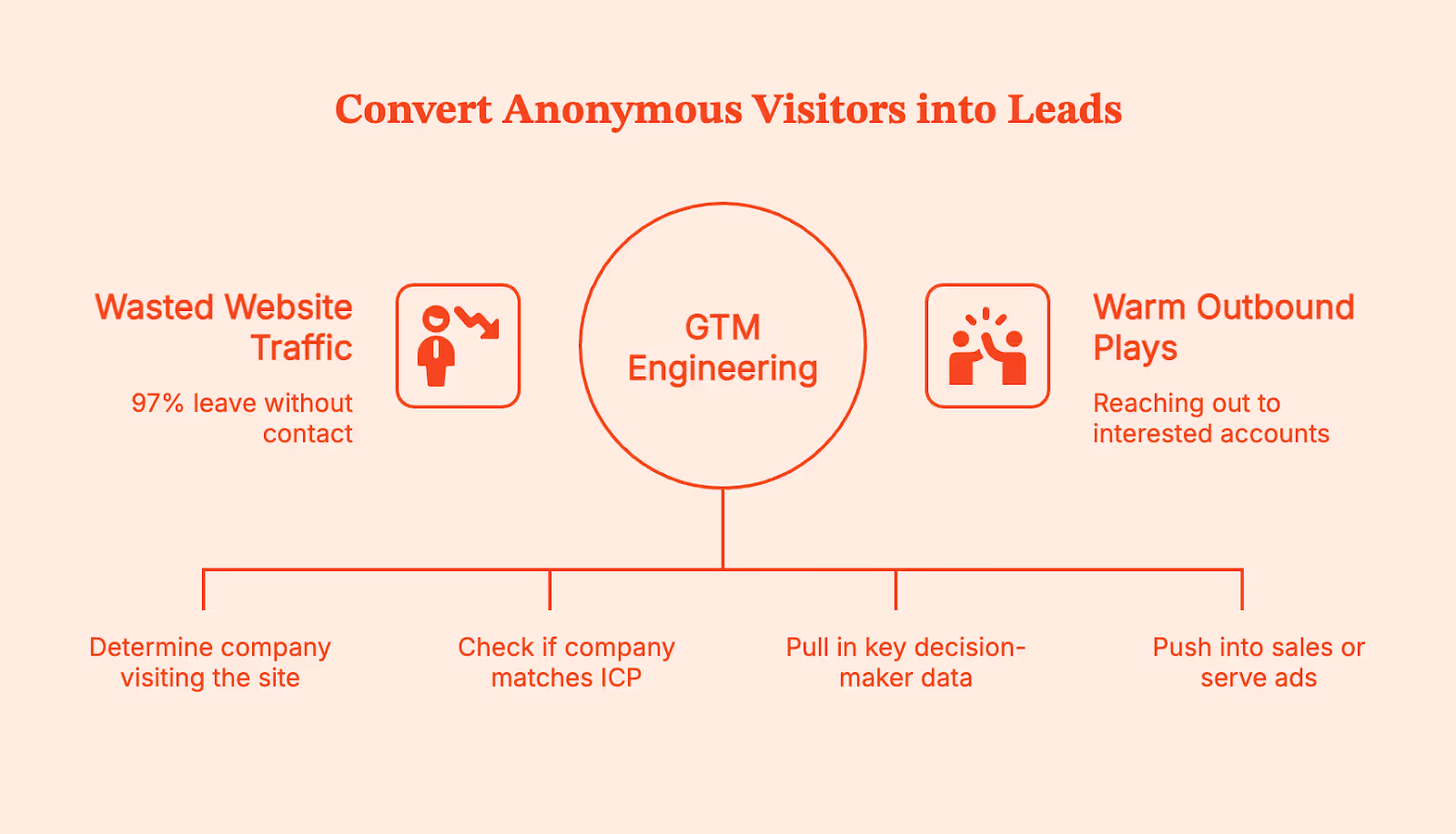
GTM engineering helps you turn a website visitor to warm outbound play. Here is the deep dive into the workflow:
- Identify: Use a tool (like Factors.ai) to identify the company visiting your site, even if they don't fill out a form.
- Filter: Automatically check if they match your Ideal Customer Profile (ICP)
- Enrich: Pull in contact data for key decision-makers at that company.
- Activate: If they showed high intent (e.g., visited the pricing page), automatically push them into a sales sequence or serve them a specific LinkedIn ad.
With this setup, you’re no longer cold-calling prospects. You are reaching out to accounts that are already looking at you, ultimately beating the competition.
Reducing CAC with GTM Automation and Better Targeting
Inefficiency is expensive. Every hour a rep spends researching a lead is money down the drain. Every ad dollar spent on an account that is already a customer is a waste.
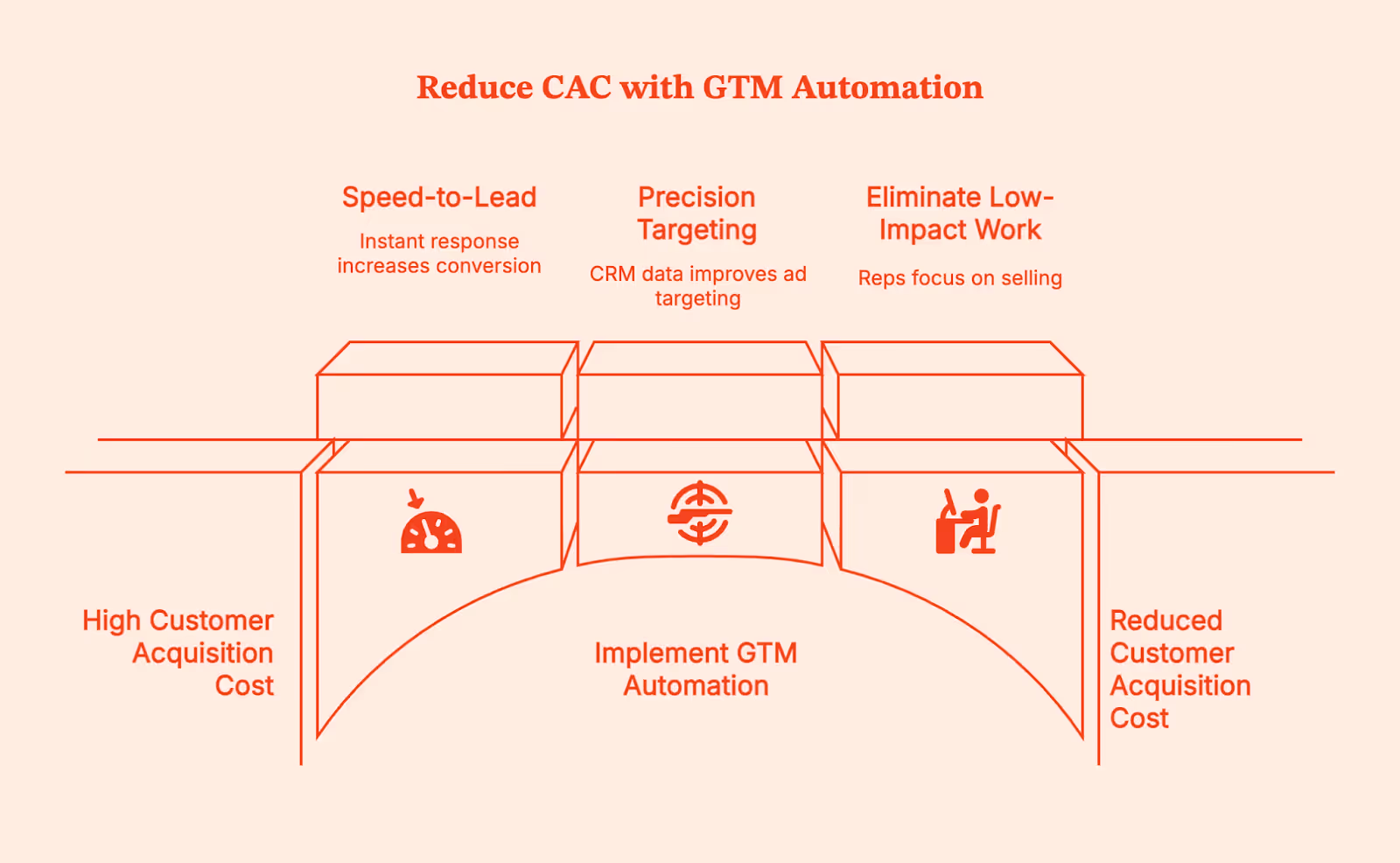
Fortunately, you can reduce CAC with GTM automation by focusing your resources where they matter.
- Speed-to-Lead: Responding within five minutes leads to higher conversion rates. GTM Engineering makes this instant.
- Precision Targeting: By feeding CRM data back into ad platforms, you stop bidding on bad fits.
- Eliminating Low-Impact Work: Reps spend time selling, not on data entry.
When you cut out the waste and increase the conversion rate through speed and context, your acquisition costs naturally drop, and your success becomes predictable.
Attribution and Revenue Visibility with GTM Engineering
Attribution is usually a mess because standard tools only see part of the picture. Google Analytics sees the click; Salesforce sees the close. They rarely agree on what happened in between.
GTM engineering stitches these identities together using AI tools and data science. It enables multi-touch attribution that tracks influence across the entire long sales cycles. You stop looking at vanity metrics and start seeing revenue drivers. You can see which blog posts actually influence closed deals, or how outbound calls interact with inbound marketing efforts.
This visibility changes how you spend money. You might find that a specific LinkedIn campaign has a high Cost Per Lead but a very low Customer Acquisition Cost. This allows you to create feedback loops that refine your demand generation.
GTM Engineering Use Cases for B2B SaaS Teams
When you implement this correctly, the benefits ripple across the entire organization, including post sales and self-serve motions.
- Marketing teams get cleaner data and better targeting. They stop fighting with Sales about lead quality because the definition of a ‘qualified lead’ is codified in the system logic.
- Sales teams get more meetings and better context. They spend less time doing admin work in the CRM and more time selling. They know why a lead was routed to them, which helps them frame the conversation.
- RevOps teams transition from being support tickets to being architects. They stop spending their days fixing broken data and develop skills to build systems that run themselves.
How Factors.ai Enables GTM Engineering for Marketing Teams
Factors functions as the intelligence layer for your GTM engineering stack. Having the right tools is the first step to doing your job effectively.
We start by de-anonymizing your traffic, then identify the companies visiting your site, and tell you exactly what they are doing. But we go further by combining the data with your CRM and ad platforms to create a unified account timeline.
Then, we help you act on it. You can set up automated workflows that push this data where you need it. If a high-intent prospect visits your pricing page, we can Slack your Account Executive immediately. If an ICP account engages with your top-of-funnel content, we can push them into a specific LinkedIn retargeting audience.
Factors gives you the building blocks to engineer a marketing machine that is efficient, automated, and revenue-focused for any early-stage or growth company.
FAQs for Boosting Marketing Efficiency with GTM Engineering
Q: What does GTM engineering mean in marketing?
A: It is the technical process of connecting your data, tools, and workflows using automation to make your Go-To-Market strategy run efficiently without manual work.
Q: Is GTM engineering only for large B2B companies?
A: No. Even small teams benefit from automation. If anything, small teams need it more because they have fewer people to do the manual work.
Q: How does GTM engineering improve marketing efficiency?
A: It automates repetitive tasks like lead routing and data entry, ensuring leads are handled instantly and data is always accurate, allowing for a human touch where it matters most.
Q: Can GTM engineering reduce CAC?
A: Yes. By improving conversion rates through faster follow-ups and better targeting, you lower the cost required to acquire each customer.
Q: How is GTM engineering different from RevOps?
A: RevOps is the strategy and process alignment; GTM engineering is the technical execution and automation that makes that strategy work.
Q: What tools are required to implement GTM engineering?
A: You typically need a CRM (like Salesforce or HubSpot), a data enrichment tool, and an orchestration/intelligence layer like Factors.ai to connect the dots.

Lead Scoring and Enrichment in GTM Engineering with Clay
Back in 2010, selling B2B was a different experience. A sales rep would have maybe ten leads come in all week. They had time to open each one, stalk the person on LinkedIn, read their company blog, and craft the perfect email. They had time to care.
But today, if you run a SaaS company, you’re likely getting hundreds of new leads daily.
If you ask a human to manually review 200 leads a day, you are setting money on fire. According to Salesforce's 2024 State of Sales report, sales reps spend about 70% of their week doing admin work, digging through data, and fixing messy CRMs. They aren't selling. They are janitors for your bad data.
Lead scoring fixes this. With this, you’re sorting the diamonds from the dust before your sales team ever logs in. I’ve built these systems for years, and right now, Clay is the tool changing how we do it.
What Are Lead Scoring Models and Why They Matter in GTM
Lead scoring is a technique for ranking prospects based on their likelihood to buy. A system that scores leads based on specific criteria assigns points based on two input categories:
- Explicit signals are firmographic data points you can verify, like the company size, industry, job title, annual revenue, and technology stack. A VP of Engineering at a 200-person fintech company scores higher than a marketing coordinator at a 10-person agency. These signals measure fit.
- Implicit signals track behavioral patterns like website visits, content downloaded, email opens, webinar attendance, and time on site. A prospect who viewed your pricing page three times and downloaded a case study shows stronger purchase intent than someone who read one blog post. These signals measure engagement.
Traditionally, scoring relied on rule-based models. Teams assign point values manually: C-level title earns 15 points, a company with 500+ employees adds 10, a pricing page visit contributes 5. Leads crossing a threshold route to sales. You can also implement negative scoring to subtract points for non-ideal traits, like students or competitors.
Predictive lead scoring uses machine learning to identify patterns humans miss. According to HubSpot's 2024 State of Sales report, 36% of sales teams now use AI tools for forecasting, lead scoring, and sales pipeline analysis.
The scoring threshold determines routing. Leads above a set number go directly to account executives as hot leads. Those in the middle range enter nurturing sequences. Low-scoring contacts stay in awareness campaigns until engagement increases.
How GTM Engineering Automates Lead Qualification and Routing
GTM engineers design, build, and maintain an automated lead routing system connecting data sources to sales actions. RevOps sets strategy and governance. GTM engineering builds the technical infrastructure to rank leads based on priority.
According to ZoomInfo's research, SMB and mid-market companies using engineered GTM workflows experienced a 31% reduction in CAC, while enterprise teams saw a 42% reduction.
Observe closely, and you’ll notice this automated qualification process follows a pattern:
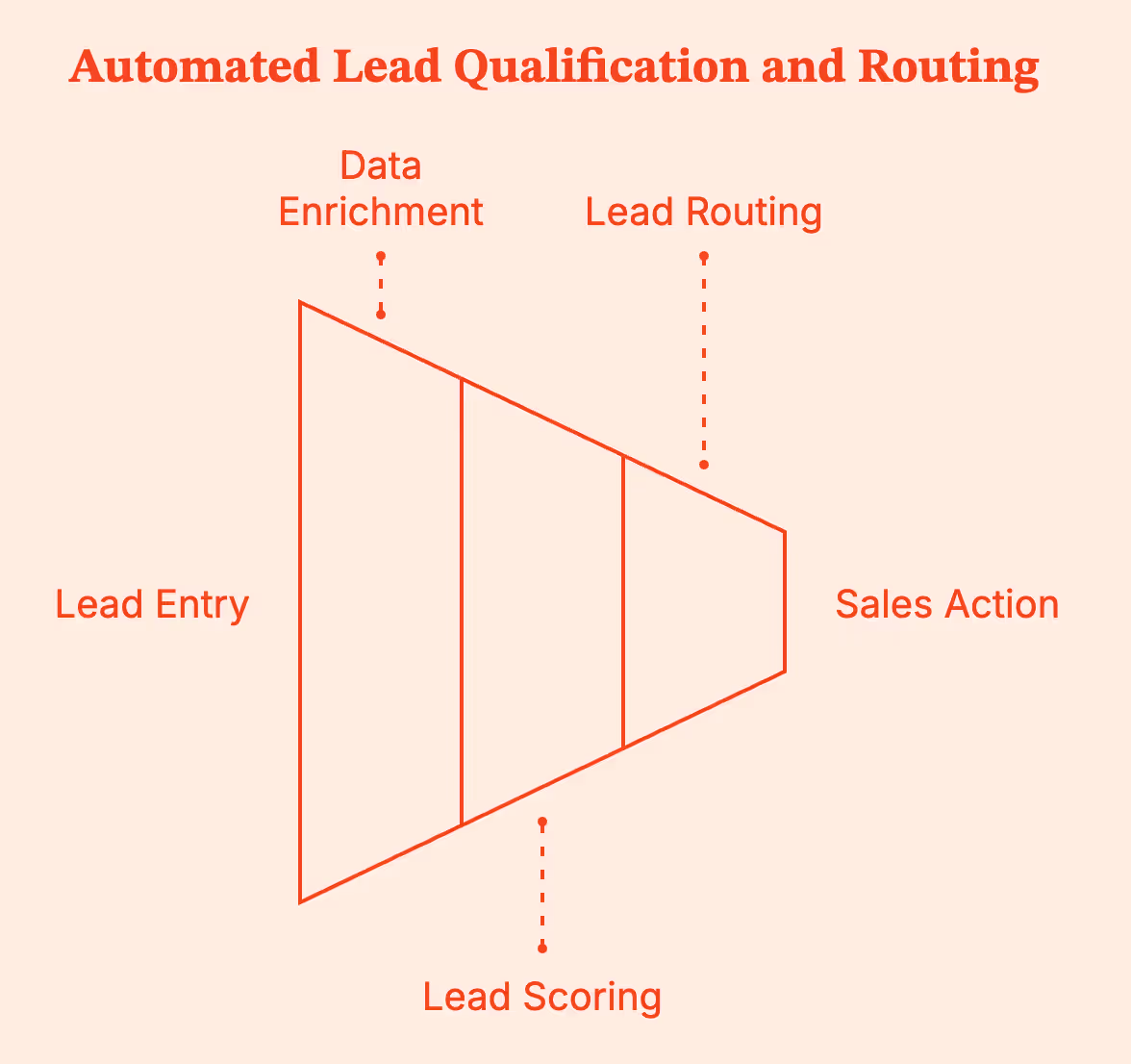
- An incoming lead enters through form submission, third-party import, or website visitor identification.
- The system pulls enrichment data and contact data from connected providers (company size, funding status, tech stack, employee count).
- Scoring formulas are applied to the enriched record and produce a numerical score.
- Routing rules direct the lead based on that score.
But you absolutely need to respond to your leads within the first 5 minutes to get the most out of your lead generation efforts. Automation makes this sub-five-minute response the default rather than the outlier, effectively bridging the gap between sales and marketing.
GTM engineers also build feedback loops into scoring systems. When sales mark a lead ‘closed-won’ or ‘disqualified,’ that outcome feeds back into the model, refining future predictions.
Why Clay Works Well for Lead Scoring in B2B Marketing
Clay consolidates data enrichment, scoring, and routing into one platform. Instead of connecting separate sales automation tools for firmographic data, email verification, intent signals, and CRM updates, GTM teams build complete workflows in a single interface.
The platform aggregates 100+ data providers into a waterfall enrichment model. When one source fails to return a phone number or email in your contact database, Clay automatically queries the next provider. This approach doubles or triples match rates compared to single-provider setups.
Clay raised $40M in Series B at a $1.25B valuation following 6x growth in 2024. The adoption came from teams consolidating fragmented enrichment stacks into one fully automated system.
- Lead Scoring: Clay uses formula columns to build point-based models, assigning scores based on enriched data and custom signals like Employee count, Funding stage, Technology stack, and Job title seniority.
- Advanced Scoring: Behavioral data from connected intent providers can be layered onto the point-based models to identify the hottest prospects.
- Routing Logic: The platform supports conditional logic for multi-path routing.
- High-Scoring Enterprise Leads are instantly routed to a named Account Executive (AE) with a Slack notification.
- Smaller Companies with similar engagement enter an automated email sequence.
- Instant Updates: Routing and actions happen instantly when lead records are updated.
CRM integrations push enriched, scored leads into Salesforce, HubSpot, and other systems. Bi-directional syncs update Clay tables when CRM fields change, creating closed-loop feedback on model accuracy.
Building Lead Scoring Models in Clay: A Step-by-Step Guide
Before opening Clay, define your scoring criteria. What are the explicit attributes correlating with closed deals: company size ranges, industries, job functions, and technologies used?
Then identify behavioral signals indicating product interest: specific page visits, content consumption patterns, and email engagement.
Step 1: Capture and Normalize Lead Data
With Clay, you can either import existing data via CSV uploads, CRM syncs, webhook inputs, or direct integrations with form providers. You can even import data from Google Sheets or use web scraping to find new prospects.
Or if you don't have data, you can also find people, companies, and jobs, and even local businesses, directly from within Clay.

Once you have the data, you can use Clay’s built-in AI to enrich and standardize it for later use in the sales process.
Step 2: Configure Enrichment
Import the data that you have collected into an existing or a new table, and the actions column should show you enrichment workflows.

You can pick enrichments like employee count, annual revenue, funding status, and technology stack to form a solid firmographic foundation for your qualified leads.
Step 3: Build Scoring Formulas
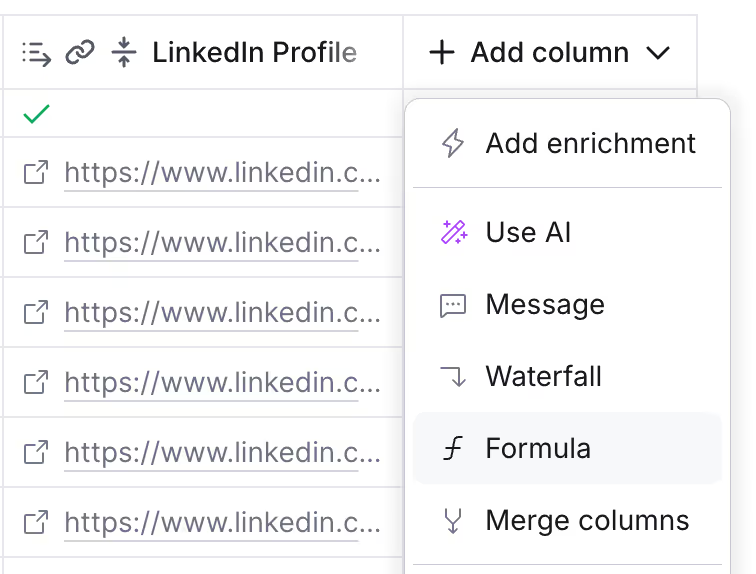
Now, on to the actual lead scoring. Create a formula column that assigns points based on the following criteria.
Here’s sample logic for a B2B SaaS targeting mid-market companies:
Sum these columns into a total score field. Define threshold bands: 60+ points routes to sales, 30–59 enters nurture sequences, and below 30 stays in top-of-funnel awareness.
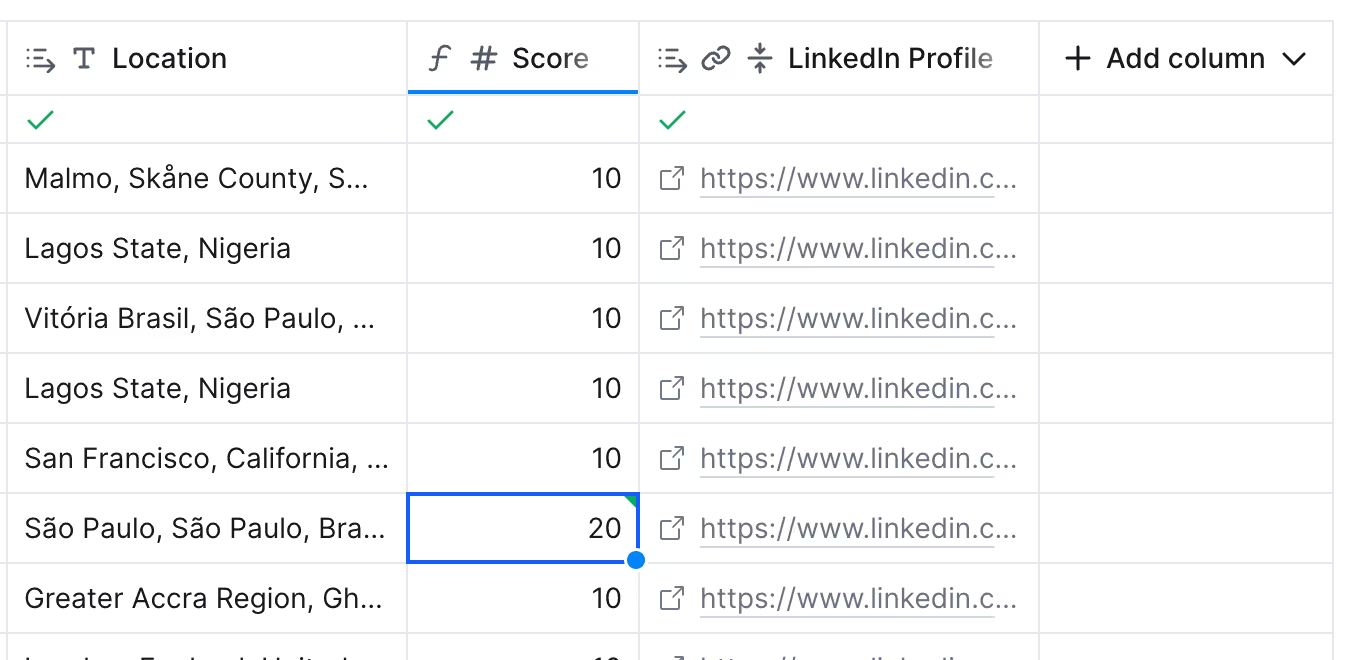
Once you have the scores populated, it's time to move to routing.
Step 4: Configure Routing Actions
Clay has multiple ways for you to route based on your data from your table to your email tool, CRM, or even a webhook. Use a routing system to ensure leads get to the right rep.

For instance, a lead hitting 60 points should immediately:
- Create or update a CRM record with all enriched data
- Send a Slack notification to the assigned rep
- Log the scoring rationale for the sales context
Lower-scoring leads trigger different actions: add to email sequence, update marketing automation tags, or hold for future re-scoring. You can even distribute leads evenly using a round robin logic for your sales team.
Best Practices for Automating Lead Routing and Scoring
- Run continuous data quality checks. Enrichment providers return stale or incorrect data more often than vendors acknowledge. Build verification steps that flag records with mismatched signals—For example, a 5-person company claiming $500M revenue. The Salesforce State of Sales report found that only 35% of sales professionals completely trust the accuracy of their organization's data. Better data hygiene directly improves scoring accuracy and sales efforts.
- Score fit and intent separately. A lead with strong firmographic fit but no behavioral engagement differs from one showing active research patterns across different buyer journeys. Two-axis scoring rates both dimensions independently. High-fit plus high-intent gets priority. High-fit with low-intent gets targeted nurturing.
- Match follow-ups to behavior. Someone who visits your competitor comparison page needs different information than someone browsing case studies. Build a routing system connecting lead behavior to appropriate messaging sequences, whether it's for cold outreach or warm follow-ups. The HubSpot 2024 State of Sales report found that 59% of sales reps now say leads from their marketing efforts are high quality—a significant improvement from previous years. Better targeting and personalization drove that change.
- Close the feedback loop. Sales must report back on lead quality, and that data must inform scoring adjustments. If leads scoring 55–60 points consistently fail to convert while those at 70+ perform well, your threshold needs recalibration. Review scoring accuracy quarterly to overcome common challenges in alignment.
From Website Visitor to Warm Outbound Play: Workflow Examples
Only 1-5% of B2B website traffic converts through forms. The remaining 95% leaves without identifying themselves.
If you want to make the best of this anonymous traffic, using the right tools like a website visitor identification tool can recover a portion of that invisible pipeline by matching anonymous IP addresses to company databases and, in some cases, to individual contacts.
Factors.ai uses a waterfall model combining data from 6sense, Clearbit, Demandbase, and Snitcher to identify up to 64% of anonymous visitors at the account level. For individual contacts, geo-location and job title triangulation can pinpoint roughly 30% of visitors. That coverage exceeds what any single-source competitor provides.
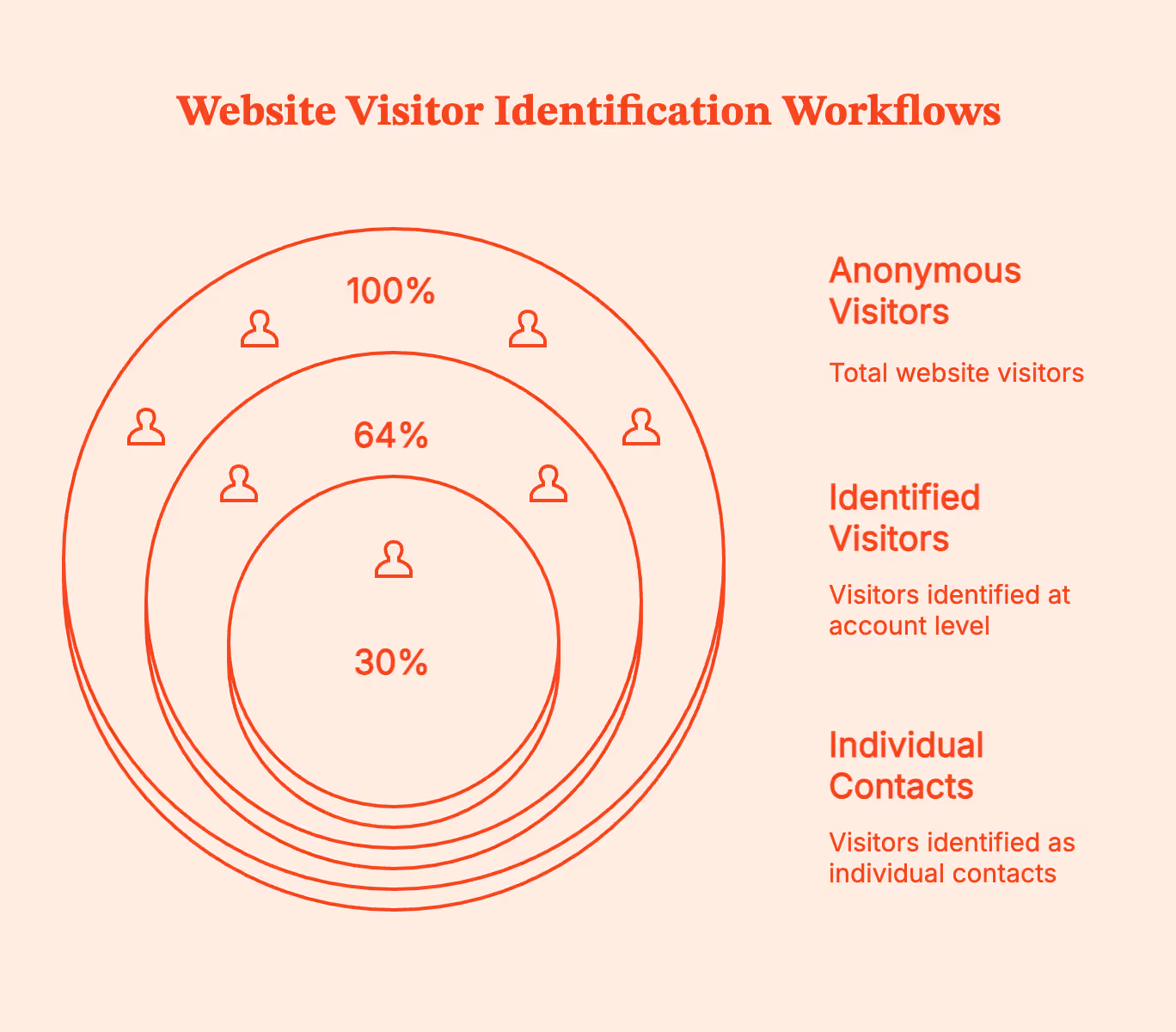
When Factors identifies a high-intent visitor, the data can be sent directly to Clay for enrichment and scoring via the Factors API.
Here are three workflows you can implement to see how this works.
1. Inbound Form → Enrichment → Score → Route
A prospect submits a demo request. The form data triggers a webhook to Clay, which enriches the record with employee count, funding stage, tech stack, and verified contact details.
Scoring formulas run automatically. Leads crossing the threshold route to an AE's calendar for immediate booking, allowing reps to focus on closing. Below-threshold leads enter a nurture sequence matched to their industry and company size.
2. High-Intent Page Visit → Personalized Outreach
Factors detect a target account visiting the pricing page multiple times in one week. That behavioral signal, combined with firmographic fit, triggers a webhook to Clay.
Clay uses the company domain and its waterfall enrichment to identify decision-makers: the VP of Engineering, the Head of Product, and the relevant director. Each contact gets enriched with a LinkedIn profile, direct email, and recent company news. The contacts score above the threshold and trigger personalized outreach referencing the pricing page activity.
The sequence works because Factors captures the intent signal (company X is actively researching) and Clay identifies who to contact at that company to generate more leads.
3. Buying Committee Signal → Real-Time BDR Alert
Factors tracks engagement patterns, indicating multiple stakeholders are involved. The same company visits the integrations page, the case studies section, and the security documentation within a short window. That pattern suggests a buying committee is forming.
Then, Factors pushes the account via webhook to Clay, and Clay enriches the company record, identifies contacts matching your buyer personas (engineering leadership, procurement, security), and pulls contact details for each. A Slack alert notifies the assigned BDR with full context: company name, pages visited, engagement frequency, and the list of relevant contacts to pursue from your ad platforms or organic traffic.
These workflows depend on two tools doing what they do best: Factors capturing account-level intent signals, and Clay enriching and identifying the right people to contact.
Measuring Success: KPIs and Optimization Strategies
Track these metrics to gauge scoring effectiveness:
- Lead-to-SQL Conversion Rate: Measure the conversion rate before and after the scoring implementation to quantify impact. Track conversion rates by score bracket to validate the model.
- Pipeline Velocity: Track average time from lead capture to first sales conversation. Automated scoring and routing should compress this window. Target benchmark based on the HBR research: first contact within one hour for high-scoring inbound leads.
- Score Accuracy: Compare conversion rates between high-scoring and low-scoring leads. The gap should be substantial. If leads scoring 40 points convert at the same rate as those scoring 80, the model needs recalibration.
- Manual Hours Saved: Calculate rep time previously spent on lead research and qualification. The Salesforce State of Sales found that reps spend 70% of their week on non-selling tasks. Effective scoring automation returns a portion of those hours to actual selling.
- Score Distribution Trends: Monitor how your lead population scores over time. Sudden shifts indicate market changes, data quality issues, or lead-source problems that warrant investigation.
Bringing It Together
As much as we’d like it, we can't just set lead scoring up and walk away. The market changes, and so should your scoring. This is the ultimate guide to staying agile.
Every quarter, sit down with your sales lead. Ask them, ‘Who are the best deals we closed this month?’ Then look at the data. If you closed three deals with hospitals but your model assigns them zero points, the calibration is wrong. Update the formula for the scores.
The goal here is response speed: Automation buys you speed, and speed gets you deals.
So start small. Identify five attributes of a good customer and build that table in Clay. Add website visitor enrichment with Factors, and you have a working lead gen engine.
FAQs for Lead Scoring and Enrichment in GTM Engineering with Clay
Q: What is a lead scoring model, and how does it work?
A: Think of lead scoring as a ranking system for your potential customers. It assigns a numerical point value to every lead to tell you who is ready to buy and who is just browsing. It works by combining two types of data:
- Fit (Who they are): Do they match your ideal customer profile? (e.g., right industry, company size, job title). 2. Behavior (What they did): Did they visit your pricing page, download a case study, or open your emails?
You set up the rules like "+10 points for a CEO" or "+20 points for requesting a demo." When a lead crosses a certain score threshold (say, 60 points), they get flagged as "Sales Ready," so your team knows who to call first.
Q: Can Clay automate both enrichment and routing?
A: Yes, that is exactly what it's built for. Clay handles the entire pipeline in one place. First, it enriches the data by sourcing information from over 100 providers (e.g., a lead's phone number or a company's revenue). Then, it runs your scoring logic against that new data. Finally, it handles the routing: automatically sending high-scoring leads to your CRM (like Salesforce), messaging a rep on Slack, or dropping lower-scoring leads into an email nurture sequence.
Q: How does automated lead scoring improve GTM velocity?
A: It removes the "research tax" that slows sales reps down. Without automation, reps waste hours manually searching for companies and checking LinkedIn to determine whether a lead is good. With automated scoring, that data is instantly available. Companies that respond to a lead within one hour are seven times more likely to qualify them than those who wait. Automation ensures you hit that one-hour window every single time, turning interest into conversations instantly.
Q: What’s the difference between rule-based and AI scoring?
A: Rule-based scoring is manual. You sit down and decide, "I think a VP title is worth 10 points." It’s great for control but relies on your best guess. AI (predictive lead scoring) uses machine learning. It looks at your history of closed deals and finds patterns you might miss. It might notice, for example, that leads who use a specific obscure technology convert 3x faster, and it automatically assigns them a higher score.
Q: How often should lead scoring rules be reviewed?
A: You should do a deep dive quarterly. Markets shift, and buyer behavior changes. So if you notice your sales team is rejecting a lot of "high-scoring" leads, your model is broken. If the sales team tells you leads scoring 50 points are closing better than leads scoring 80, you need to adjust your weightings immediately.
.avif)
AI Sales Tools: What Actually Helps Reps Sell (Not Just Click Around)
I'm in marketing, but the nature of my job requires me to speak with sales leaders about twice a week. They've all been saying something to this end lately, “We have AI in our stack… but I’m not sure it’s actually helping us close more deals.”
There are so many options for AI sales tools available now, but discernment is a challenge. What's good? What fits your needs?
So I wrote this guide. Hopefully, it'll help you make a practical decision that breaks your budget. I've tried to go beyond a typical ‘27 tools you must try’ list, and tell you what these tools do well, where they fall short, and how they can boost pipeline velocity, rep productivity, and forecast accuracy.
TL;DR
- AI delivers the most value when it takes work off a rep’s plate and helps them focus on the right deals. It is NOT a replacement salesperson.
- The most reliable wins from AI come from practical uses like automatic call summaries, cleaner CRM data, intent-based account prioritization, and better coaching inputs for managers.
- Teams will get burned if they use AI to scale outbound too fast or stack multiple tools that all basically do the same thing.
- AI signals are most effective when they start better conversations in pipeline reviews and 1:1s. Don't treat AI responses as final answers or hard decisions.
- In practice, a small number of tools with clearly defined jobs will outperform a crowded sales stack full of overlapping “smart” features.
What are AI sales tools?
AI sales tools use machine learning and automation protocols to study sales data and suggest/initiate necessary actions across the sales pipeline. This covers prospecting, outreach, deal management, forecasting, and coaching.
Traditional sales tools just record the data, but sales AI tools can actually interpret it. The best AI tools can:
- Suggest who a sales rep should contact for a specific conversation
- Suggest conversational topics and notes based on the deal context
- Flag any deal showing signs of risk
- Take over grunt work: note-taking, follow-ups, and data logging
Your AI sales assistant can use intent. They can turn raw data into intelligence and guidance.
For instance, Factors.ai can analyze existing account engagement and intent signals to surface which accounts are heating up, which ones are stalling, and where sales teams should focus next.
Why is AI in sales now?
AI can significantly change how sales professionals operate, as well as data density and workflow maturity. It can impact sales performance by evaluating data across:
- Emails, calls, meetings, demos
- CRM activity across every stage
- Intent signals and engagement history
In fact, Salesforce’s sixth State of Sales report found that 83% of sales teams with AI saw revenue growth vs. 66% without AI.
Mainstream tools like Pipedrive and Salesforce have recognized AI's efficacy, and are configuring AI integration capabilities into their stacks. They now ship with built-in native AI assistants.

Core AI sales use cases across the funnel
Don't just jump into a list of tools. Start by figuring out where reps lose time, focus, or momentum.
Now look for tools where AI addresses these gaps.
Here's how AI can help sales teams across the funnel:

- Prospecting & list-building
At the top of the funnel, AI works by answering: “Who is worth a rep’s time today?”
AI tools can analyze and deliver data-driven insights by:
- Finding accounts similar to already won customers, rather than just firmographics
- Pay attention to leads by studying intent signals, engagement history, and past outcomes
- Enrich contact data automatically, so reps have everything they need to do their job
AI tools turn static lead lists into dynamic prioritization.
For instance, Factors.ai can flag which target accounts are actively researching, engaging with content, or signaling buying intent, so reps focus on where momentum already exists rather than guessing.
- Outreach & follow-ups
At this stage, AI can shine (or fail) by:
- Creating first drafts of emails or suggesting conversation insights or call openers
- Recommending the best follow-up times based on engagement patterns
- Summarizing account context before each call so reps stay up to date.
AI helps with closing deals by compressing prep time, cutting down repetitive tasks, and keeping reps up to date.
- Live call support & conversation intelligence
AI tools are most obviously beneficial at this stage by:
- Recording and analyzing calls
- Highlighting objections, competitor mentions, and decision criteria
- Gauge talk ratios, pacing, and engagement
- Pick up any coachable moments for managers
Reps sell. AI listens. Managers coach with evidence instead of anecdotes. Over time, you find out what winning calls sound like, where deals die, and which behaviors likely move opportunities forward.
- Pipeline management & predictive sales AI
Honestly, I'm convinced that sales forecasting emerged straight from hell. The right predictive sales AI tool can make hell much less hot.
Give AI historical test data and real-time activity. Then it can:
- Forecast close dates.
- Read-line deals that look acceptable on the surface but lack momentum
- Highlight opportunities that may be slipping without notice.
For RevOps and sales leaders, AI gives early warnings so forecast conversations become strategic, not reactive. For example, Factors.ai points out which opportunities and target accounts are showing rising or declining activity, giving reps additional context before deals quietly slip.
See for yourself. Book a demo.
- Admin automation & CRM hygiene
Modern sales assistants can go a long way in:
- Logging calls, emails, and meetings. No more human grunt work.
- Update CRM fields based on activity
- Sum up meetings and suggest next steps
Reps can be spared the drudgery of manual data entry. AI-powered tools can keep CRMs accurate and let humans focus on improving pipeline hygiene and forecast reliability. They can also help achieve the valuable but hard to attain B2B sales And marketing alignment.
Types of AI sales tools
It's hard to pick an AI sales tool when there’s a new one popping out every week. Vendors invent new labels. Analysts redraw the map every year.
Sales teams often end up comparing tools that don't even solve the same problem.
To clear the confusion, let's try putting these tools into buckets: five functional categories, to be precise.
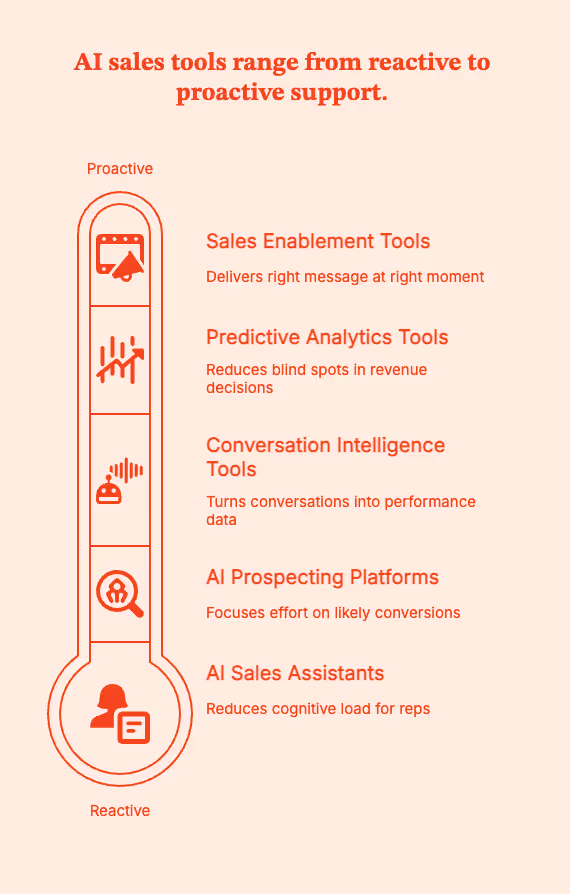
1. AI sales assistants/copilots
Mental model: “Reduce cognitive load for reps.”
AI features have quickly popped up within existing tools: emails, calendars, and CRMs. Their goal is to handle the small, repetitive decisions that don't need human intelligence but drain human effort.
In practice, the AI assistant can:
- Summarize calls and meetings, so reps don't have to
- Recommend next actions based on deal activity
- Glean relevant content or context without forcing reps to search through old conversations
When choosing tools in this bucket, check if the AI assistant requires reps to change how they sell or check a separate dashboard. You need friction removal, not more work.
2. AI prospecting & enrichment platforms
Mental model: “Focus human effort where it’s most likely to convert.”
AI tools in this bucket combine large datasets, intent signals, and AI ranking models to flag which accounts and contacts are actually worth pursuing at each moment.
These tools can:
- Surface lookalike accounts based on past deal wins
- Top-rank the right leads based on behavioral and intent data
- Enrich contact records automatically
AI tools for prospecting and enrichment are perfect for SDR teams working with high volumes. It saves time spent on researching, which can be spent talking to the right people.
3. Conversation intelligence & coaching tools
Mental model: “Turn conversations into performance data.”
Conversation intelligence tools record and analyze sales calls to pull up the actual valuable insights that will move deals forward.
These tools can:
- Underline objections, competitor mentions, and buying signals
- Find the talk tracks that helped with closing deals
- Alert on risky patterns that led to losses
- Speed up onboarding
Pattern recognition is the key value these tools bring to your table. It will give managers real-time coaching on what to say, what to talk up, deal reviews, and training.
4. Predictive analytics & forecasting tools
Mental model: “Reduce blind spots in revenue decisions.”
Forecasting tools powered by AI are mostly used by RevOps and sales leadership. They evaluate historical deals, pipeline behavior, and real-time engagement to:
- Score deal risk on more data
- Predict revenue and possible close dates
- Call attention to trends at the rep, territory, or segment level
When used carefully, these insights can turn opinion-based debates into informed discussions.
5. Sales enablement & content recommendation tools
Mental model: “Deliver the right message at the right moment.”
AI-powered enablement tools work to minimize guesswork during live deals.
These tools can:
- Suggesting the deck or case study to use at a given funnel stage
- Recommending content based on deal context or buyer behavior
- Tracking the content actually impacting deal progression
Tools in this bucket improve pipeline consistency and prevent message drift. The result is better deal health and eventual revenue growth.
Pro-Tip: Pick one or two categories that map directly to their biggest constraints: rep time, pipeline visibility, or message consistency.
How sales teams actually use AI: what sticks vs. what does not
What works:
What does not work:
Pro-Tip: Practical guidance and guardrails:
- Pilot one use case at a time. Focus on the smallest, highest-friction win. Example: reduce admin time for SDRs by automating meeting notes and follow-up tasks for 30 days.
- Keep humans in the loop. Require quick rep confirmation for AI-suggested emails and CRM updates in the first 30 days.
- Track adoption, time saved, meeting conversion, and CRM completeness. Keep dashboards simple.
- No mass automation. Limit sequence scale and require contextual signals before broad email sends.
How to choose the best AI sales tools: buyer checklist
If you’re evaluating AI sales tools, the goal isn’t to find the smartest AI. It’s to find the tool that solves a specific sales problem without creating new ones.
Use this checklist to keep evaluations grounded, avoid shiny-object purchases, and don’t pick tools that solve specific problems without creating new ones.

1. Clearly define the job you’re hiring the tool for
Ask:
- What outcome do you want to improve?
- Is the tool for prospecting, pipeline visibility, rep coaching, forecasting, or admin reduction?
- Which part of the sales funnel is broken or inefficient?
- What metric should move if this works?
Stay away from tools that promise to do everything.
2. Validate data sources and CRM integrations
AI tools are only as good as the data they can access. Check:
- Native integrations with your CRM
- Read and write access (No read-only dashboards)
- Connections to email, calendar, dialer, and call recording tools
Toss out any tools that require reps to manually copy insights from one system to another.
3. Evaluate the rep experience in real workflows
Judge the tool from the sales rep's point of view. Ask:
- Does the tool live inside the CRM, inbox, or calendar?
- Does it reduce clicks?
- Can a rep understand why the tool works under 60 seconds?
Any tool needing too much formal training will slow down your reps.
4. Scrutinize pricing and expansion costs
Pay close attention to pricing in scenarios where tool usage scales. Double-check:
- Per-seat vs flat-fee pricing
- AI add-ons being priced separately from core licenses
- Usage-based limits on transcripts, emails, or analyses
5. Assess security, compliance, and data ownership
How does the AI sales tool store and expose your call recording, email analysis, and AI training data?
Double-check the following:
- Where data is stored and how long it’s retained
- Whether customer data is used to train shared models
- Compliance with SOC 2, GDPR, and consent requirements
- Clear opt-out or redaction controls
6. Evaluate vendor maturity and long-term viability
Don't look at AI sales tools that are too early-stage or experimental.
Assess:
- The tool's product roadmap after the next quarter
- The brand's financial backing and customer base
- Support quality and response times
- Clear positioning and history of pivots
7. Run a time-boxed pilot with real success criteria
Demand proof before purchase. Pilot the tool with a small, representative group. Define 2–3 success metrics in advance, and track them in a 30–90 day evaluation window.
Your chosen AI tool should remove friction, sharpen focus, and help sales teams make better decisions without changing how they sell.
Implementing AI in your sales org (60–90 day playbook)
Risks, limits, and common mistakes
AI is a multiplier. It expands what's already working (and not working) in your sales funnel.
If teams ask AI to solve the wrong problem, deploy it too broadly, or trust it more than is reasonable, it will make existing problems worse.
- Over-automating outbound and losing trust
Do not let AI scale outbound before its relevance is proven.
AI can send more emails, faster, to more people. But volume doesn't work if messages aren't grounded in real context. If teams automate first-touch and follow-ups without close control and review, they'll get lower reply rates, burned domains, and prospects who tune out.
- Buying too many overlapping tools and creating noise
Avoid AI tool sprawl. Don't get one tool for call summaries, another for emails, another for forecasting. You'll end up with six tools, each with its own alerts, dashboards, and workflows.
Eventually, reps just stop trusting any open signal because everything is "important".
Consolidate tools ruthlessly. Pick a few that integrate deeply.
- Blindly trusting AI scores without context
AI engines will generate deal risk scores, lead rankings, and forecast predictions based on historical patterns. They are useful, but don't take them as gospel truth.
AI will miss a last-minute executive escalation, a political blocker, or customer relationships outside the CRM. Treat the insights it offers as prompts for conversation, not decisions.
If a model flags a deal as at risk, ask why and dig deeper.
- Ignoring consent, compliance, and data ethics
Call recordings and email analysis, and AI training data raise real questions about consent, data ownership, and regulatory exposure. And no, not all vendors will handle this for you by default.
Get clear answers to basic questions: where data is stored, who can access it, how long it is retained, and whether it is used to train shared models.
- Forgetting that AI reflects your existing sales motion
AI will not fix broken fundamentals. If your ICP is fuzzy, your messaging is generic, or your CRM data is unreliable, AI will simply scale those flaws faster.
Set clear qualification standards. Start with already decent outbound volume. Expect managers to help the AI engine learn, too.
Get AI to do more so you get more done
AI sales tools are no longer experimental. They are also no longer competitive on their own.
Sales teams win by intentionally picking which tools to use. They have clear problems to solve, applied AI with restraint, and built habits around exactly that.
Pro-Tip: The most effective AI tools will probably feel understated. Factors.ai focuses on clarity and prioritization rather than volume, so your conversation intelligence is data-backed and relevant. No fluff.
Pick fewer tools with sharp jobs. Ideally, your AI models live inside existing workflows instead of getting reps to choose new ones. More ideally, it delivers insights that make managers better coaches, not better micromanagers.
Don’t buy AI to feel modern. Buy it to remove friction.
Summary: AI Sales Tools
AI sales tools have gone from “nice to have” to “hard to ignore.” But just having AI in your sales stack won't close more deals. You need intent.
The best-performing sales orgs use AI to solve very specific problems like reducing admin work, spotting buying intent earlier, and improving pipeline visibility. They do not expect AI to magically fix broken processes or replace human judgment.
AI sales tools do certain things realistically well, fall short in others, and succeed/fail based on how they are used in the field. The most reliable wins come from getting AI to do the grunt work, such as call summaries, CRM hygiene, intent-driven prioritization, and early warning signals for deals about to stall.
The biggest failures come from over-automated outbound, too many overlapping tools, and treating AI scores as accurate without context.
Teams should evaluate AI sales tools based on the job-to-be-done. Prospecting, coaching, forecasting, and admin reduction require different types of AI and different levels of human oversight.
Tools like Factors.ai use AI where it returns more value: interpreting engagement and intent signals so reps and managers can focus on the right accounts at the right time.
Buy AI to remove friction, not to feel modern.
Frequently Asked Questions for AI Sales Tools
Q. What are AI sales tools?
AI sales tools utilize artificial intelligence to enable sales teams to work more productively and profitably. They actively analyze patterns across leads, deals, and customer interactions to suggest actions, surface risks, and reduce manual work.
Q. What is an AI sales assistant?
An AI sales assistant is a virtual intern or helper adept at handling mundane routine tasks such as logging, summarizing calls, and suggesting next steps. These tools work to save time and mental space for reps so they can focus on selling.
Q. How does AI help in sales?
AI can study, interpret, and evaluate large volumes of sales data that humans simply cannot process on their own. It points out leads worth the attention, deals that are at risk, and where reps should focus for maximum productivity and forecast confidence.
Q. What is predictive sales AI?
Predictive sales AI uses historical deal data and real-time engagement signals to make informed predictions about sales outcomes, eg, close likelihood and timing. While it cannot replace human judgment, AI here can provide early warnings.
Q. Which are the best AI tools for sales?
You won't find one "best" AI sales tool. Most teams combine a few tools, like AI sales assistants, prospecting or intent platforms, conversation intelligence tools, and forecasting or RevOps software...all tailored to their particular needs.
Q. Can small businesses use AI sales tools?
Absolutely. Most well-known CRMs and SMB-focused tools have already incorporated AI features like call summaries, email suggestions, and basic forecasting. Prices, too, are more affordable. Small teams might see value faster because AI removes admin work and cuts staffing costs that they can't afford.
Q. Can AI replace sales reps?
Absolutely not. AI works great at handling data-heavy and repetitive tasks. But all complex deals depend on human judgment, trust, and relationships. AI cannot do what humans do, but it can help humans do it better.
Q. How much do AI sales tools cost?
Pricing varies depending on brand and features. AI-enhanced CRMs often start around $15–$50 per user per month. Advanced platforms can cost much more depending on features, add-ons, and usage limits.
Q. Can AI sales tools integrate with Salesforce and HubSpot?
Yes, most modern AI sales tools are built to integrate with popular CRMs like Salesforce and HubSpot. Tools can connect to your existing stack, read and update data, so they fit naturally into existing sales workflows.

Zapier vs Make vs n8n: Which Workflow Automation Tool Fits GTM Engineering Best?
Every growing GTM team eventually hits this wall. Automations break mid-workflow; simple tasks require complex workarounds; your team spends more time maintaining workflows than doing their actual job; what worked for 50 leads isn't working for 500… The signs are everywhere: you have outgrown your current GTM system.
So you start looking for something better and quickly narrow it down to three names that keep coming up everywhere: Zapier, Make, and n8n.
So, you go online to figure out which one fits your needs, and find this:
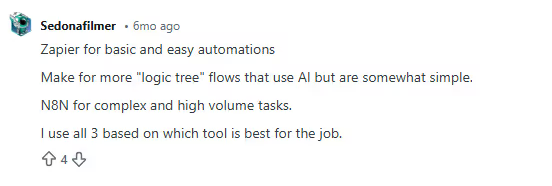
Fair enough. But what does that actually mean for you?
So you scroll a bit more and find another take.

Okay… still vague and doesn’t address your concerns. You find one opinion that says, “It depends on your use case.”:
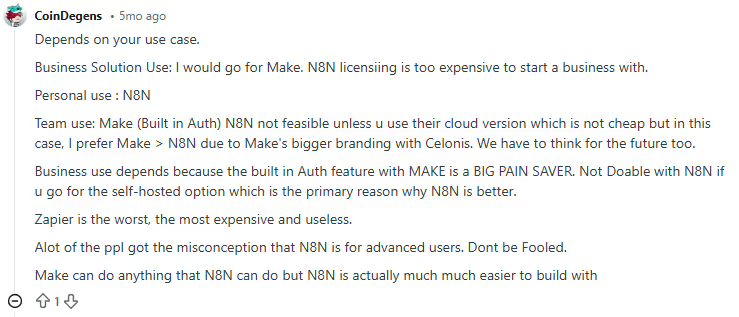
And this:

You keep digging, and now you’re seeing completely opposite opinions:
Zapier is useless or the best thing to ever happen to GTM teams
Make is the only serious option, or it’s a joke.
n8n is either overkill or the best thing ever, depending on who you ask.
At this point, you are ready to… give up!
You started this search looking for clarity. Somehow, you’re more confused than when you began. Here’s the thing: These answers aren’t wrong. They just don’t reflect where your GTM system actually is today. Or why you are looking for a replacement in the first place.
This guide exists for that exact moment.
Instead of hot takes, I’ll break Zapier, Make, and n8n down based on:
- How do GTM workflows run (practically)?
- What fits your current GTM motion?
- What breaks as volume grows?
- Where does control start to matter?
- And why most teams don’t really ‘switch’ tools so much as they evolve how they use them.
If you’re trying to decide what makes sense for your GTM system today, this guide will help you make that call with confidence.
TL;DR
- Zapier, Make, and n8n all solve GTM and sales automation problems, but they’re built for very different use cases.
- Zapier is best for simple, high-speed automations with minimal setup. Make supports more complex, multi-step workflows where visibility and control matter. n8n is designed for autonomy, complex logic, and flexibility at scale.
- Choosing the best tool depends on your team structure, workflow complexity, signal volume, cost sensitivity, and how much control you need over your GTM automation.
Quick Overview for GTM Engineering: Zapier, Make, and n8n at a Glance
Zapier, Make, and n8n all do the same thing, which is: connecting automation tools, moving data, and automating repetitive tasks. But once you start using them for your GTM workflows, they feel very different.
But if I had to see these three from a bird’s eye view, it’d be this:
- Zapier is best for small to mid-sized GTM teams that need quick, no-friction automation. It’s commonly used for simple automated workflows, such as form submissions to CRM updates, basic lead notifications, and early-stage marketing efforts tied to Go-to-Market experiments.
- Make works well for RevOps and growth teams that have outgrown basic automations. It’s typically used for workflows with branching logic, conditional routing, and multi-step data handling, like lead enrichment checks or multi-tool handoffs that need more control but not full engineering support.
- n8n is suited for technical GTM or growth engineering teams that want full ownership. It’s often used for high-volume workflows, custom integrations, self-hosted setups, and advanced pipelines like large-scale enrichment, programmatic SEO, or bespoke activation logic where control and cost at scale matter most.
At a glance, the distinction is simple. Which one works best depends less on features and more on how your GTM system is built and how much complexity you’re ready to manage.
Key Comparison Factors of Zapier vs Make vs n8n for GTM Engineering
(How I evaluated automation tools for real GTM systems)
If you look up automation comparisons, most of them jump straight into features.
That’s usually where things go wrong.
When automation is so closely tied to revenue, feature lists don’t tell you much. What matters is how systems behave under pressure:
- When signal volume spikes.
- When routing logic gets messy.
- When one small change eventually breaks three workflows downstream.
So before comparing any automation tools, I took a step back and asked a simpler question: What actually causes GTM automation to fail in practice?
Trying to test every possible workflow wasn’t realistic. A single end-to-end GTM flow signals, enrichment, routing, CRM writes, alerts, and re-tries can take hours to design and validate. Doing that across multiple tools would take weeks (and if you are anything like me, you know this is not a feasible option).
Instead, I focused on the failure points I’ve seen in real Go-to-Market setups, where systems gradually fall out of alignment.
That’s how these six practical points became my framework for evaluation:
- Ease of use and learning curve
This was the first thing I looked at because ease of ownership is important.
It’s great if someone can build an initial workflow quickly. But in a B2B setup, dynamics change quickly. It’s critical that your team can understand these workflows at a later stage, pick them up from their last drop, change them safely, and fix them when something goes wrong. GTM automation lives longer than most people expect, and complexity compounds quickly across core sales processes.
- Integration ecosystem and connectors
Next came coverage.
Every missing connection creates friction, especially when GTM teams rely on niche tools alongside mainstream platforms. It adds to setup time, maintenance work, and cognitive load. As GTM tech stacks grow, the ability to integrate with existing automation tools cleanly and reliably is as important as convenience.
- Flexibility and customization
This is where most systems start to strain.
High-volume go-to-market workflows are rarely linear. They branch. They check conditions. They retry. They fail and recover. Any automation layer needs to handle that without becoming a mess to manage.
Flexibility matters only if your workflows reflect how revenue really flows.
- Pricing and scalability
This one hides in plain sight.
Automation often looks affordable at low volume. But when signals grow, costs rise exponentially. Evaluating pricing without considering scale creates a false sense of security and leads to poor automation investments over time.
So, it is equally important to consider your tool’s cost-effectiveness when workflows run hundreds or thousands of times a day.
- Data control, security, and hosting
Where data lives and how it moves matters more than it used to.
As GTM systems touch more sensitive data and internal tools, control and compliance stop being abstract concerns. Even teams that start with simple setups often run into these questions later.
- Team structure and skill level required
This is the factor most people overlook.
Some systems work best when non-technical teams can operate independently. Others assume technical expertise and ongoing ownership. Neither is better by default. Problems show up when the tool expects a different team structure than the one you actually have.
These are the lenses I’ll use in the sections that follow to help you decide which tool is ideal for your organization.
When to Use Zapier (Best for simplicity and speed)
Zapier is like ordering a driverless, pre-programmed car when you just need to get somewhere quickly. You don’t need to worry about the engine or plan the route. You trust the system to handle the basics and get moving fast.
In GTM terms, Zapier works best when workflows are mostly straightforward, even if they include some light decision-making along the way. You connect tools, define a trigger, add actions, and you’re live. For small to mid-sized GTM teams, that speed matters.
Zapier isn’t limited to a single straight line anymore. Features like multi-step Zaps, Filters, and Paths let teams add basic conditional logic. For example, you can route leads differently based on form inputs, firmographic fields, or deal stages. Webhooks allow data to move in and out of tools that aren’t natively supported, and Code by Zapier makes it possible to run small JavaScript or Python snippets when needed.
That said, the logic stays intentionally constrained. Paths work well for simple if-this-then-that decisions, but once workflows start branching deeply or looping, they become harder to reason about. Zapier prioritizes approachability over architectural control.
Why teams choose it
- Fastest way to get automation into production
- Large integration library covering the most common GTM tools
- Multi-step workflows with Filters and Paths for basic logic
- Very low learning curve for non-technical business users
Where it fits best
- Mostly linear workflows with light conditional routing
- Low to moderate signal volume
- Early GTM setups, operational glue, or quick experiments
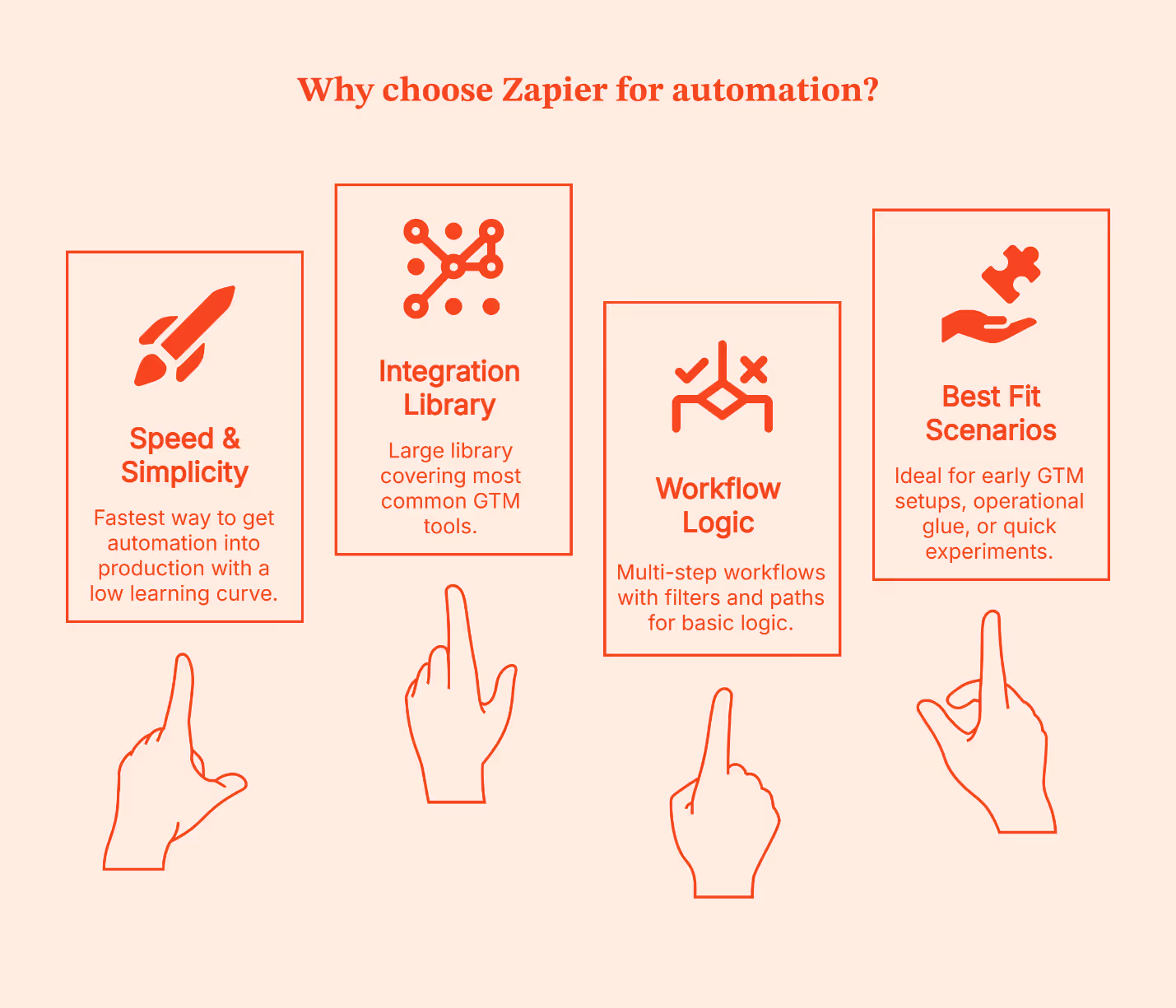
I’ve seen Zapier work best in two situations:
- Early-stage teams that want momentum, and
- Established teams that are testing new ideas.
It’s especially useful for proving whether a workflow is worth investing in before involving engineering or committing to a more complex system.
The disadvantage is the same as that of a driverless car.
- You get speed and convenience, but limited control.
- Once workflows grow deeper, volumes increase, or logic starts to resemble a decision tree, Zapier feels restrictive.
When to Use Make (Balance of power and usability)
If Zapier is a driverless, pre-programmed car, Make is like driving yourself with dynamic GPS and extra controls on the dashboard. You’re still moving at a good clip, but now you can take smarter turns, handle detours, and adjust mid-route without needing a mechanic. Ideal for teams that still want visibility and speed but also want to choose the route.
Make gives you a visual workflow canvas where you can see how data flows, plug in conditions, branch paths, and bring different tools together with clarity. It still avoids full coding, but it doesn’t force you into oversimplified logic either.
Make is preferred by GTM teams that want control without taking on full engineering complexity. If your workflows need more than a straight line – like lookup checks, enrichment steps, conditional assignments, or parallel actions – Make lets you build those in a way that’s easier to reason about.
It also brings some helpful, modern features into play:
- Visual builder with drag-and-drop logic: This lets you literally see each step of the journey
- Agentic automation: It can handle tasks with more autonomy (once rules are defined)
- AI-assisted steps: Useful for handling things like text manipulation or classification
- Prebuilt integration capabilities across GTM and analytics tools: Lets you weave them together without code
- Modular architectures: It makes scaling workflows less messy (like reusable subflows)
Why teams prefer it
- More control than basic automation tools, without needing a developer for every change
- Clear visual flow that helps teams understand and debug logic
- Strong support for branching, iteration, and table-style data operations
Where it fits best
- Workflows with conditional paths and multi-step logic
- Routing and enrichment sequences that require decisions mid-flow
- Ops teams that want visibility into how data moves and transforms

I’ve seen Make become a go-to choice for teams when Zapier starts feeling like a good start but not a long-term solution. Make gives you more control than basic no-code tools, but doesn’t demand full engineering ownership. If your team wants power without committing to building and maintaining everything from scratch, this is often the right balance.
Simply put: Make is your BFF if your routing moves beyond ‘if this then that,’ to ‘if this, do X; if that, do something else; and log everything along the way.’ This is usually the ceiling for non-technical ops teams before engineering needs to step in.
When to Use n8n (Best for custom, scalable, and self-hosted workflows)
Forget about pre-programmed cars or even driving a car yourself. With n8n, you build your own vehicle from the ground up. You get to choose the engine, the route system, and how it all runs. It gives you full ownership over how your automation works, how it’s hosted, and how far it can scale.
n8n works best once your GTM workflows go beyond basic tool connections. It gives you the control to reshape data, add complex and detailed logic, build custom integrations, or control how and where automations run. You don’t opt for n8n because it’s simple. You choose it when you want complete control to handle complexity on your own terms.
Here’s what n8n brings to the table:
- Low-code workflow builder: It lets you script logic when visual tools aren’t enough
- Native support for custom integrations: It lets you connect directly to APIs when ready-made connectors don’t exist or don’t go far enough
- Self-hosting options: You control where data lives and how it’s managed, great for compliance, sensitive data, and internal systems
- Advanced data transformation logic: Lets you handle loops, branches, and complex flows without creative workarounds
- Execution control and error handling: Let's you retry, audit, and manage workflows as systems, not one-off tasks
Why teams choose n8n
- Full control over complex workflows beyond basic connectors
- Ability to write and customize logic when visual tools fall short
- Self-hosting for data privacy, compliance, and cost control
- Support for building custom integrations that don’t exist out-of-the-box
- Designed for automation that runs as core infrastructure, not a side tool
- Built for teams that care about reliability, scale, and execution control
Where it fits best
- High-volume workflows that run day in and day out
- Custom GTM pipelines that link internal systems, warehouses, CRM, CMS, analytics, and activation systems
- Teams with engineering capacity or dedicated Go-to-Market engineers who can maintain and evolve these workflows
- Setups where data privacy, hosting control, and compliance matter
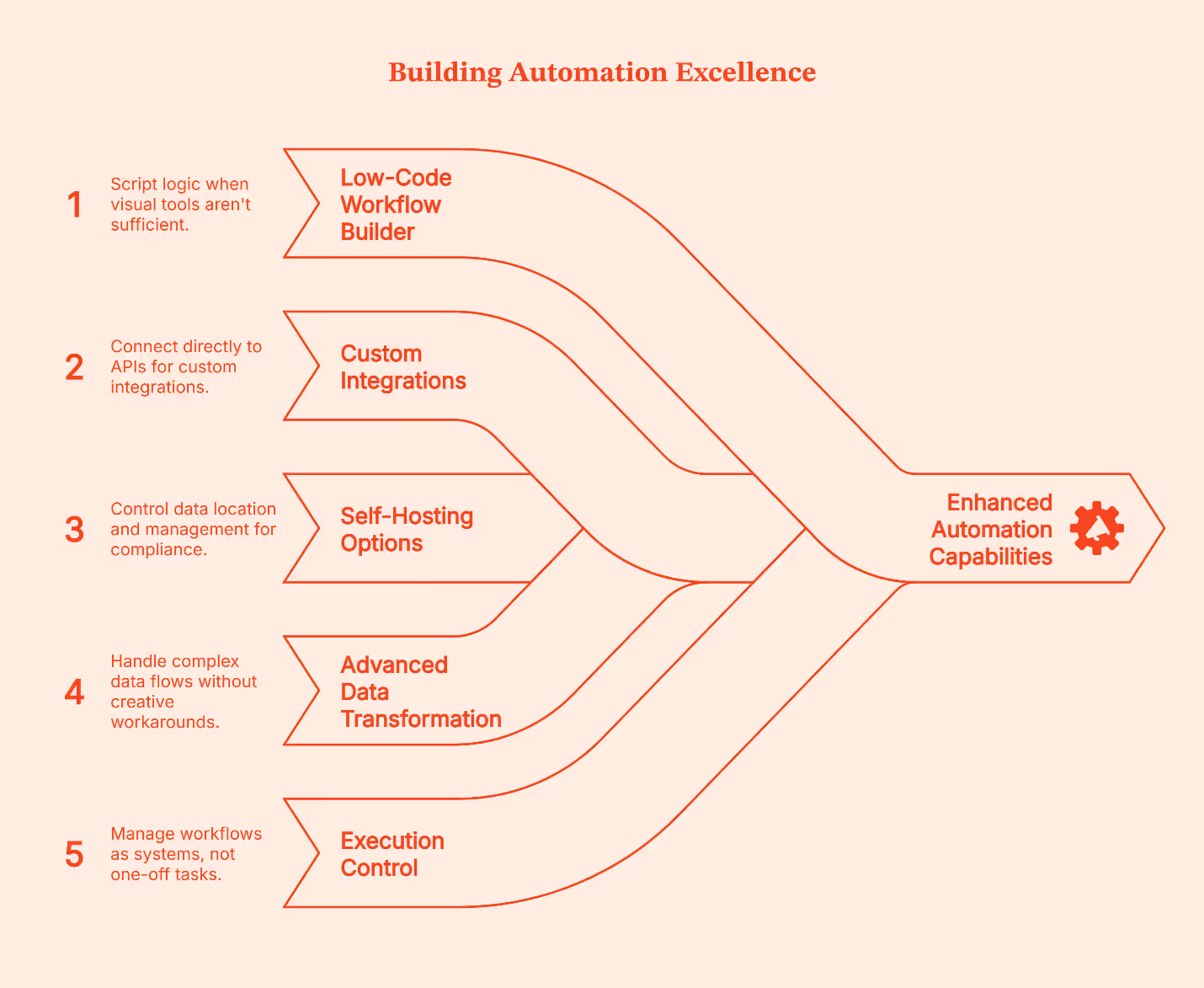
Self-hosting is often the deciding factor here:
- Usually, cloud-hosting is enough, but for teams dealing with sensitive data, stricter compliance requirements, and owning where data lives (which means better control, less convenience), self-hosting is the only choice.
- You’re in charge of uptime, security, and maintenance.
The tradeoff is also obvious:
- You get power and control, but you also own the vehicle. You’re responsible for infra, updates, and reliability.
- It matters less who can use it on day one and more who can maintain it six months later, especially given the steeper learning curve.
For teams with the skill and appetite for that level of ownership, it’s often worth it.
GTM Engineering Workflow Examples (What these tools are actually used for)
Instead of talking about these automation platforms in abstract terms, it helps to see how teams use them practically in the real world.
A Zapier-style workflow
Let’s say a lead submits a form. This is how a typical Zapier workflow handles it:
- Step 1: Zapier creates or updates the contact in the CRM.
- Step 2: The same trigger sends a transactional or welcome email.
- Step 3: The contact is tagged or logged for reporting.
- Step 4: The workflow is completed.
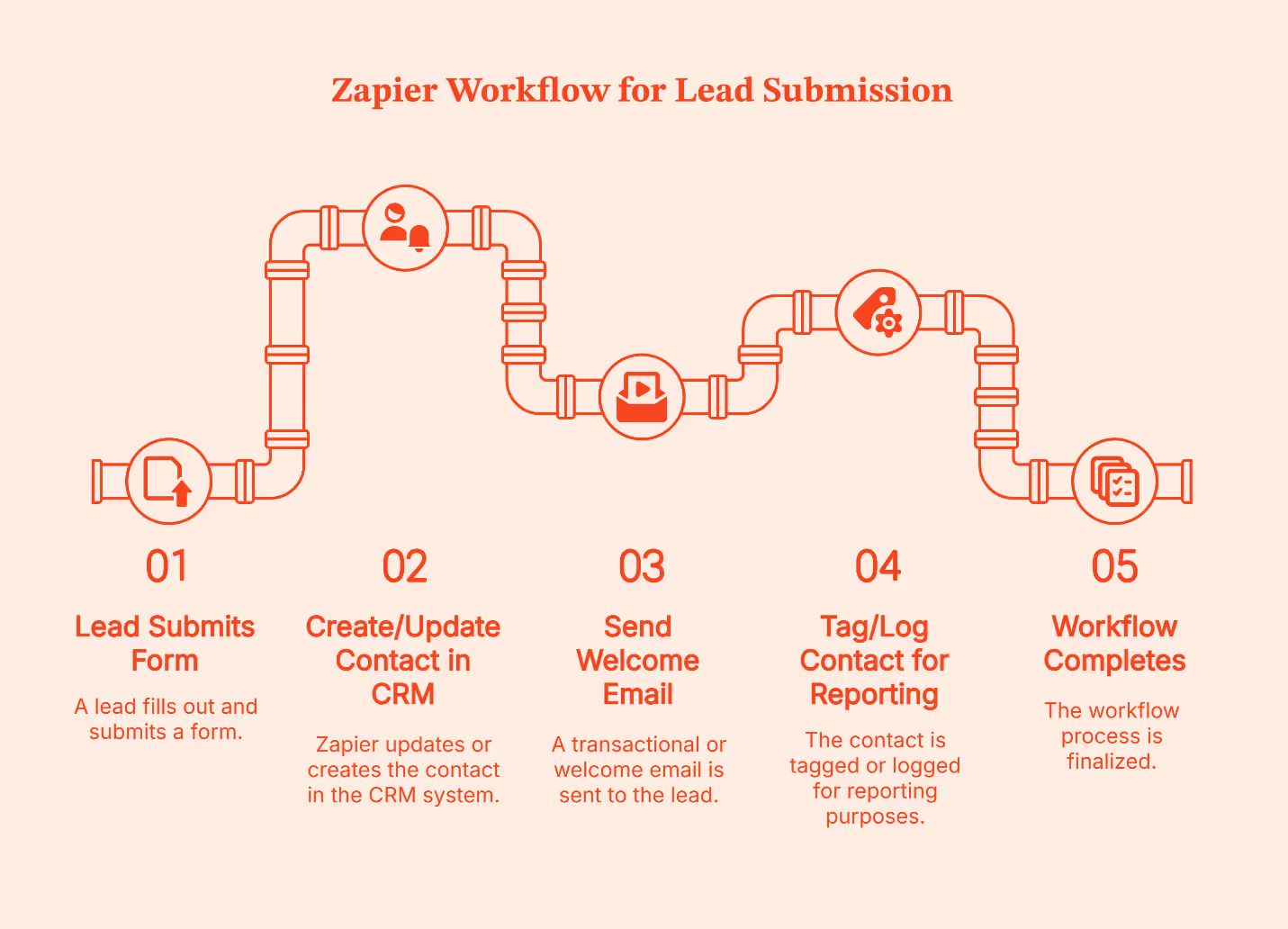
Zapier treats this like a lightweight pipe. Data enters at one end, flows through a few clear steps, and exits at the other.
If something goes wrong, say the CRM step fails or an email tool times out, the usual response isn’t to build elaborate recovery logic. Instead, teams open the Zap, fix the step, and re-enable it. The pipe gets adjusted, and the flow resumes.
That’s how Zapier is designed. It’s a trade-off Zapier makes intentionally to keep setup fast and workflows easy to maintain.
A Make-style workflow
Let’s take the same example: a new lead submits a form.
Here’s how that typically looks in Make:
- Step 1: The form submission creates or updates a CRM record.
- Step 2: That record moves to an enrichment step inside the same pipeline.
- Step 3: The returned data is evaluated before anything else happens.
- Step 4: The workflow branches based on what it finds.
- If required fields are present, the lead is scored or routed to sales.
- If data is missing or incomplete, the lead is held back or sent down a different path.
- Step 5: Notifications fire only after these checks are complete.
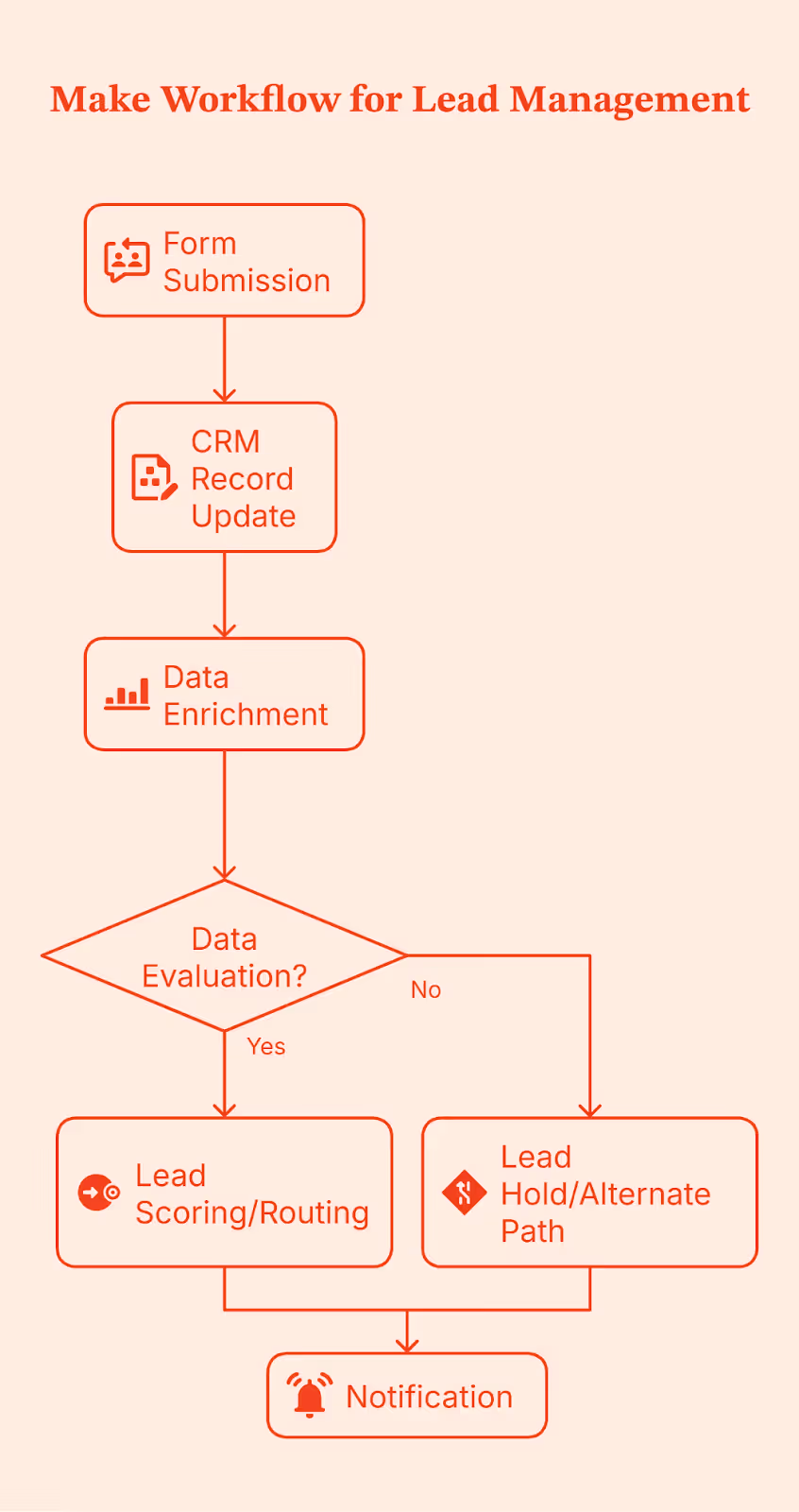
Notice the difference in execution control? Make doesn’t just move data from one place to another; it gives teams control over branching, filtering, and transformation logic before data is routed downstream.
Because this logic is modeled visually, it’s easier to see where things break, adjust conditions, and handle edge cases without rewriting the entire workflow. This becomes especially valuable as volume increases and sales cycles grow more complex, making data quality issues harder to ignore.
An n8n-style workflow
When you use n8n, you design the full workflow in advance.
That includes:
- What triggers the workflow (a form submission, webhook, schedule, etc.)?
- Every validation, check, branch, retry, and fallback
- What happens when something fails halfway through?
- Where is the data written, and when should it NOT be written?
- How is the execution state handled?
In most setups, this workflow is also self-hosted, so the team controls where it runs, how it’s monitored, and how execution is handled.
Once this is designed and deployed, every time a lead submits a form, n8n runs that exact flow from top to bottom.
Let’s use the same form submission as an example.
- Step 1: A lead submits a form, which triggers the workflow.
- Step 2: The incoming data is validated and normalized. Required fields are checked. Formats are cleaned.
- Step 3: Enrichment runs, often across multiple sources, with explicit handling for missing or partial data.
- Step 4: The workflow evaluates outcomes.
- If enrichment succeeds, the lead moves forward.
- If not, it follows a defined fallback path instead of blindly continuing.
- Step 5: Updates are written deliberately to one or more systems, such as a CRM and an internal database, only after upstream checks pass.
- Step 6: Execution state is tracked so failures can retry or resume instead of restarting the entire flow.
- Step 7: Notifications and analytics updates take place at the end, once the system knows the workflow was completed correctly.
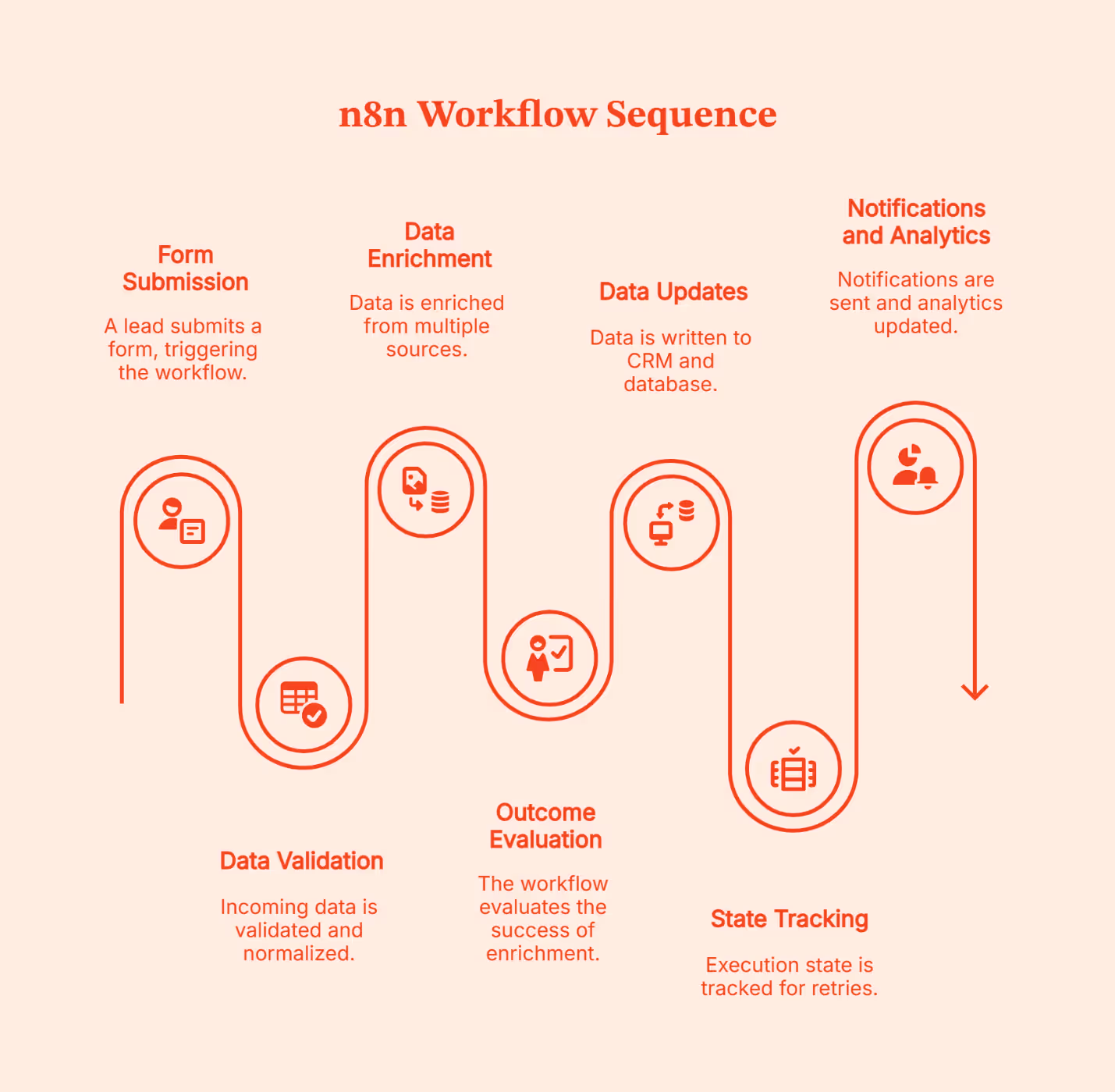
The complexity of the design is a chosen tradeoff for intentional control. That’s why n8n workflows are better known as infrastructures instead of automations.
Decision Matrix: How to Choose the Right Automation Layer for Your B2B Marketing Stack
A quick reminder: Most teams don’t stick with one tool forever or switch automation overnight. Instead, the common practice is to layer them. Simple workflows stay where they already work; New or more complex ones get built elsewhere. Ideally, teams pilot tools using free or low-cost tiers, identify where friction arises, and standardize only after patterns are clear. Hybrid setups make the most sense and are usually the most practical way to evolve GTM systems without breaking what already works.
Implementation and Governance Tips for GTM Automation
GTM issues arise from unclear ownership, undocumented workflows, and changes no one remembers making. Following a structured framework upfront to avoid these issues saves a lot of clean-ups later.
Here’s how to put GTM automation in place without losing control as things scale.
<Add a line here saying here are the tips for doing XYZ>
- Start with naming and documentation
Name workflows like you’re explaining them to someone new on day one. Add a short note on what triggers them, which systems they touch, and what ‘done’ actually means. Once workflows span CRM, enrichment, ads, and internal tools, memory stops working.
- Be clear about ownership
One person building everything doesn’t work at scale. But neither does letting everyone create automations on their own. Assign clear ownership and define key responsibilities about who can build workflows, who checks changes, and who fixes things when something breaks. This matters even more when you’re using both cloud tools and self-hosted systems.
- Version and test before changing live flows
GTM workflows age fast. When something needs updating, don’t tweak it live. Clone it. Test it with sample data. Then roll it out. Treat changes like system updates, not quick edits made in a hurry.
- Keep an eye on cost and usage
It is easy to lose sight of rising automation costs. Keep an eye on how often workflows run, how many steps they execute, and which ones drive most of the usage. It helps you control spend and design smarter flows early.
- Audit data flows regularly
Know where data enters, where it’s transformed, and where it ends up. This is especially important if you handle sensitive data or self-host anything. A simple check every few months saves bigger problems later.
FAQs for Zapier vs Make vs n8n
Q. Is a no-code tool like Zapier enough for enterprise-level GTM workflows?
It can work for simple, well-defined workflows, but most enterprise teams outgrow it as volume, logic, and data control needs increase.
Q. When does it make sense to self-host with n8n instead of using cloud-hosted Zapier or Make?
Self-hosting makes sense when data control, compliance, or cost at high volume matters more than setup convenience.
Q. How steep is the learning curve for Make compared to n8n or Zapier?
Zapier is the easiest, Make takes some learning but stays visual, and n8n usually requires technical comfort or engineering support.
Q. Can we start with Zapier and migrate to n8n later without too much disruption?
Yes. Most teams don’t migrate everything at once. They keep simple workflows on Zapier and move complex ones gradually.
Q. What are the typical cost implications as workflows scale?
Zapier charges per task, Make charges per operation, and n8n charges per execution or infrastructure, which changes the math at scale.
Q. Which tool handles complex branching and arrays better?
Make is strong with visual branching and iterators, n8n handles complex logic and error paths well, and Zapier relies on Paths or Code for advanced cases.
Q. Which is cheaper at scale for GTM workflows?
Self-hosted n8n is usually cheapest at high volume, while Zapier and Make are easier early but cost more as usage grows.
%20(1).avif)
Will AI Replace Digital Marketers? What’s Actually Changing (and What Isn’t)
At some point last year, AI went from ‘interesting experiment’ to ‘coworker who never sleeps.’
Now, my colleagues and even friends outside of work are asking me, “Will AI replace digital marketers?”
The right AI tools can now write blog posts, create ad copy, study campaign performance, and suggest optimization tactics….faster than it would take most humans to make their morning coffee.
So, it’s natural to wonder if you’re still employed. After all, what does your company need you for, if it has AI? This question plagues marketing Slack groups, Reddit threads, conference side conversations, and early-career marketers asking me if they should pivot now before it’s too late.
Let’s answer this question, then.
This piece will take a grounded look at what AI can actually do, what it can’t do, and how digital marketing jobs are evolving rather than disappearing with AI engines popping up everywhere.
TL;DR:
- AI is great at doing the work. Humans still need to decide what work is worth doing in the first place.
- The pressure from AI is highest on execution-heavy roles, while marketers who own strategy and results are much harder to replace.
- Using AI isn’t the edge; having the judgment to challenge or ignore it when necessary is.
- Marketing is shifting priorities from channel management to systems, impact, and revenue responsibility.
- The marketers who win use AI to cut busywork and spend more time making decisions that actually move the business.
Why AI feels threatening to digital marketers
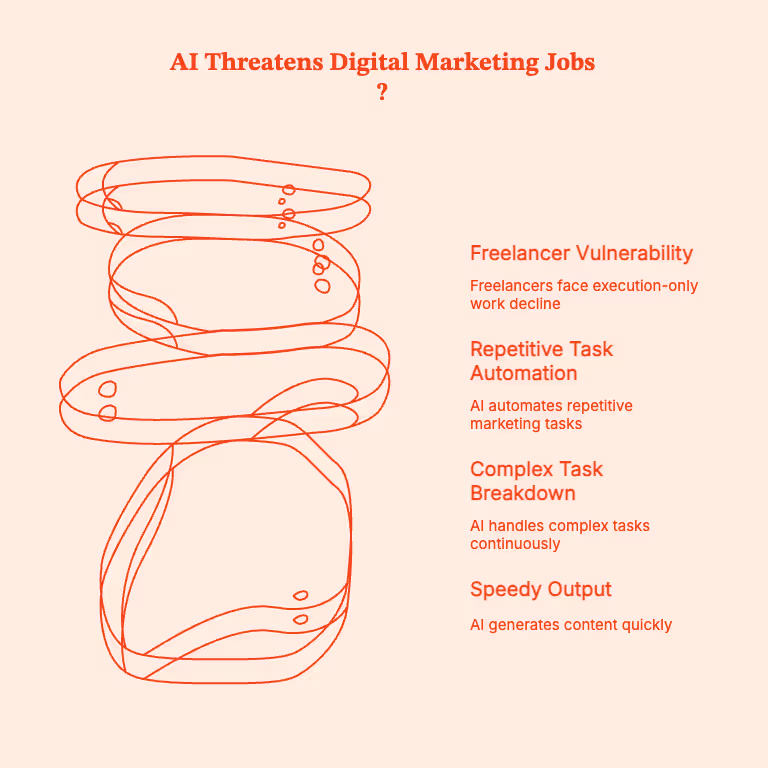
The fear around AI-generated content and marketing tasks, especially via generative AI, is not entirely irrational.
After all, digital marketing rewards speed in output and execution. The more content you publish, the more campaigns you launch, the cleaner your reports for the next person, the more value you bring to the table.
AI engines operate in seconds, work without rest, and if trained appropriately, can break down complex tasks.
Marketers are bound to feel insecure about their jobs when an AI tool can generate 30 ad variations, draft a blog post, cluster keywords, and summarize performance. If you look at Reddit communities like r/marketing, r/SEO, and r/PPC, you'll see that early-career marketers feel the most exposed.
Freelancers doing execution-only work are worried, and roles involving ‘set it and forget it’ workflows are dwindling.
So, if your job involves pulling unimportant reports, setting up garden-variety campaigns, and repetitive SEO/paid media tasks, you might have to worry about AI.
If not, you're fine. You're not obsolete. You're just going to work with AI since you certainly can't outdo it on its own turf.
What AI tools cannot replace in your digital marketing job
Let's go beyond vague arguments (“humans are creative!”) and dramatic exclamations (“AI will never understand emotion!”).
The truth is far more practical.
AI struggles with judgment under uncertainty, and this is a skill without which no business value can exist. You can leverage AI tools to create options for ad campaigns, data analysis, and get rid of repetitive tasks.
But it is the human's job to choose the right option and tell AI specifically what it needs to do.
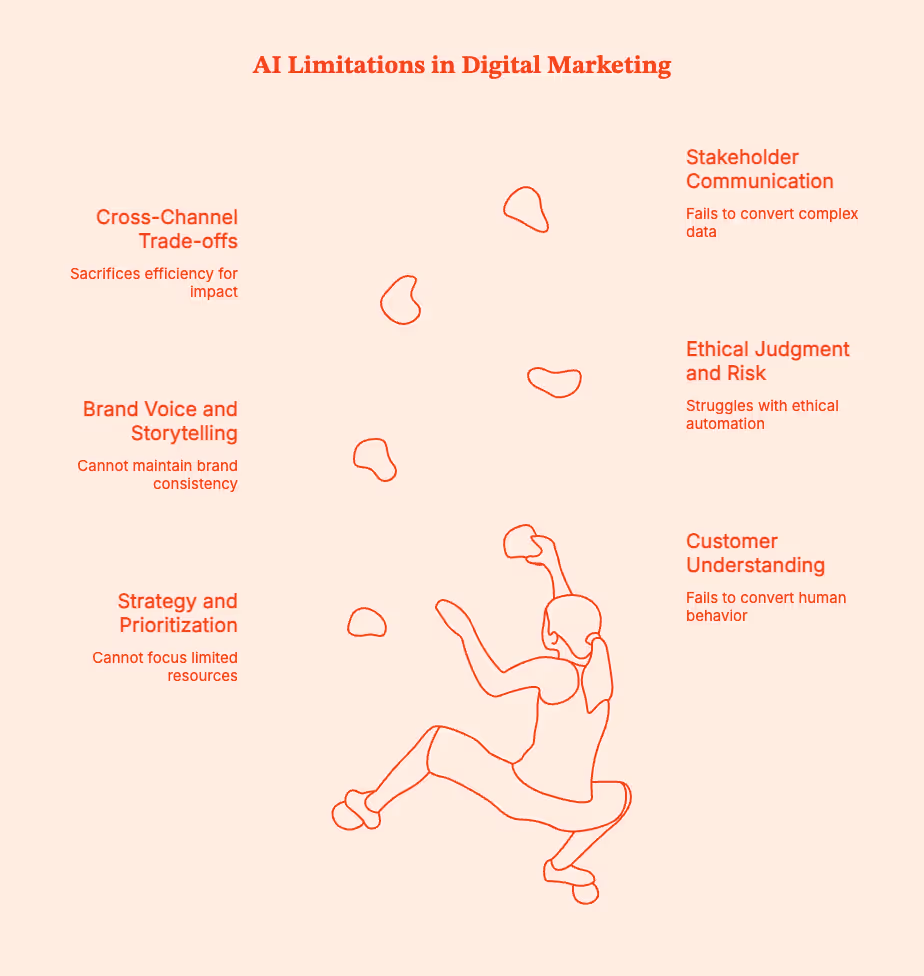
Here's what you can't expect AI to do, and what humans in marketing teams will always do:
- Strategy and prioritization: Where do you focus your limited time, budget, and brain power?
- Customer understanding: How do you convert messy, qualitative human behavior into meaningful action?
- Brand voice and storytelling: How do you know what strategy/content/communication fits, what feels off, and what erodes customer trust?
- Ethical judgment and risk management: How does AI decide what actions are ethical when automation moves faster than oversight?
- Cross-channel trade-offs: When do you sacrifice efficiency for long-term impact?
- Stakeholder communication: How do you convert complex performance data into decisions people will actually support?
AI can tell you what is happening, but it can't tell you which decisions are actually right. It can't, for instance:
- Decide which market is worth betting on.
- What not to automate to avoid putting the budget and teams under unnecessary pressure.
- Gauge when technically correct data is still contextually misleading.
- Explain results to a stakeholder who wants to see real trade-offs instead of dashboards they don't understand.
- Understand why a campaign might have delivered numbers on paper but damaged customer trust.
AI can give you a list of events, but it isn't great at telling you which accounts are warming up or where to double down. Factors.ai will bridge that gap by showing account-level intent and engagement across the buyer journey. Using these signals, marketers can prioritize, align with sales, and defend decisions with evidence instead of "gut feel".
Which digital marketing roles are most affected by Artificial Intelligence?
AI can replace task profiles, rather than entire jobs. However, any roles built on tasks that are easy to automate are at stake.
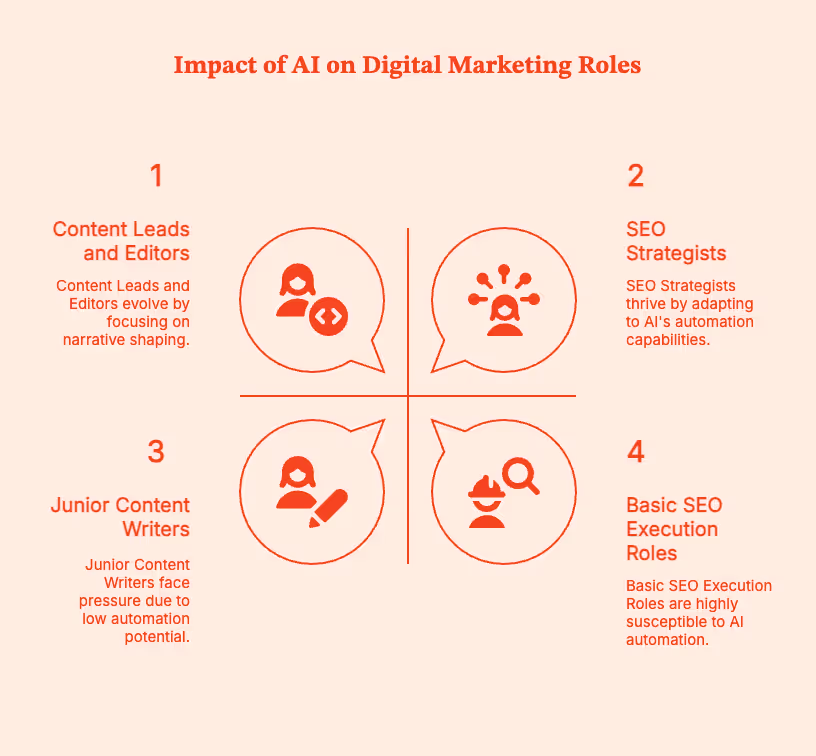
Roles under the most pressure
The following roles are shrinking or at least being redefined:
- Junior content writers focused on volume: If your value = how many words you publish, AI will turn that equation on its head. We don't need more first drafts; we need judgment.
- Basic SEO execution roles: AI can take over keyword research, clustering, on-page checks, and audits. You have to decide what it should do and when.
- Media buyers running setup and optimization tweaks: AI platforms can handle bids, budgets, and targeting better than most humans.
- Analysts who only pull reports: AI can create dashboards, but not provide insights. If your job ends at ‘here’s the data,’ AI has you beat.
Roles that are evolving
As certain roles shrink, others are gaining leverage:
- SEO strategists who map content to user intent and business goals.
- Performance and growth marketers who focus on experiments and innovations.
- Content leads and editors who shape narratives and standards to maintain user trust.
- Marketing ops and RevOps professionals who build systems, attribution, and data flows.
- Demand gen leaders who deal with pipeline velocity and pressure without compromising long-term growth.
What's changing is the need for manual execution. AI can take over that, but it cannot be trusted with system and process design. It also cannot hold itself accountable for business outcomes; that's on you.
Will digital marketing be replaced or reshaped by AI?
No, digital marketing will not be replaced by AI. But it will be fundamentally reshaped.
Spreadsheets didn’t eliminate finance teams, marketing automation didn’t kill email marketers, and Google Analytics didn’t replace analysts.
Technology just raised the bar.
AI is in the same vein. It is becoming a fixture in marketing stacks because it removes friction around execution.
It’s becoming a baseline capability, not a differentiator. Not because it replaces thinking, but because it removes friction around execution. It replaces manual effort, slow iteration, and useless busywork.
AI does not replace judgment, strategy, taste, and accountability.
AI will make digital marketing more strategic, more technical, and more outcome-driven. That's an upgrade.
How digital marketers can stay relevant in an AI-driven future
Let's be clear: AI doesn't create winners and losers on its own. It amplifies what you're already bringing.
So, if your value lies in your judgment, AI makes you better at your job. But if your primary task is manual execution, AI will replace you.

Here's how marketers can improve their tasks with AI:
- Go beyond prompts; understand the system
How well you can use AI depends on:
- The data on which the AI tool has been trained.
- Whether the AI engine hallucinates or oversimplifies its responses.
- Which specific problems is it good at solving, and which it fails at.
- Shift focus from outputs to outcomes
AI can generate content variations, dashboards, and recommendations. It can analyze data and recommend tactics to future-proof campaigns and the marketing industry.
But AI technology cannot decide how to take the business forward.
To stay relevant, consider focusing less on the volume of output and more on:
- What problem are you solving
- What trade-offs are you making to solve the problem at hand
- Think in systems, not channels
AI fundamentally accelerates and reduces the cost of execution. System-first thinking helps make better decisions.
To stay resilient in an AI-heavy job market, take the time to understand:
- How acquisition maps to retention
- How GTM motion influences each channel's performance
- How attribution models influence account intelligence and behavior
AI can optimize certain components of the machine, but humans still have to design it.
- Maintain some skepticism toward AI outputs
A very important part of your AI expertise is disagreeing with your AI systems and tools. Learn how to frequently:
- Question recommendations that may look right, but clearly aren't answering the question.
- Flag data that is technically accurate but will derail strategy.
- Prioritize context more than technical accuracy (when required).
- Explain decisions to leadership without hiding behind dashboards.
- Build cross-functional fluency
To stay relevant as a marketer who will also embrace AI, stay on top of these:
- Get context on revenue forecasting from sales teams.
- Talk trade-offs with product teams.
- Help design processes and pipelines with Ops teams.
- When explaining decisions to leadership, use your words instead of just fancy dashboards.
AI does not replace judgment, but it does expose those who never had any. Don't be one of them.
What leaders and teams should get right about AI in marketing
Folks managing a marketing agency or team are inevitably reeling (at least a little bit) with the emergence of AI EVERYWHERE (or so it seems).
The questions and decisions are endless: Do you need fewer people? Different people? More tools? Fewer tools? What happens if you automate too fast or not fast enough?
But AI doesn't eliminate employee count overnight. It just reprioritizes where human effort is really needed.
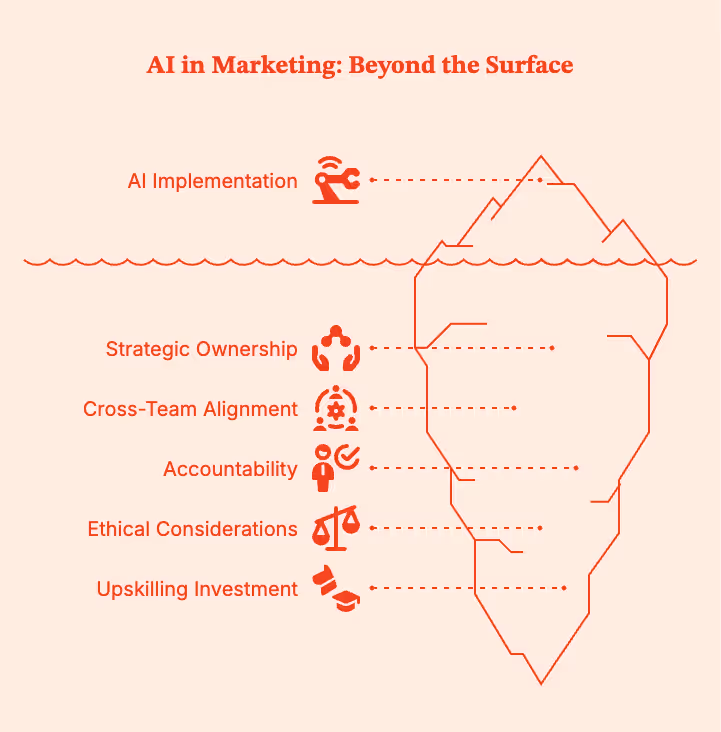
- AI is not a headcount shortcut
AI can reduce manual workload, but it cannot replace strategic ownership, cross-team alignment, and accountability. If you try to ‘do more with less’, you will probably end up:
- Shipping more content, but it might perform terribly.
- Automating processes no one fully understands.
- Losing out on brand credibility and customer trust.
- Burning out the few people who are still there to manage the system.
- The downsides of over-automation
AI can certainly optimize the metrics it has been given, but it won't do too well at understanding what you actually mean when you say ‘get a sense of what people really want based on these conversations’. It'll give you bullet points, but it cannot make educated judgments based on vocal cadence, commonly used regional phrases, and so on.
If you over-automate with AI programs and treat AI as a substitute for the real human mind, expect that:
- Your brand voice will be diluted.
- You'll see hikes in short-term, volume-based metrics and then a steep drop in long-term quality.
- You won't have real explanations for why something worked or failed, because AI decisions are not visible from the backend.
All digital tools should only support judgment, not replace it.
- Human ownership is irreplaceable
No tool, however advanced, will replace the human insight needed for decision making, risk, and accountability. Only humans can:
- Decide what success looks like.
- Where to focus limited efforts and budget.
- Understand ethical and compliance pressures.
- Own outcomes without using tools or models as excuses.
- Invest in upskilling
Don't panic. Just figure out how to get AI to work for you.
Some quick ideas:
- Train your teams to gauge the veracity of AI outputs. No blind trust.
- Redesign the role around system building and strategy, not just output volume.
- Make AI literacy a part of performance KPIs.
- Give people time to learn. No one learns overnight.
- Assign clear ownership
AI without ownership is a massive risk. With failure, every AI-driven workflow should have a clear human owner, established and non-negotiable guardrails, and a human decision maker who is also accountable for all outcomes.
"The tool did it" is not an acceptable answer to stakeholders, customers, or regulators.
Note: Evaluating AI utility requires examining multiple metrics across various channels. You can't be spending time manually gathering all that data (and also keep your job). Instead, a tool like Factors.ai can help by pulling website engagement, ad interactions, CRM data, and third-party intent into a single view. That means you can stop guessing which activities are meaningful and start acting on signals that directly drive revenue.
The Future is AI-powered marketers, not AI replacing marketers
Set aside the hype and scare tactics. The truth is that AI will absolutely change how marketing tasks are done.
Some roles will narrow in scope or disappear. Others will expand and become more valued.
Entirely new roles will emerge.
But digital marketers will not disappear. They will become (if they want to keep their job and grow) more strategic, technical, and accountable.
They will own decision-making while AI reduces the distance between insight and action.
Teams have to (and already are) recalibrating by pushing marketers to think in terms of systems and strategy. Less “optimize this channel,” more “explain how this contributes to pipeline, revenue, and growth."
To see how AI can actually make you a better digital marketer, consider booking a demo for Factors.ai.
The tool will clearly show you which accounts are engaging, what signals actually matter, and how marketing influences revenue, so you can stay ahead by shifting the conversation from output to outcomes.
Summary
AI isn’t replacing digital marketers.
It is replacing the parts of the job that were always closer to execution than strategy. AI tools can write content, optimize ads, analyze performance, and automate workflows.
Basically AI is reshaping digital marketing.
AI is set to take over speed, scale, and pattern recognition. It will be drafting, testing, forecasting, and surfacing insights across massive datasets. But it cannot decide what matters, what to prioritize, or what trade-offs to make. That lies on humans.
Task-heavy roles focused on execution feel the pressure of AI first. Strategic roles are gaining leverage. Junior marketers, freelancers, and “set-it-and-forget-it” positions are evolving, while marketers who prioritize systems, outcomes, and revenue impact are gaining value.
To stay relevant, marketers have to go beyond prompts and tools. They have to learn how AI works, question its outputs, think cross-functionally, and focus on judgment over volume. Managers need to resist panic, avoid over-automation, invest in upskilling, and maintain clear human ownership over direction, risk, and accountability.
AI isn’t replacing digital marketers. It’s giving us AI-powered marketers. These are the folks people who use to eliminate busywork and focus on the decisions that actually move the business forward.
Make no mistake, that is an upgrade.
Frequently Asked Questions about AI and Digital Marketing
Q.Will AI replace digital marketers completely?
Absolutely not. AI will replace specific marketing tasks, but cannot take over end-to-end marketing roles. Human marketers still have to set strategy, make trade-offs, understand customers, and take accountability for outcomes.
Q. Which marketing jobs are most at risk from AI?
The roles most at risk from AI are built around setup, repetitive execution, and low or no judgment. For instance, roles around junior content production, basic SEO execution, manual reporting, and media buying.
Q. Is digital marketing still a good career in the age of AI?
Yes, it is. But your digital marketing job will become more strategic and less execution-centered. Marketers will now need to focus on judgment, systems, and business impact.
Q. Will AI replace SEO specialists and content marketers?
AI can handle first drafts and data analysis. But it cannot replace strategic SEO or editorial evaluation. Human marketers still need to decide what to create, how it fits the brand, and how it supports business goals.
Q. Can one marketer with AI replace an entire team?
Only if they are okay with short-term gains at the cost of long-term quality and customer trust. AI can initially increase individual output...by a lot. But, over time, humans need to step in for strategy, quality control, cross-functional coordination, and accountability.
Q. What skills should digital marketers learn to stay relevant?
Take the time to invest in strategic and systems thinking, analytics interpretation, AI literacy, and cross-functional communication. These matter more than mastering any single tool. Your skill lies in the ability to evaluate and apply AI outputs critically.
Q. Is AI more of a threat to junior or senior marketers?
Junior marketers will feel the impact first because many entry-level tasks they do are easier to automate. Senior marketers who don’t adapt will also struggle as workflows and technical requirements change.
Q. How are companies actually using AI in marketing today?
Most marketing teams use AI to draft content, create copy variations, analyze performance, predict trends, and automate reporting. Not many organizations allow AI to make final decisions without human oversight.
Q. Will AI reduce marketing salaries or increase expectations?
In the short term, expectations are hiking faster than salaries. Over time, however, marketers skilled in pushing strategic impact and revenue clarity will command higher compensation.
Q. Is AI better suited for B2B or B2C marketing?
AI works great for both, but B2B teams will get more value faster because AI can excel in intent analysis, attribution, and revenue alignment. B2C teams can use AI for personalization, creative testing, and lifecycle optimization.
Q. What’s the biggest misconception about AI replacing marketing jobs?
That AI will take your job.
What it will take are the repetitive parts of your job. You still need to handle judgment, context, and accountability.


.svg)
